Paul Finch's Blog, page 8
July 29, 2020
A couple of snippets from ONE EYE OPEN
Yesterday, this happened …
Hopefully, that video speaks for itself, but in a nutshell, advance copies of my next novel, ONE EYE OPEN , arrived at our pad, which was something of an unexpected pleasure. It will also give me the opportunity to read a couple of choice snippets for you all … which I’m going to do very shortly in this post.
Before we get onto that, I should also mention that today I’ll also be reviewing and discussing the claustrophobically chilling (and all-round excellent) psycho-thriller, THE RESIDENT, by David Jackson.
As always with my book reviews, you’ll be able to find that at the lower end of today’s post. But if you don’t like reading reviews before you’ve read the books yourself, I still urge you to get hold of this one. Jackson is a high-quality thriller writer, and THE RESIDENT is knife-edge stuff all the way through. As I say, my full review is at the bottom end of today’s post, in the Thrillers, Chillers section.
However, if you’ve got a bit of spare time first, why not check out …
One Eye Open
As you’re probably sick of me saying by now, ONE EYE OPEN is my first book for Orion, and it’s a stand alone crime thriller, which pitches an Essex Traffic officer into a world of robbery, double-dealing and murder.
 As promised, I’ll shortly be reading a couple of clips from the finished book.
As promised, I’ll shortly be reading a couple of clips from the finished book.
But before then, for your delectation (and my complete and shameless self-aggrandisement), here is the back-cover blurb, followed by a short handful of quotes from the 25 NetGalley reviewers to thus far give it the big thumbs-up.
YOU CAN RUN
A high-speed crash leaves a man and woman clinging to life.Neither of them carries ID. Their car has fake number plates.In their luggage: a huge amount of cash.Who are they? What are they hiding?And what were they running from?
YOU CAN HIDE
DS Lynda Hagen, once a brilliant detective, gave it all up to raise her family.But something about this case reignites a spark in her...
BUT YOU'LL ALWAYS SLEEP WITH ...
What begins as an investigation soon becomes an obsession.And it will lead her to a secret so dangerous that soon there will be nowhere left to hide.
ONE EYE OPEN ‘I absolutely loved this stand alone masterpiece’. – Beverley S.
‘Fast paced action, dramatic shootouts and an overwhelming sense of threat’. – Jen L.
‘A rich police thriller from an author who always gives a great insight to the world of criminals and the police who go after them’. – Pat C.
‘Breathtaking, shocking and dark!’ – Samantha L.
And now, while my head shrinks back to its normal size, here are a couple of short(ish) readings from the book, provided by yours truly.
In this first one, it’s a cold winter’s day as DS Lynda Hagen pursues a potential witness to a crime into an abandoned holiday park …
In this second one, ex-racing driver, Elliot Wade, finds himself in a fast car with two shady characters, and a lot to prove …
Okay, hope you guys enjoyed those. As I say, ONE EYE OPEN is available for purchase from August 20 in all your usual outlets. Hope you’re interested enough to take a punt.
THRILLERS, CHILLERS, SHOCKERS AND KILLERS …
An ongoing series of reviews of dark fiction (crime, thriller, horror and sci-fi) – both old and new – that I have recently read and enjoyed. I’ll endeavour to keep the SPOILERS to a minimum; there will certainly be no given-away denouements or exposed twists-in-the-tail, but by the definition of the word ‘review’, I’m going to be talking about these books in more than just thumbnail detail, extolling the aspects that I particularly enjoyed (I’ll outline the plot first, and follow it with my opinions) … so I guess if you’d rather not know anything at all about these pieces of work in advance of reading them yourself, then these particular posts will not be your thing.
 THE RESIDENT by David Jackson (2020)
THE RESIDENT by David Jackson (2020)
OutlineSchizophrenic serial killer, Brogan, his hands still red with the blood of his latest victims, is on the run from the police in the heart of an urban sprawl. But when all avenues of escape seem to be closed to him, he seeks refuge in the empty end-house of a rather run-down terraced row. Unexpectedly, this doesn’t just give him the ability to lie low, because when he investigates the property thoroughly, forcing his way up into the loft, he finds that the dividing wall between this and the next property is incomplete, along with the next dividing wall after that, and the next one and so on.
In short, Brogan finds that he can access all the houses on this side of the street without the official occupants even knowing that he is there … so long as they don’t come up into their attics.
With a jolt of intoxicating pleasure, it slowly dawns on the killer, who never plans very far ahead, that this empty house can be much more than just a useful hiding place.
The problem is that his mind is divided neatly in two, one half more conciliatory but still unstable, callous and inclined to a sexual enjoyment of violence, the other half clever, scheming and sadistic. Occasionally, these two distinct personalities, who occupy Brogan’s head both at the same time, fall out with each other, but mostly they exist in a state of symbiosis, and they are completely in sync when it comes to the way that Brogan should be spending the next few days. Because not only can he creep down into the houses when their owners are out, feed himself and rummage around among private possessions in order to steal, he can also learn all there is about his new hosts, and start to play games with them, alternately antagonising them, making fun of them, frightening them, setting them against each other, the outcomes of which he can watch from the safety of the loft space overhead.
And it’s not as if there isn’t plenty of material for him to work with. Eighty-year-old Elsie is one occupant, an elderly lady who lives alone and is now suffering from mild dementia. Carers visit from time to time, but mostly she is vulnerable and very easily played with.
Then there is Jack and Pam, a middle-aged couple who clearly love each other even though they squabble like cat and dog, and blame each other whenever anything goes wrong (and are out a lot of the time, their property left ripe for plundering); they too make easy targets for manipulation.
Last but very far from least, there is Collette and Martyn. This pair are of particular interest to Brogan, because they are only in their twenties, Collette beautiful and sweet and, Brogan suspects, a little sad.
What fun he is going to have with her in particular.
This is certainly one of the shortest synopses I’ve ever written for one of my online book reviews, quite simply because you’ve already got the crux of it, and to say more might give away vital spoilers.
Suffice to say that Brogan, the new unknown resident in the terraced row, is going to enjoy himself a great deal at the expense of his various unwitting hosts. But it isn’t going to go all his way. Anything can happen in the next few days, things he won’t be expecting at all, and while the situation is unlikely to end well for those who officially live here, it could easily go badly for him too …
Review The Resident is certainly not the first ‘hider in the house’ scenario I’ve encountered in crime and thriller fiction. I’m pretty sure there was even a movie called Hider in the House once. However, there is no idea these days that is original, and in any case, this is without doubt the most intense, dramatic, best-plotted and most enjoyable version of the grand old theme that I have ever read. It’s not a massive tome, coming in at just over 300 pages, but it literally flipped by because almost every one of its short, concise chapters ends on a cliff-hanger as taut as piano wire.
Brogan himself is a fascinating antagonist. We only get to learn about his many terrible crimes through the bizarre conversations that occur inside his head, which we hear in full, and which as well as being subtly informative both about him and his grotesque track-record, are also chilling in their depiction of criminal insanity, and at times wildly if darkly funny.
Yes, there are some comedic elements in this grim tale, but it’s not for the faint-hearted. I even had to stifle a snigger or two at the thought of Brogan, a mad killer, happily making himself at home in others people’s houses, cooking beans, buttering toast, stirring tea, while the actual occupants are out at work, though God knows, it would be an unspeakable invasion of privacy if it were to happen in real life.
You probably wouldn’t care as much for the characters wrapped up in this horror if you didn’t gradually come to see them so clearly, and this is another neat touch by David Jackson. When the killer first arrives in his improvised refuge, neither he nor we know anything at all about the population of this terraced row, but that’s okay, because we learn about them as Brogan does and at exactly the same pace, by listening to their interactions through trapdoors or watching them through peepholes in the ceiling.
While Jack and Pam are perhaps a little bit stock, Elsie is a wonderful creation. I can imagine that a veteran actress would have a lot of fun with this part in any screen adaptation. Her tragic situation, which you might expect to cast her as one of life’s forgotten victims and maybe a constant mope, is enlivened by the return of her maternal instincts (long buried, but always there) and the feistiness with which she treats her carers when she starts to suspect they are humouring her about the ‘return of her deceased son’.
The other stars of the show, though, are the final couple in the terraced row, Collette and Martyn, though Collette is the more important of the two, at least where Brogan is concerned.
In classic ‘beauty and the beast’ fashion, Brogan doesn’t just desire her physically; the more he gets to know about her, the more he subconsciously likes her, and the more he starts to think of her as a potential companion rather than a victim. In concert with this, the more he starts to distrust and finally hate her husband, Martyn, which developing ménage à trois gives us some of the most intense and emotionally dramatic sequences in the book.
But all the thrills and chills aside, in a relatively quickfire piece of writing, David Jackson has created several such exceptional dynamics, which crank the readability of The Resident up to top notch. You really feel for everyone, and really need to know what’s going to happen next.
Of course, getting back to Brogan and the terrible situation he has engineered and soon ends up trapped in – and this is the real heart of the story, the part that works so well for me – he may increasingly take Collette and Elsie’s side, he may view them both (but mainly Collette) as lost, abused and neglected, as a twosome who deserve so much more than life has dealt them, so it’s no wonder he sees himself reflected there. But this isn’t going to be reciprocated, because to the likes of Collette, Brogan will always be a monster. That’s the underlying darkness in this tale, and its cleverness. Though you live inside his head with him and get to know him well, though you even start to empathise a little … you never forget that Brogan is a monster.
Read The Resident . It’s a superb, fast-paced thriller, weaving multi-layered characters into a scenario from Hell that will have you both shuddering and snickering all the way through.
As always, I’m now going to try and cast this saga. Just a bit of fun – who would ask me? – but here are the main actors I would choose, were I putting this cracker on the screen:
Brogan – Max IronsCollette – Lupita Nyong’oElsie – Gemma Jones Martyn – Samuel Anderson
Hopefully, that video speaks for itself, but in a nutshell, advance copies of my next novel, ONE EYE OPEN , arrived at our pad, which was something of an unexpected pleasure. It will also give me the opportunity to read a couple of choice snippets for you all … which I’m going to do very shortly in this post.
Before we get onto that, I should also mention that today I’ll also be reviewing and discussing the claustrophobically chilling (and all-round excellent) psycho-thriller, THE RESIDENT, by David Jackson.
As always with my book reviews, you’ll be able to find that at the lower end of today’s post. But if you don’t like reading reviews before you’ve read the books yourself, I still urge you to get hold of this one. Jackson is a high-quality thriller writer, and THE RESIDENT is knife-edge stuff all the way through. As I say, my full review is at the bottom end of today’s post, in the Thrillers, Chillers section.
However, if you’ve got a bit of spare time first, why not check out …
One Eye Open
As you’re probably sick of me saying by now, ONE EYE OPEN is my first book for Orion, and it’s a stand alone crime thriller, which pitches an Essex Traffic officer into a world of robbery, double-dealing and murder.
 As promised, I’ll shortly be reading a couple of clips from the finished book.
As promised, I’ll shortly be reading a couple of clips from the finished book. But before then, for your delectation (and my complete and shameless self-aggrandisement), here is the back-cover blurb, followed by a short handful of quotes from the 25 NetGalley reviewers to thus far give it the big thumbs-up.
YOU CAN RUN
A high-speed crash leaves a man and woman clinging to life.Neither of them carries ID. Their car has fake number plates.In their luggage: a huge amount of cash.Who are they? What are they hiding?And what were they running from?
YOU CAN HIDE
DS Lynda Hagen, once a brilliant detective, gave it all up to raise her family.But something about this case reignites a spark in her...
BUT YOU'LL ALWAYS SLEEP WITH ...
What begins as an investigation soon becomes an obsession.And it will lead her to a secret so dangerous that soon there will be nowhere left to hide.
ONE EYE OPEN ‘I absolutely loved this stand alone masterpiece’. – Beverley S.
‘Fast paced action, dramatic shootouts and an overwhelming sense of threat’. – Jen L.
‘A rich police thriller from an author who always gives a great insight to the world of criminals and the police who go after them’. – Pat C.
‘Breathtaking, shocking and dark!’ – Samantha L.
And now, while my head shrinks back to its normal size, here are a couple of short(ish) readings from the book, provided by yours truly.
In this first one, it’s a cold winter’s day as DS Lynda Hagen pursues a potential witness to a crime into an abandoned holiday park …
In this second one, ex-racing driver, Elliot Wade, finds himself in a fast car with two shady characters, and a lot to prove …
Okay, hope you guys enjoyed those. As I say, ONE EYE OPEN is available for purchase from August 20 in all your usual outlets. Hope you’re interested enough to take a punt.
THRILLERS, CHILLERS, SHOCKERS AND KILLERS …
An ongoing series of reviews of dark fiction (crime, thriller, horror and sci-fi) – both old and new – that I have recently read and enjoyed. I’ll endeavour to keep the SPOILERS to a minimum; there will certainly be no given-away denouements or exposed twists-in-the-tail, but by the definition of the word ‘review’, I’m going to be talking about these books in more than just thumbnail detail, extolling the aspects that I particularly enjoyed (I’ll outline the plot first, and follow it with my opinions) … so I guess if you’d rather not know anything at all about these pieces of work in advance of reading them yourself, then these particular posts will not be your thing.
 THE RESIDENT by David Jackson (2020)
THE RESIDENT by David Jackson (2020)OutlineSchizophrenic serial killer, Brogan, his hands still red with the blood of his latest victims, is on the run from the police in the heart of an urban sprawl. But when all avenues of escape seem to be closed to him, he seeks refuge in the empty end-house of a rather run-down terraced row. Unexpectedly, this doesn’t just give him the ability to lie low, because when he investigates the property thoroughly, forcing his way up into the loft, he finds that the dividing wall between this and the next property is incomplete, along with the next dividing wall after that, and the next one and so on.
In short, Brogan finds that he can access all the houses on this side of the street without the official occupants even knowing that he is there … so long as they don’t come up into their attics.
With a jolt of intoxicating pleasure, it slowly dawns on the killer, who never plans very far ahead, that this empty house can be much more than just a useful hiding place.
The problem is that his mind is divided neatly in two, one half more conciliatory but still unstable, callous and inclined to a sexual enjoyment of violence, the other half clever, scheming and sadistic. Occasionally, these two distinct personalities, who occupy Brogan’s head both at the same time, fall out with each other, but mostly they exist in a state of symbiosis, and they are completely in sync when it comes to the way that Brogan should be spending the next few days. Because not only can he creep down into the houses when their owners are out, feed himself and rummage around among private possessions in order to steal, he can also learn all there is about his new hosts, and start to play games with them, alternately antagonising them, making fun of them, frightening them, setting them against each other, the outcomes of which he can watch from the safety of the loft space overhead.
And it’s not as if there isn’t plenty of material for him to work with. Eighty-year-old Elsie is one occupant, an elderly lady who lives alone and is now suffering from mild dementia. Carers visit from time to time, but mostly she is vulnerable and very easily played with.
Then there is Jack and Pam, a middle-aged couple who clearly love each other even though they squabble like cat and dog, and blame each other whenever anything goes wrong (and are out a lot of the time, their property left ripe for plundering); they too make easy targets for manipulation.
Last but very far from least, there is Collette and Martyn. This pair are of particular interest to Brogan, because they are only in their twenties, Collette beautiful and sweet and, Brogan suspects, a little sad.
What fun he is going to have with her in particular.
This is certainly one of the shortest synopses I’ve ever written for one of my online book reviews, quite simply because you’ve already got the crux of it, and to say more might give away vital spoilers.
Suffice to say that Brogan, the new unknown resident in the terraced row, is going to enjoy himself a great deal at the expense of his various unwitting hosts. But it isn’t going to go all his way. Anything can happen in the next few days, things he won’t be expecting at all, and while the situation is unlikely to end well for those who officially live here, it could easily go badly for him too …
Review The Resident is certainly not the first ‘hider in the house’ scenario I’ve encountered in crime and thriller fiction. I’m pretty sure there was even a movie called Hider in the House once. However, there is no idea these days that is original, and in any case, this is without doubt the most intense, dramatic, best-plotted and most enjoyable version of the grand old theme that I have ever read. It’s not a massive tome, coming in at just over 300 pages, but it literally flipped by because almost every one of its short, concise chapters ends on a cliff-hanger as taut as piano wire.
Brogan himself is a fascinating antagonist. We only get to learn about his many terrible crimes through the bizarre conversations that occur inside his head, which we hear in full, and which as well as being subtly informative both about him and his grotesque track-record, are also chilling in their depiction of criminal insanity, and at times wildly if darkly funny.
Yes, there are some comedic elements in this grim tale, but it’s not for the faint-hearted. I even had to stifle a snigger or two at the thought of Brogan, a mad killer, happily making himself at home in others people’s houses, cooking beans, buttering toast, stirring tea, while the actual occupants are out at work, though God knows, it would be an unspeakable invasion of privacy if it were to happen in real life.
You probably wouldn’t care as much for the characters wrapped up in this horror if you didn’t gradually come to see them so clearly, and this is another neat touch by David Jackson. When the killer first arrives in his improvised refuge, neither he nor we know anything at all about the population of this terraced row, but that’s okay, because we learn about them as Brogan does and at exactly the same pace, by listening to their interactions through trapdoors or watching them through peepholes in the ceiling.
While Jack and Pam are perhaps a little bit stock, Elsie is a wonderful creation. I can imagine that a veteran actress would have a lot of fun with this part in any screen adaptation. Her tragic situation, which you might expect to cast her as one of life’s forgotten victims and maybe a constant mope, is enlivened by the return of her maternal instincts (long buried, but always there) and the feistiness with which she treats her carers when she starts to suspect they are humouring her about the ‘return of her deceased son’.
The other stars of the show, though, are the final couple in the terraced row, Collette and Martyn, though Collette is the more important of the two, at least where Brogan is concerned.
In classic ‘beauty and the beast’ fashion, Brogan doesn’t just desire her physically; the more he gets to know about her, the more he subconsciously likes her, and the more he starts to think of her as a potential companion rather than a victim. In concert with this, the more he starts to distrust and finally hate her husband, Martyn, which developing ménage à trois gives us some of the most intense and emotionally dramatic sequences in the book.
But all the thrills and chills aside, in a relatively quickfire piece of writing, David Jackson has created several such exceptional dynamics, which crank the readability of The Resident up to top notch. You really feel for everyone, and really need to know what’s going to happen next.
Of course, getting back to Brogan and the terrible situation he has engineered and soon ends up trapped in – and this is the real heart of the story, the part that works so well for me – he may increasingly take Collette and Elsie’s side, he may view them both (but mainly Collette) as lost, abused and neglected, as a twosome who deserve so much more than life has dealt them, so it’s no wonder he sees himself reflected there. But this isn’t going to be reciprocated, because to the likes of Collette, Brogan will always be a monster. That’s the underlying darkness in this tale, and its cleverness. Though you live inside his head with him and get to know him well, though you even start to empathise a little … you never forget that Brogan is a monster.
Read The Resident . It’s a superb, fast-paced thriller, weaving multi-layered characters into a scenario from Hell that will have you both shuddering and snickering all the way through.
As always, I’m now going to try and cast this saga. Just a bit of fun – who would ask me? – but here are the main actors I would choose, were I putting this cracker on the screen:
Brogan – Max IronsCollette – Lupita Nyong’oElsie – Gemma Jones Martyn – Samuel Anderson
Published on July 29, 2020 08:04
July 12, 2020
All the chills of Christmas this dark July
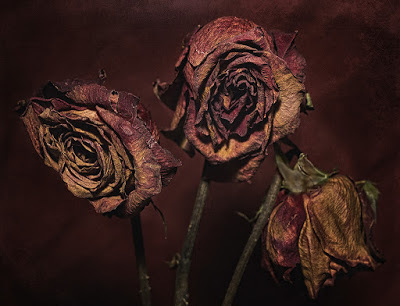
So, we had blistering sunshine in March and April, pouring rain and bitter winds in June, and now … we’ve got Christmas in July.
Well, it’s not strictly true that we’ve got Christmas in July, but as the jacket art is now ready for the three Christmas books I intend to bring out this autumn, I thought this might be an opportune time to give you your first glimpse, and maybe to chat a little about the plans I’ll put into force once this strangest summer of all has ended.
Which reminds me that – even though the virus is still with us, and many holidays have been cancelled, and the weather is pathetic compared to the weather we had in spring – it is still summer. So, in keeping with that, today I’ll also be reviewing and discussing one of the best summertime horror novels I’ve ever read: THE ELEMENTALS by the late, great Michael McDowell.
If you’re only here for the McDowell discussion, then that’s fine, as always. Just shoot on down to the lower end of today’s blog, and you’ll find it in the Thrillers, Chillers section.
Before then, however, if you’ve got a bit of extra time, I’m going to talk a little about …
Scary stuff this Christmas
Readers who follow this column regularly, will know that I’m a big fan of Christmas-themed scare-fare. Now, I assure you that this doesn’t mean I think about the festive season from January to December. I like all the seasons, and I particularly enjoy horror fiction (folk-horror would be the thing for this, I guess) that encompasses these different times of year with their various special days and ancient festivals.
But winter, and Christmas in particular, has always been a biggie in this regard. If you need proof of that, don’t take my word for it. I mean, I might have written many Christmas ghost and horror stories, but it’s a tradition that goes way back to MR James, Charles Dickens and beyond. So, there is a kind of precedent for it, to say the least.
By the way, I’m not comparing myself to those masters of the short form, but I do like to think I’ve got a decent track record when it comes to this sort of thing. Hence, I thought this year I’d try to package some Christmas specials – some ‘Christmas annuals’, as they used to say in comic parlance – and put them out there in print.
Two of these will not be unfamiliar, though I did feel it was about time they got something of a reboot.
First of all, we have:
IN A DEEP, DARK DECEMBERFive Festive Chillers

First published in 2013, though some technical hiccups saw it briefly removed from Amazon a couple of years ago, which obliterated the 30-odd approving reviews it had garnered, this is a collection of five Christmas stories and novellas, all supernatural in tone, all horrific in theme.
The table of contents is as follows:
The Christmas Toys
Midnight Service
The Faerie
The Mummers
The Killing Ground
You may wonder why I’m bringing it out again. Well, the truth is that I’m not really. It remains available as an ebook as it always was, but one complaint I received back in the day was that it never existed in print. Well … from this autumn it will do, under the above newly-designed wrap from the original artist, the indefatigable Neil Williams.
Yes, it’s the same stories that appeared electronically, but for the first time ever (in English) it will now be available in paperback too. On top of that, I’m very excited to announce that it will also be coming out in Audible, as narrated by actor, Greg Patmore, who did such a storming job with last year’s autumn release, SEASON OF MIST .
In a similar mood but much newer, the second festive collection I’ll be bringing out towards the end of this year is:
THE CHRISTMAS YOU DESERVEFive Festive Terror Tales

This is another collection of horror stories and novellas set in and around the Christmas season. But these you won’t have seen together in a single collection, electronically or otherwise … until now. Here’s the table of contents:
The Merry Makers
The Unreal
Krampus
The Tenth Lesson
The Stain
This too will be available in print, as an ebook and on Audible (yet again, with Greg Patmore providing the silken tones). As before, enjoy the marvellous cover art created by Neil Williams.
Last of the three, we’re back in familiar territory again, but with a completely new look. This one is:
SPARROWHAWK

People may recall that this Christmas-themed horror / romantic / Victorian novella first appeared in 2010 from Pendragon Press, and that it was shortlisted for the British Fantasy Award in the capacity of Best Novella the following year. In due course though, the print-run ended, and it was available from that point only as an ebook.
Well, the ebook remains and can be acquired as we speak. But this autumn there’ll be a brand new paperback version and again, it will be coming out on Audible (courtesy of Mr Patmore).
For those unaware, the story is set during the bitter winter of 1843, and follows the fortunes of an Afghan War veteran, who, on release from the debtors’ prison is tasked with protecting a mysterious house in Bloomsbury against an unknown enemy, a duty that unleashes a literal smogasbord of Yuletide terrors.
To round up, I apologise for talking Christmas in early July, but I do like to drop hints about what’s coming in the months ahead. If you continue to watch this space, there’ll be many more details – links, background info etc – posted here as the summer finally wanes and the darker months draw on.
Now okay, I know it’s pretty dark and gloomy outlook at present, but I promise you that this distinctly is not the case in the book I’ve chosen to review this week. Read on if you don’t mind getting sunstroke simply from the written page.
THRILLERS, CHILLERS, SHOCKERS AND KILLERS …
An ongoing series of reviews of dark fiction (crime, thriller, horror and sci-fi) – both old and new – that I have recently read and enjoyed. I’ll endeavour to keep the SPOILERS to a minimum; there will certainly be no given-away denouements or exposed twists-in-the-tail, but by the definition of the word ‘review’, I’m going to be talking about these books in more than just thumbnail detail, extolling the aspects that I particularly enjoyed (I’ll outline the plot first, and follow it with my opinions) … so I guess if you’d rather not know anything at all about these pieces of work in advance of reading them yourself, then these particular posts will not be your thing.
THE ELEMENTALS
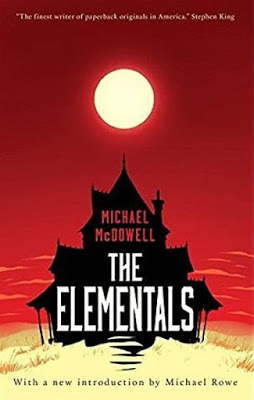
by Michael McDowell (1981)
OutlineThe Savages and McCrays are a prosperous pair of families. Born into the Deep South elite, Alabama aristocracy from way back, they lack for absolutely nothing.
Head of the Savage household, Dauphin, is a multi-millionaire and still relatively young. He’s known far and wide as a thoroughly nice guy, and is married to former beauty queen, Leigh, ex of the McCrays, which is where the link between the two families comes in. The McCrays, in their turn, live under the shadow of their patriarch, Lawton, a hugely successful businessman who is now standing for Congress, while his son, Luker, who lives in New York, is so well-fixed professionally that, at the drop of a hat, he can afford to take the entire summer off and vacation in the South.
And yet for all this gold-plated privilege, there are deep strains within the two families, equally deep animosities and even deeper divisions.
Lawton McCray, for example, is separated from his wife, Big Barbara, and reviled by Luker, who views him as the worst kind of ruthless capitalist but as a dangerous man too, because in the spirit of the Old South, where he was born, Lawton will stop at nothing, even crime and violence, to get what he wants. Due in no small way to this unhealthy arrangement, Big Barbara is an unreformed alcoholic, which has left her a silly, unthinking woman, who Luker can also barely tolerate, though recognising that there’s no real evil in her, he does his best. All that said, Luker himself has no dealings with his own ex-wife, from whom he is very acrimoniously divorced … to such an extent that his teenage daughter, India, who has lived with him most of her life, has been raised to dread the mere mention of her mother’s name. India, in fact, though a free-spirited, well-educated New York girl, often struggles because of her father’s domestic prejudices, whether they are merited or not, scarcely knowing how to react to her grandparents.
And then there is the infamously bad-tempered Marian Savage, Leigh’s mother-in-law, whom Luker also hates – or perhaps that should be hated, because we open the narrative at Marian’s funeral. Just in case none of what we’ve so far learned is dysfunctional enough, the funeral service, which is very poorly attended, is interrupted halfway through by an age-old Savage tradition, Dauphin opening his mother’s casket and stabbing her in the heart. Apparently, this is now the custom at all Savage funerals on account of a non-too-distant ancestor being unfortunately buried alive.
So far so Southern Gothic, you may think, and yes, we are firmly in that sun-soaked, uber-melodramatic territory. But The Elementals is also a ghost story, and it isn’t long before we arrive at the scene of the haunting.
At the close of the funeral, the two famlies head south to Mobile, on the Gulf Coast, where they are both part-owners of Beldame. This is basically a narrow spit of sand extending far out into the ocean (though often, the high tide renders it an island), the extreme tip of which is occupied by a row of three beautiful Victorian houses. Here, year-round warm weather (gloriously so in summer), blue skies, an even bluer sea, and complete isolation, always provide a relaxing break. The older members of the two families are completely besotted with the place and have been coming here since the 1950s. Even India, who has never been before, doesn’t much care for her relatives and would rather be in New York, is stunned when she first arrives. She can’t believe how lovely it is, even if oddities emerge almost straight away.
The third house in the row, for example, is owned by neither the Savages nor the McCrays (no one seems to know who owns it) and is succumbing to an immense sand dune, which has built up alongside it and is now slowly engulfing the entire structure.
In due course, this third house will start to cause serious problems, though at first all is well.
It’s unusually hot, even for Southern Alabama, and the two families are just glad to have got away from it all, and now unwind in the taciturn but fastidious care of Odessa, the Savages’ black servant, who’s been with the family since before the Civil Rights Movement but who stays with them because she is treated like a relative, even though she herself doesn’t behave this way.
During this languid time (when the livin’ is very easy!) other quirks of Savage/McCray family life emerge in full keeping with the oddball Southern Gothic tradition. Though Luker is well regarded by his family, he swears and profanes freely in front of them all, including his mother, and thinks nothing of sunbathing naked in the presence of his 13-year-old daughter (a liberal approach to life that she returns in full). But none of this seems out of place here at Beldame, where the sun beats down, the sea laps, the sands continually shift, and time literally seems to stop (the families never follow any kind of itinerary when they’re here, they just let the day and the mood take them).
And yet throughout, there is a clear feeling that, despite the summer lassitude, all is not well. The families love Beldame, but it’s soon evident that they are wary of the place too, particularly the third house, though no one seems to be willing to say why, especially Odessa, even though she – or so India suspects – knows most.
The youngster finally starts to wheedle it out of her elders just what the problem is, learning that the third house has been a blot on this picturesque coastline for quite some time. The reasons for this seem to vary. It’s not exactly an eyesore, but it’s been empty and unclaimed for so long that it’s decaying as well as disappearing into the sand. It seems especially weird though that third house is still fully furnished inside, almost as if someone still lives there. And yet neither the McCrays nor the Savages ever go in to look around.
Most interesting to India, though, are the third property’s ghostly aspects.
There are only one or two stories to this effect, and they have the aura of campfire tales. For example, a bunch of school friends once swore blind that they saw a naked fat woman walking around on the third house’s roof.
When India commences her own investigation of the third property, she immediately detects a presence and later learns that Odessa had a little girl once, Martha Ann, who disappeared here but was presumed drowned, India concludes that the third house is haunted by the child’s ghost. Odessa, finally breaking her silence, simply replies that it isn’t so.
Martha Ann is indeed dead, she says, but what occupies the third house is not her ghost. It is something much, much worse …
Review
Michael McDowell wrote several successful novels, but died at the tragically young age of 49, which on the evidence of The Elementals , was a major loss to genre fiction.
Because, in short, this is a very frightening ghost story.
Not only that, it tips all expectations on their head. Sun, sea, sand. Hardly scary, you may think. Well, you’d be wrong. An affluent southern family: handsome men, gorgeous women, heated passions – all the ingredients of a domestic melodrama rather than a horror story, right?
Wrong.
Wrong, wrong, wrong.
It’s a bit of a culture shock when you first start reading The Elementals . Because the one or two minor macabre details aside – Marian Savage’s funeral, Luker’s utter (and never fully explained) hatred for his ex-wife – it does feel as if you’ve strayed into a Tennessee Williams play. But that doesn’t last long. Because Beldame (which in Old English used to mean ‘witch’, of course), is so well-realised a location that it really is a place apart. Its atmosphere is one of strangeness, dreaminess, and yet all the time, right from the outset, the sinister presence of the third house is there, just on the corner of our vision.
All of this feeds nicely into the plot’s slow-burn development. We certainly have a lengthy period when nothing really seems to happen, the family re-acclimatising to Beldame, sunbathing, sleeping, engaging in idle conversation, and yet odd, unnatural things do happen. At first, they are small, and eerie rather than frightening. But they come more and more regularly, the sense of foreboding gradually growing, until finally the occupants of the third house, disturbed from their slumbers by both India’s curiosity and Lawton’s villainous schemes, explode out in some of the most terrifying ways imaginable.
But I think what works best for me in The Elementals is not so much the increasingly scarier story, but the unknowable nature of the antagonists.
I don’t want to say too much about them because I don’t want to spoil things more than I already have. But as you are likely to guess from an early stage, these aren’t ghosts or even demons in the conventional sense. This is something else entirely. Luker McCray only calls them ‘elementals’ because he can’t think of any other way to describe them, but it’s highly appropriate. Because whatever they are, they are part of this place, and always have been.
It certainly makes for a intriguing conflict: the time-honoured, all-powerful southern clan coming up against an infinitely more ancient and immovable force, something intangible and yet sentient, something that is intricately connected to this lonesome spit of land, so much so that it can control the sand, the air and the water, and yet something that can strike at its opponent in any number of ghastly and horrifying ways – and trust me, these are ghastly.
You may have to wait a little while for them, but the moments of horror, when they come, are literally hair-raising.
As I say, apart from the catastrophe of losing Michael McDowell as a person, we also lost a prodigious talent, and what I imagine would have been a plethora of such clever and spine-tingling tales.
If you’ve not read The Elementals , you must do. It was first published in the 1980s, but it’s a timeless chiller in the best way, and I’m not remotely surprised that Poppy Z Brite referred to it as ‘surely one of the most terrifying novels ever written,’, or that Stephen King described McDowell as ‘the finest writer of paperback originals in America,’ while Peter Straub called him ‘one of the best writers of horror in this or any other country’.
And now, here we go again. I’m going to be bold (or stupid) enough to try and nominate my own cast should this very fine horror story ever hit the screen. If only I had the power to make it happen in reality:
India McCray – Lara Decaro
Odessa Red – Viola Davis
Luker McCray – Joe Kinnaman
Lawton McCray – Woody Harrelson
Big Barbara – Rebecca Front
(The picture at the top is not mine, but despite searching online, I couldn't find an owner. If anyone has an issue with me using it without a credit, just let me know and I'll add a credit immediately, or even remove it).
Published on July 12, 2020 03:06
June 21, 2020
Cops and killers from page to big screen

Okay, we’re not quite there yet … and no, I’m not talking about the end of lockdown (though it feels closer than it was). I’m referring to ONE EYE OPEN, my next cop novel, which is due for publication across all platforms on August 20. In fact, it’s so close now that today I received my first tweet from a NETGALLEY reviewer about how much they are enjoying it.
Talk about a nice way to start the day.
Of course, one of the things that always enters an author’s mind as the publication of their new novel appears on the horizon is ‘will this be the one?’ Not just the breakout novel, but the one that hits the top of the charts and stays there? The one that means the staff in your local branch of Waterstones actually start to say ‘hello’ to you? The one that gets adapted into a multi-million dollar movie?
We all live in hope of course, but just to prove that it can happen sometimes, today I thought I’d look at some of those awesome cop thrillers that went before me and then hit the light fantastic a second time when Hollywood got hold of them.
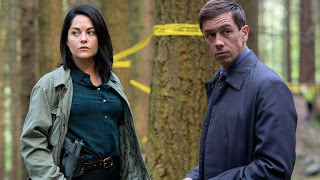 In that same spirit, I’ll also be reviewing and discussing IN THE WOODS by Tana French – a superb police novel which, while it didn’t become a blockbusting movie, went on to become a successful TV series (see above).
In that same spirit, I’ll also be reviewing and discussing IN THE WOODS by Tana French – a superb police novel which, while it didn’t become a blockbusting movie, went on to become a successful TV series (see above).If you’re only here for the Tana French review, no worries. Get straight on down to the lower end of today’s post. But if you’ve got some extra time on your hands, you might also be interested in …
Screen cops who were on the page first
Though I’ve written lots of movie scripts, two of which actually got made into movies, I’d reserve a special place in my heart for any novel of mine that received the film treatment.
I’m not sure why. Perhaps it’s just that with something you hatched yourself and have then lived and breathed for month on end, sweated over, bled over (etc), characters you gave birth to, nurtured and developed (etc), it would just be so damn cool to see someone else’s take on the same story, especially if they were putting Hollywood-type money into it, and even more especially with a major league talent behind the lens.
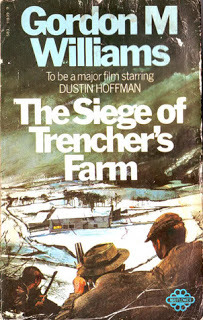 Of course, whenever this happens, authors aren’t always happy with the outcome no matter how much money it might earn them from the cinema-going public.
Of course, whenever this happens, authors aren’t always happy with the outcome no matter how much money it might earn them from the cinema-going public. Stephen King famously didn’t like Stanley Kubrick’s 1980 reimagining of his 1977 novel, The Shining , while Gordon Williams was furious when, in 1971, Sam Peckinpah turned his 1969 novel, The Siege of Trencher’s Farm , into the controversial and violent Straw Dogs .
I’m not sure how I’d have reacted in either case, given that both movies made a bomb at the Box Office and probably re-energised the sales of the original books to some tune. A bigger issue for me might be the occasionally-heard complaint that a film version has overtaken the book in terms of fame … even to the point where the book itself has all but vanished from public awareness.
A couple of obvious examples of this spring to mind. Most people remember Alfred Hitchock’s 1972 serial killer thriller, Frenzy , but very few even know that it was adapted from Arthur Le Bern’s 1966 novel, Goodbye Piccadilly, Farewell Leicester Square . Likewise, we all remember Hitch’s even more sensational slasher horror, Psycho , but who outside students of the genre is even aware that it came from Robert Bloch’s 1959 novel of the same name?
Again, I’m not sure how I’d respond. In truth, I think I’d just be happy that Hollywood was taking a punt. But again, just to prove the point that it can also happen with my genre, here, in no particular order, are …
Ten Major Cop Movies You (Quite Possibly) Didn’t Know Started Life as Novels
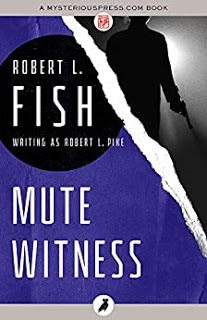 1 Bullitt (1968)
1 Bullitt (1968)Long years have passed but most movie fans still fondly recollect the late, great Steve McQueen’s superb performance as Frank Bullitt (top), a San Francisco police lieutenant, who, when he loses his mob supergrass to hitmen, makes it his personal mission to catch the bigwig who gave the order. They also remember the astonishing car chase, at the time one of the greatest ever committed to film.
Not many know that this cinema cop classic came to us straight from Robert L Fish’s 1963 novel, Mute Witness . Swap a few names and the San Fran setting for New York, and it’s a very similar tale.
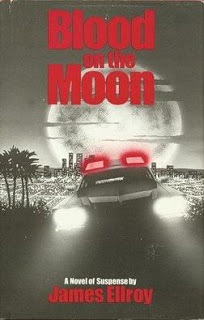 2 Cop (1988)
2 Cop (1988)James Woods puts in a mesmerising shift as amoral LAPD detective, Lloyd Hopkins, whose talent is recognised by his superiors, but who is also considered a risk-taker. As such, when he investigates the death of a politically active call girl and concludes it’s the work of an unidentified serial killer, the top floor won’t trust him. Hopkins, who already has problems at home, has no option but to go it alone.
It sprang from a more famous original novel in this case, James Ellroy’s 1984 classic, Blood on the Moon , the first in a Lloyd Hopkins trilogy. Similar thrills, similar politics, but with an even grittier 1970s setting.
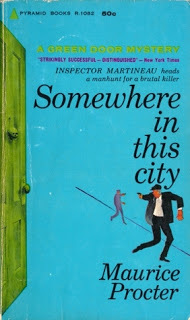 3 Hell is a City (1960)
3 Hell is a City (1960)Stanley Baker is pitch perfect in Val Guest’s famous Brit Noir, in which a tired Manchester DI is so determined to nail an old foe who has recently staged a violent jailbreak and might already be responsible for another robbery, that his failing marriage takes second place. Riding the British New Wave film movement, the producers happily left London and hit us with some real northern grit.
In the original, in 1954, Maurice Procter introduced us to Detective Chief Inspector Martineau in the pacy Somewhere in the City , the first of a whole series of gritty hard-hitting thrillers set in the bleakly industrial North.
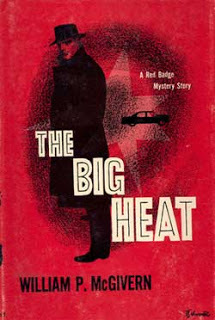 4 The Big Heat (1953)
4 The Big Heat (1953)Vintage Noir, as Glen Ford takes on the mantle of small-town cop looking into the suicide of a fellow officer, only to uncover a rat’s nest of intrigue, corruption, prostitution and murder. ‘Master of Darkness’ Fritz Lang added many horrorish moments, including a real shocker in which low level thug Lee Marvin throws scalding coffee into the face of gangland moll, Gloria Grahame.
Originally written by William P McGivern, The Big Heat appeared episodically in The Saturday Evening Post in 1953, only hitting the bookstalls much later as a complete novel. Every bit as tough as the film.
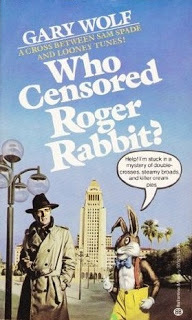 5 Who Framed Roger Rabbit? (1988)
5 Who Framed Roger Rabbit? (1988)Yes, you heard that right. Disney/Amblin’s big ‘live action plus animation’ hit of the late 1980s actually started life as a comedy suspense novel. In the movie, you’ll recall that Bob Hoskins is the down-on-his-luck detective who has spent most of the 1940s drunk but who, when called on to check the suspicious antics of cartoon star Roger Rabbit’s wife, Jessica, uncovers a fiendish conspiracy.
In Gary K Wolf’s 1981 original, Who Censored Roger Rabbit? , the story differs quite a bit, the toons mostly from comic strips, but sexy Jessica still gets to say that she’s ‘not bad, just drawn that way’.
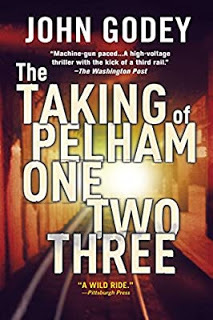 6 The Taking of Pelham One Two Three (1974)
6 The Taking of Pelham One Two Three (1974)One of the great action movies of the 1970s, Joseph Sargent’s high tension tour-de-force follows the capture of a New York subway train and its passengers by a gang of highly organised hijackers under the control of a ruthless British former-SAS soldier (a steely Robert Shaw) who will kill anyone that defies him, while Transit Lieutenant Walter Matthau coolly attempts to outmanoeuvre them. A crime classic.
John Godey’s 1973 novel of the same name follows the same course as the film, with some differences in terms of characters but the same ingenious plot twists that would give the movie its wow factor.
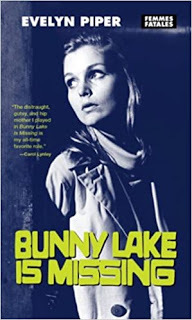 7 Bunny Lake is Missing (1965)
7 Bunny Lake is Missing (1965)Perhaps not strictly a ‘cop movie’, more a ‘psychological thriller’, though Detective Superintendent Newhouse (Laurence Olivier) is the main investigator and a key character when toddler Bunny Lake goes missing from her London nursery school, the top cop increasingly turning curious about her stressed single parent (Carol Lynley) as there is progressively less evidence that the child ever existed.
Evelyn Piper’s 1957 original is set in New York and focusses much more on the terror and trauma of the shunned single mother as she searches for her child alone. Both however, are regarded as masterpieces.
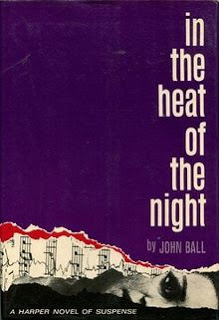 8 In the Heat of the Night (1967)
8 In the Heat of the Night (1967)Virgil Tibbs, a black police detective from Philadelphia, is accused of murder while visiting a Mississippi town, but eventually forms an alliance with the racist chief of police, teaching him the error of his ways and at the same time helping him catch the real killer. Sidney Poitier and Rod Steiger give unforgettable star turns in this groundbreaking thriller, which was much applauded by the Civil Rights movement.
John Ball’s original novel of 1965 told the same story, though the setting is South Carolina and Tibbs is a cop with Pasadena PD. Its huge success kickstarted a whole series of Virgil Tibbs novels.
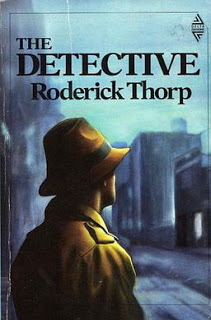 9 The Detective (1968)
9 The Detective (1968)Frank Sinatra gives what is generally regarded as a career best performance as Joe Leland, a veteran NYPD sergeant, whose ‘no nonsense’ approach to his job holds his team together when a disgusting murder leads them into a world of vice and exploitation. A grown-up and high-quality mystery thriller, one of the first ever to openly confront such new-fangled issues as pornography and gay prostitution.
Roderick Thorp’s original 1966 novel was a cutting-edge slice of Noir in an age when that genre hadn’t yet dated. Concerns a PI, not a cop, but still packed with grown-up material and frank police speak.
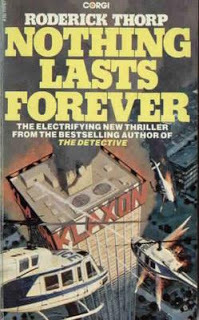 10 Die Hard (1988)
10 Die Hard (1988)Everyone’s favourite Christmas action movie, NYPD reject John McClaine taking on a whole posse of deranged terrorists when they take over LA’s Nakatomi Tower but make the mistake of capturing his exec wife in the process. It made stars of Bruce Willis and Alan Rickman and set a new high bar when it came to full-on Hollywood shoot-em-up. Very few know that it was the sequel to The Detective (above.).
Roderick Thorp wrote Nothing Lasts Forever in 1979, with creaky retiree, Joe Leland, taking on the terrorists in LA’s 40-storey Klaxon Tower. Amazingly, 73-year-old Sinatra almost got the part in the film.
THRILLERS, CHILLERS, SHOCKERS AND KILLERS …
An ongoing series of reviews of dark fiction (crime, thriller, horror and sci-fi) – both old and new – that I have recently read and enjoyed. I’ll endeavour to keep the SPOILERS to a minimum; there will certainly be no given-away denouements or exposed twists-in-the-tail, but by the definition of the word ‘review’, I’m going to be talking about these books in more than just thumbnail detail, extolling the aspects that I particularly enjoyed (I’ll outline the plot first, and follow it with my opinions) … so I guess if you’d rather not know anything at all about these pieces of work in advance of reading them yourself, then these particular posts will not be your thing.
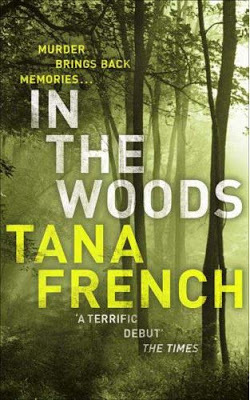 IN THE WOODS
IN THE WOODS by Tana French (2007)
OutlineDuring a gorgeous summer in Knocknaree, in the lush countryside outside Dublin, three 12-year-olds sleepwalk into tragedy. A close-knit group of friends, they are Jamie, Adam and Peter, and they are living life as only carefree youngsters can, spending each day of their school holidays romping through the sun-drenched meadows and woods – particularly through the woods.
Where one day something terrible happens.
When the evening arrives and the trio still haven’t come home, their parents get concerned and the police start searching. Of Jamie and Peter there is no trace, but Adam is found dazed and uncommunicative, his shoes and socks soaked with blood. His catatonic state persists, and even when he recovers sufficiently to talk, he has no memory of what happened in the woods. The police, meanwhile, continue to search, but find nothing.
We then rush forward two decades, to a time when the adult Adam, now an English-accented detective with the Dublin Murder Squad, returns to the same place during a sunny summer uncannily similar to that one all those years ago, to investigate with his colleagues, detectives Cassie Maddox and Sam O’Neill, what looks as if it may be the ritual slaying of a 12-year-old girl, Katy Devlin, whose brutalised body has been found on a druidic sacrificial slab at a partially excavated archaeological site.
Adam, who has renamed himself ‘Rob’ in order to put distance between himself and the traumatic events of all those years ago, was partly inspired to join the Gardai because of that unspecified but dreadful incident (and more importantly, by the imposing men who investigated it), but now that he’s back here in Knocknaree, he is increasingly discomforted by his fogged memories and by a brand-new case that in many ways is reminiscent of the old one.
Initially, Rob is ably assisted by Cassie, who in truth is a better all-round copper than he is, and who provides strong personal support because their friendship surpasses professional buddy-buddyism by a big margin. Having originally joined the Squad as misfits, they naturally gravitated together, and their relationship, though strictly platonic, has become extraordinarily close, the twosome getting on so well that they spend most of their off-duty hours together, cooking, drinking, and laughing raucously at each others’ bad jokes, often into the early hours of the morning, at which point they’ll happily crash on each others’ couches.
In terms of the case, they have a number of lines of enquiry. The archaeologists on the site, most of them students, are a mixed bunch, but the shy, nervous Damien Donnelly, who actually found the body, seems like an oddball, while the site’s unofficial ‘foreman’, an angry hippy type called Mark Hanly, is cocksure and irritable, and immediately catches Rob’s eye as someone he doesn’t particularly like. Equally worth investigating, however, is Jonathan Devlin, Katy’s father, who isn’t just the main organiser of ‘Move the Motorway’, a pressure-group looking to divert a new road, which will otherwise devastate the local natural woodland (and obliterate the archaeological dig!), but who Rob remembers from childhood. Jonathan Devlin wasn’t a respectable middle-class man back then, but a local lout, who used to cause trouble in the surrounding district, and who was certainly hanging around in the woods, or so Rob seems to recall, on that day when his young friends disappeared. At the same time, the introverted Devlin family are themselves under pressure from unknown persons, Jonathan claiming to have received threatening phone-calls, while there is even a suggestion that Katy, a promising dance student, might have been the victim of a recent attempted poisoning. The household itself is in flux, the family members constantly at odds with each other, all of them viable suspects in their own way, while the emotionally vulnerable Rob finds the victim’s fetching older sister, Rosalind, a particularly taunting and distracting presence.
No more distracting, though, than his memories of Knocknaree as a child, before the Celtic Tiger, when the area was poorer but quieter and less suburban, or the mysterious fate of his two friends, which, when one of Jamie’s hair-clips is found near the scene of Katy Devlin’s death, he becomes convinced is connected to this present day crime.
Frustrated by this and by the investigation team’s failure to hit paydirt with any of their leads, and under huge pressure from his boss, gruff old-schooler, Detective Superintendent O’Kelly, Rob opts to try and jumpstart his memories by camping out alone overnight in the woods close to the scene of the crime.
Which will prove to be a catastrophic mistake …
ReviewTana French’s debut novel and dark psychological thriller, In the Woods , made a huge impact on first arrival, sparking a popular TV series and a whole list of Dublin Murder Squad mysteries. It has won almost universal acclaim for its detailed study of an outwardly confident but secretly tormented police hero, whose journey through a complex, distressing murder case is compromised by his memories of a similarly harrowing experience during his own childhood.
The book has also won hefty praise for neatly capturing the Irish zeitgeist of the early 21st century, not just disdaining the dewy-eyed American view of Ireland as a rural idyll of green hills and flame-haired beauties, but also criticising the more materialistic era of short-lived affluence during the 1990s and early 2000s, and putting the deluge of financial difficulties spilling from the ensuing property bubble into a real context.
I approached the book well aware of all this praise but have no real quibbles with any of it. In the Woods does all these things very well indeed. It is also sumptuously written (unusually so for a thriller) and is populated by a plethora of memorable characters.
The hero, Adam ‘Rob’ Ryan, has certainly been to Hell and back. His personal dynamic is quite fascinating, the awful truth lurking in his subconscious but his constant and torturous attempts to recollect it fruitless, a personal trouble that grows steadily more intrusive as the narrative progresses. And yet, Tana French doesn’t use this as a device purely to elicit our sympathy. More than once, for example, it is hinted that the younger Rob’s bizarre memory lapse might have been convenient for him, and that, though he was young when this grim event happened, he wasn’t prepubescent, and so it’s not beyond the bounds of possibly that he himself was in some way culpable. Of course, we readers think we know differently because we can see into Rob’s head, and we know that he is indeed a lost and bewildered soul, but if you think about it, that still doesn’t make him innocent.
The juxtaposition to Rob is of course Cassie Maddox, his fellow investigator and best friend, and in some ways, this is where I have one of my few doubts about In the Woods . For me, Cassie is just a bit too perfect: attractive in the best kind of way (i.e without being overtly, daftly sexy), very empathetic, very intelligent, intuitive, analytical and sharp-eyed. In short, an all-round excellent person as well as a quality copper, she seems a little bit too good to be true, and in that regard detracts quite a bit from our main character, who appears weak and incompetent by comparison, and irritatingly inclined to self-pity.
On top of that, while their close friendship feels natural enough – square pegs will always seek each other out when all the others are round – there are times when the duo strike me as being more like matey students than murder detectives, raucously bantering when off-duty, playing silly jokes on each other while putting the world to rights, staying up all night drinking despite being in the middle of a challenging child-murder investigation. It made a nice change to see male and hero leads presented as friends rather than lovers, but from the very beginning, I couldn’t help wondering how long this was going to last.
But despite all that, which I won’t pretend didn’t spoil the book for me a little, the central relationship still works on the whole, the duo forming an effective focal point for the story, and though they are both remarkably young for homicide detectives, investigating the case believably and authoritatively.
By contrast, most of the other police characters are a little bit stock, though I did enjoy rough-edged Detective Superintendent O’Kelly, whose complete disregard for political correctness reminded me persuasively of my own senior supervisors back in the day, at one point casually dismissing a male officer’s headache as ‘womanly shite!’
The suspects, of course, come thick and fast, and as well as adding depths of mystery, form a well-framed microcosm of Irish society, one of the author’s key aims with this novel, I suspect, showing us everyone from the money men at the top of the tree, who are still looking at ways to expand their empires, to the struggling middle-classes left so bereft after the era of prosperity ended, to the scruffy young idealists who still believe that digging up ancient Irish history is more important than the creation of fast roads to stimulate business. The fact that they’re all framed as potential murder suspects is a clever move. It’s certainly the case that very few people here are completely right or completely wrong, and none are cast as being so pure that they’re beyond murder (not even our main hero).
In addition to all this, Tana French has done her research in terms of police procedure. She’s been accused in some quarters of ditching reality altogether by creating a Dublin Murder Squad when there actually isn’t one. But whether this should be a cause for concern is moot. In the Woods is French’s own book, so in truth she can do what she wants with it, and she never pretends that it isn’t a work of imagination. I do feel that she’s been influenced more than she perhaps should be by the American style of cop fiction, wherein the most gruesome murder cases are handled by a couple of plucky detectives virtually on their own, while in reality – certainly in the UK, and maybe in Ireland too – what appears to be a ritualistic child-murder would see the creation of a dedicated taskforce.
But again, it’s all about entertainment. Tana French is not in the business of writing police textbooks. In the Woods is a thriller, a genre that isn’t honour-bound to replicate real life blow-for-blow, and having reduced the number of investigators, and dispensed with most of those by-the-book protocols that sometimes clutter up crime fiction plotlines, it’s a thriller that fulfills one of its key ambitions nicely by rattling along at an enjoyable pace
It’s a big book, running to 600 pages, but I was so hooked that I read it inside a week. Perhaps it’s a tad overwritten. Beautiful descriptions are not to everyone’s taste in a novel like this, while I found the repeated pop culture references a bit unnecessary, but there can’t be any real complaint when a big, solid chunk of a novel keeps you so engrossed that you get through it so quickly. Strongly recommended.
Regulars on here may know that I often like to round up each of these reviews by casting the work for an imaginary TV adaptation. Well, it’s not required in this case, given the enjoyable Irish television series of 2019.
Published on June 21, 2020 03:04
May 18, 2020
Why I won't be writing about the lockdown

… in the near future.
I have to add that caveat because you can never say ‘never’ in any aspect of life. Though for the moment I’m firm. This will be the main gist of today’s chat. In addition to that, however, I’ll update you on where we’re at with my forthcoming new novel, ONE EYE OPEN, and, in reflection of our current dark and silent streets – where in the minds of many, violent criminals are running amok – I offer a detailed review and discussion of a crime classic, Michael Connelly’s astonishing Harry Bosch debut, THE BLACK ECHO.
If you’re only here for the Harry Bosch chit-chat, that’s fine. As always, you’ll find it at the lower end of today’s blogpost. Feel free to pop down there straight away and have your say. However, if you’ve got a little more time to spare, here’s the latest on …
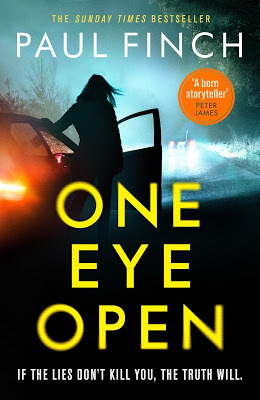 One Eye Open
One Eye OpenThus far, my new novel is still in the pipeline for an August release. I’m loving this cover, which for once actually encapsulates a scene from the novel, and I can now reveal the blurb that will appear on the back of the book.
I won’t say too much more about it at present, except that it’s a free-standing crime thriller set in the leafy southeast of England, where far too many gangsters (both homegrown and otherwise) are getting comfy, and brings in a new set of hardbitten police characters who are determined to bring justice back to the neighbourhood.
But enough from me. Time to let my publishers, Orion, do the talking ...
If the lies don't kill you, the truth will
An electrifying, high-octane thrill ride; the new must-read standalone from a Sunday Times bestseller. You won’t be able to tear yourself away! Dark, gritty and always at the edge of your seat, this unforgettable new outing from master-craftsman, Paul Finch, will appeal to fans of Stuart MacBride, Mari Hannah and Alex Cross.
YOU CAN RUN
A high-speed crash leaves a man and woman clinging to life. Neither of them carries ID. Their car has fake number plates. In their luggage: a huge amount of cash.
Who are they? What are they hiding?
And what were they running from?
YOU CAN HIDE
DS Lynda Hagen, once a brilliant detective, gave it all up to raise her family.
But something about this case reignites a spark in her...
BUT YOU’LL ALWAYS SLEEP WITH...
What begins as an investigation soon becomes an obsession. And it will lead her to a secret so dangerous that soon there will be nowhere left to hide.
ONE EYE OPEN
***
And now, on a gloomier note …
Writing up the lockdown
I’ve recently been fascinated to hear that several editors and agents of my acquaintance have put it online that at present they aren’t interested in lockdown-based novels. Clearly, this suggests that they are being hit with a number of pitches set during this crisis.
On the face of it, this doesn’t surprise me at all. It’s certainly a strange new experience that we’ve all been plunged into, and I’m not just talking about the sight of animals suddenly feeling free to wander our city streets again (though that in itself is an eye-opener and surely worth a book of some sort).
Last Friday night, I took my daily exercise by walking down into Wigan town centre at around 9.30pm.
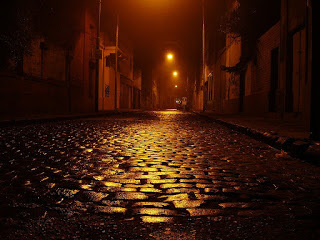 To describe the place as a ‘ghost town’ would be under-selling it. Streets that would normally be throbbing with nightlife were silent and pitch-dark. Out here in the provinces we are used to seeing our shops boarded, our arcades permanently shuttered. But our pubs? Our restaurants? Our fast food vendors? At that time of the week, there’d normally be crowds of revellers on every street-corner. But on this occasion, quite literally, there was no one anywhere. And all the time I was out – all told, for about three hours – perhaps one or two cars passed me by. The eeriness of it was tangible.
To describe the place as a ‘ghost town’ would be under-selling it. Streets that would normally be throbbing with nightlife were silent and pitch-dark. Out here in the provinces we are used to seeing our shops boarded, our arcades permanently shuttered. But our pubs? Our restaurants? Our fast food vendors? At that time of the week, there’d normally be crowds of revellers on every street-corner. But on this occasion, quite literally, there was no one anywhere. And all the time I was out – all told, for about three hours – perhaps one or two cars passed me by. The eeriness of it was tangible.But if I thought the streets of the town were strangely bereft, how different it was again whenever I veered through parks and finally headed into the woods near my own home. Now, these places wouldn’t be bouncing even on a normal Friday night, but I was still in Wigan, in the heart of Greater Manchester, and yet, with the ambient noise of distant traffic completely absent, I could have been in the New Forest or the Lake District or the Highlands of Scotland.
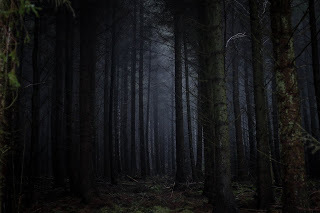 It was just me, alone amid acres of deep, shadow-filled thickets, over the top of which arched an early summer night-sky ablaze with constellations I hadn’t seen so clearly for many a long year, if ever. Again though, the blanketing silence was so oppressive that enjoyment remained elusive. The odd twinkle of lamplight from a suburban avenue or someone’s back window might penetrate the lattice of branches and leaves, but it added no comfort because there were no sounds of life to accompany it.
It was just me, alone amid acres of deep, shadow-filled thickets, over the top of which arched an early summer night-sky ablaze with constellations I hadn’t seen so clearly for many a long year, if ever. Again though, the blanketing silence was so oppressive that enjoyment remained elusive. The odd twinkle of lamplight from a suburban avenue or someone’s back window might penetrate the lattice of branches and leaves, but it added no comfort because there were no sounds of life to accompany it.No, I’m not at all surprised that some thriller and horror writers are looking to utilise this strange and unearthly experience we’re all sharing – at least as a background, if not the main story.
One bane of our thriller writer lives in the modern age has been the advent of personal technology. You’re rarely alone (and therefore rarely in danger) these days because you don’t need to find a working payphone to call for help. In fact, most of us don’t just carry around the capability to contact others, but the capability to film crimes as they occur, to photograph suspects and even covertly record suspicious conversations. But it doesn’t feel like that at present. Because no one knows from one minute to the next how effectively the emergency services will be able to respond.
Will our overstretched police force rush out to incidents they may consider to be of lesser importance – such as reports of prowlers, or weird noises in a back alley, or a distant scream that may not necessarily have been a vixen on heat – but which to the average citizen, especially alone at night, might be of serious concern? How quickly can we receive medical help if we need it? Will a doctor or nurse even be able to see you if you’re in a state of shock because you’ve had a bad fright?
All these questions, and others like them, have potentially made the lockdown a prime hunting ground for writers whose main job is to scare their readers.
But I have to say – and this is NOT A CRITICISM of those who are seriously considering this – I’m not among them.
There is no doubt that, however this thing ends, it’s been an event we will all remember for the rest of our lives, with varying degrees of pain and sadness. It’s certainly not something any of us will forget, even if we want to try.
The news media have had a field day of course. This is by far the largest story that any of them have ever covered and probably ever will, and they are determined to milk it for everything they can. All of a sudden, everyone on television is an expert. We’ve had anchor men and women making all kinds of apocalyptic statements like ‘this is the new normal’ or ‘we need to adapt to a new world’.
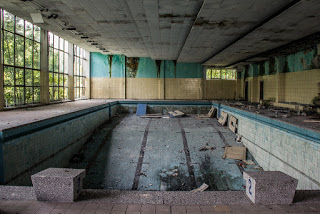 But you know … they might be correct. Even a broken watch is right twice a day.
But you know … they might be correct. Even a broken watch is right twice a day.And that’s one of the most frightening things to me. Are we seriously saying that for the rest of time, or at least the rest of our lives, close social interaction between human beings will not be viable? Frankly, it doesn’t bear thinking about. Will markets, nightclubs, cruise ships and public swimming pools really become things of the past? Do people of a certain age see no future at all where they aren’t confined in their own homes?
It’s certainly the case that there’ll be changes of some sort and that we won’t like them.
I can’t speak for other authors, and would never be so arrogant as to try, but for all these reasons I’m seeing little in the lockdown to get creatively excited about. Partly, it’s because I have to enjoy what I’m writing, even if the subject-matter is traumatic and terrible – in fact usually, the more traumatic and terrible it is, the better I like it. But I write fiction, so when something traumatic and terrible is happening in real life, it’s another matter entirely.
The other thing is that, as I’ve already intimated, we can’t second-guess what the world will be like when the lockdown is over. We’ve already mentioned that there may be significant changes (alternatively, there may be none at all, but at present we’ve no clue). I’m certainly not the only writer I know who is worried that his/her output of fiction thus far may have become irrelevant this last couple of months because it now refers to a different experience of life. Up to very recently, nearly all of us have been writing about a world that had barely heard about the Coronovirus, about societies that couldn’t imagine lockdowns or social distancing.
Now, don’t get me wrong. I’m not saying that we’ll never get back to normal. But even our health experts can’t predict things with any certainty. So, for this reason as well, I’m finding it very difficult dredging up any enthusiasm to write about this disaster.
Am I saying that, as a writer, I’ll never go there ever?
Most definitely not. If complete normality does return, this calamity might eventually be looked back on as nothing more than an ugly blip in the ongoing progress of all our lives. In that case, it may in due course become the perfect nail on which to hang some dark and dangerous stories. But until that time, as long as COVID-19 remains an ongoing tragedy, with thousands of more people dying each week than we are used to, medical staff worked to the bone, and so many of us trapped in our own homes, or facing unemployment or the collapse of the businesses we’ve worked so hard to build, it’ll remain a no-go area for me.
Again, though … this is NOT a criticism of those who are willing to give it a whirl. Everyone is their own person, we are all different, and as I mentioned, there are very understandable reasons why a few of us might be prepared to get stuck in straight away.
THRILLERS, CHILLERS, SHOCKERS AND KILLERS …
An ongoing series of reviews of dark fiction (crime, thriller, horror and sci-fi) – both old and new – that I have recently read and enjoyed. I’ll endeavour to keep the SPOILERS to a minimum; there will certainly be no given-away denouements or exposed twists-in-the-tail, but by the definition of the word ‘review’, I’m going to be talking about these books in more than just thumbnail detail, extolling the aspects that I particularly enjoyed (I’ll outline the plot first, and follow it with my opinions) … so I guess if you’d rather not know anything at all about these pieces of work in advance of reading them yourself, then these particular posts will not be your thing.
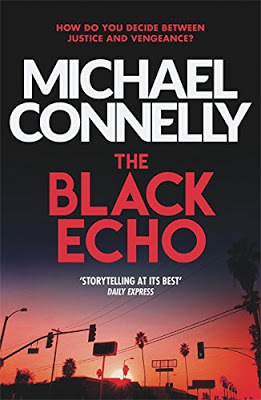 THE BLACK ECHO by Michael Connelly (1992)
THE BLACK ECHO by Michael Connelly (1992)OutlineHieronymous ‘Harry’ Bosch is an astute, hard-working detective with a sharp eye and a mean-as-sin attitude, not just with the crims, but even with his fellow cops if they aren’t doing the job properly. On top of that he’s well known in his native Los Angeles, having closed some high profile cases and even seeing some of his exploits fictionalised in a pacy TV show (as a result of which he was able to acquire himself an enviable pad high in the Hollywood hills). He ought to be one of the stars of the LAPD’s elite Robbery-Homicide Division, but there are more than a few strikes against him.
First of all, he speaks his mind, even to the brass. Secondly, he likes to go it alone, taking chances and following leads even if the rest of the team aren’t up to speed, his personal safety a secondary consideration. Thirdly, and most recently, he uncharacteristically used excessive force in his pursuit of ‘the Dollmaker’, a serial killer whose grotesque, crypto-artistic depredations had the whole city terrified. Having shot the guy dead while he was unarmed, Bosch was bound to come under the microscope, but in the highly politicised world of the LAPD’s higher ranks – where the unashamed jockeying for position is an embarrassing art-form all of its own – it was the perfect opportunity to divest the department of a loose cannon, hence Harry was busted down to Hollywood Homicide, where he would be safely out of the public eye.
Bosch is a professional, though, and gets on with the job, and when sent to check out a body found in a drainage pipe near the Mulholland Dam, he doesn’t share everyone else’s casual assumption that this is just another junkie who’s OD’d, even though the body is that of Billy Meadows, a known heroin addict who has died with a hypo in his arm. Harry doesn’t merely call on his basic detective skills to deduce that Meadows was murdered, he also recognises the victim personally.
A Vietnam vet, Bosch was once part of an infantry unit whose speciality was underground infiltration, pursuing the Viet Cong through their limitless networks of tunnels. Meadows was part of the same outfit, which, given that his corpse was dumped in a tunnel, is surely no coincidence.
This is not a comfortable time for Bosch, evoking memories of the Vietnam War, which he’s never really been able to bury deep enough, but more worrying still, the so-called ‘Black Echo’. This was the coronary-inducing terror the ‘tunnel rats’ used to suffer when crawling on all fours in pursuit of their foes through the midnight labyrinth of the jungle underworld. Its return to the forefront of his memory makes everything a lot harder, not just for Bosch, but for all those in his company.
Inevitably though, he elicits little sympathy from the top floor, Lieutenant Harvey ‘Ninety-Eight’ Pounds supportive but only to a superficial degree, Deputy-Chief Irvin Irving uninterested in anything that doesn’t make him look good and particularly untrusting of a non-team-player like Bosch. The net-result is that two ambitious but highly prejudiced IA officers, Detectives Lewis and Clarke, are put on Bosche’s tail, and even when his enquiry leads him to a 10-month-old bank heist pulled off by a team who tunnelled into the vault, which sees him hooking up with a specialist anti-robbery FBI unit, these bloodhounds won’t give him a minute’s rest.
Even the FBI alliance proves problematic. LA Bureau boss, John Rourke, is okay man-to-man but irritatingly by-the-book where Harry is concerned, while Special Agent Eleanor Wish, whom he’s partnered with, while initially antagonistic to him for his solitary attitude (and habitual chain-smoking!), eventually comes to like him, but remains an enigma (and a beautiful one to boot!), and it doesn’t at all help that Bosch finds himself irresistibly attracted to her.
Needless to say, nothing about this investigation is going to be anything like as straightforward, routine or danger-free as was initially imagined …
ReviewIt may seem vaguely ridiculous to be reviewing The Black Echo now, when, over the 28 years since its first publication, it’s grown exponentially into a world-famous 21-book series. But in case you were wondering where the whole Harry Bosch saga started, this might be of interest.
To begin with, Bosch is in so many ways the quintessential loner cop, though he wasn’t the first. Even back in 1992, Dirty Harry predated him by over 20 years. But the most interesting thing about the Harry Bosch story is that it’s all set within a convincing LAPD environment. He doesn’t go around remorselessly shooting people anyway, so there was never a chance he’d come to match Harry Callahan’s scorecard, but even if he was inclined to, in this carefully structured, very authentic world he wouldn’t be allowed to get anywhere close to it.
The one or two shootings he is responsible for see all kinds of departmental and disciplinary fallout, and even though one of the victims is a proven serial killer, it complicates Bosch’s life and career no end.
Former Los Angeles Times crime reporter, Michael Connelly is quite determined from the outset that his hardboiled hero is going to wend his ‘lone wolf’ path through as realistic a law enforcement world as possible, with all the attendant difficulties that will create. Near enough every unit in the Los Angeles police is thus brought to our attention. Reconstructed in intricate detail, not just in terms of its function, personnel and position in the pyramid of power, but also in terms of how it feels and looks. The stresses and strains between these departments are made crystal clear, while all protocols and procedures are outlined in depth and there is a whole load of cop lingo, including an exhaustive range of abbreviations, which not every reader has appreciated, though again I personally feel that it adds to the novel’s credibility.
It’s pretty much the same with the way Connelly, a native Philadelphian, treats Los Angeles, running us around the city a lot, using real streets and neighbourhoods, and completely catching the mood and atmosphere of this sun-soaked but schizophrenic metropolis. In this regard alone, there is much superb descriptive writing on show, scenic LA sunsets over streets buzzing with disorderly nightlife, high, heat-hazed views of Universal Studios alternating with claustrophobic journeys through a maze-like underworld where junkies sleep amid spent needles and the city’s shit flows in rivers.
So, okay. We’ve thus far got a warts-and-all police guidebook and a picturesque LA travelogue. But does it work as a thriller?
Well, don’t worry. No one’s going to mistake The Black Echo for anything else, or for not being a genuine classic of its kind.
In addition to the realistic backdrop, there is all sorts here that you’d expect to find in any and every fictionalised account of American crime-fighting. For example, no maverick cop would be complete if he didn’t have a terrible family background (orphanned in Bosch’s case, after his prostitute mother was murdered!), if he didn’t give lip to his supervisors, if the top brass didn’t mistrust him and subsequently if there wasn’t a posse of incompetent IA guys constantly trying to find ways to bring him down. We’ve got all that, as well as the high-falutin ambitions of the LAPD upper echelons, who are constantly seeking to outwit each other in their quest to be Mayor. The Feds, meanwhile, as is also often the case, are portrayed as well-resourced but unwelcome interlopers who are never really rated by real cops because they haven’t worked the streets.
It could be argued, and indeed has been, that this is a whole clutch of modern-day cop thriller cliches, which, no matter how well it all hangs together, hits us with nothing new. But none of this spoiled it for me. In fact, I’d go as far as to say that if it did spoil it for you, what else were you expecting?
So bureaucratic is the real-world law enforcement machine in the West, especially with prosecutors (the DA’s Office in Bosch, another group of slick individuals who’ve rarely, if ever, been close to the action) now so deeply embedded in it that you can’t imagine there’d be much to get excited about day-to-day. Everything’s a team effort and by the book, the whole thing cloaked in health and safety considerations and politically correct minutiae.
Seriously, guys, where’s the fun in that when you’re looking at fiction?
Bosch himself is a more intriguing character than usual. Yes, he’s the hero, but he’s also pretty spiky. And he really doesn’t suffer fools lightly, not even allowing for junior cops’ inexperience. At times, he’s not even remotely likeable, even aggravating the reader (especially when he cuts so much slack to his partner, Jerry Edgar, who, double-hatting as a real estate man, is mostly more interested in selling houses than in making cases against villains). But again, for me this is a hint of the real. Nobody’s perfect, Bosch least of all.
His background as a Vietnam ‘tunnel rat’, though you know it’s going to play into the story, certainly adds to his character, giving him a grim and fatalistic air, but also a dogged attitude to work, which only complements his street-knowledge and well-honed analytical skills. Detective is one of the most difficult and demanding roles in police-work, but Harry Bosch feels like he was made-to-measure for the part; an outsider, yes, but just the kind of humourless and sharply observant guy you’d want investigating when complex and dangerous scenarios like this one come along.
All in all, Harry Bosch was, and still is, one of the most compelling characters in police fiction. Yes, he may in some ways be an archetype – hardbitten to the core, deeply misunderstood and completely unconcerned by it – but he’s still one of the best realised and makes for an excellent morally upstanding hero.
It’s difficult to advise this now, the Harry Bosch series being as old and well-established as it is. But if you’re about to start on it, go back first to the pre-high tech world of The Black Echo . It combines action, intelligence and frank, hardcore cop stuff, and though tightly and tautly written, is readable to the nth degree. It’s easily one of the best of its kind.
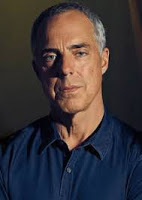 There’ll be no amateur casting session for an imaginary movie version this week, as Prime’s Bosch TV series has been running since 2014, cutting and rewriting many narratives to suit a new era, but maintaining the Neo-noir tone and atmosphere all the way through, its star, Titus Welliver (pictured right), inhabiting the lead’s hoary old mantle like a second skin.
There’ll be no amateur casting session for an imaginary movie version this week, as Prime’s Bosch TV series has been running since 2014, cutting and rewriting many narratives to suit a new era, but maintaining the Neo-noir tone and atmosphere all the way through, its star, Titus Welliver (pictured right), inhabiting the lead’s hoary old mantle like a second skin.(Today’s images come to us as follows: Empty Westminster is courtesy of award-winning photographer, Robert Tinothy, the gloomy cobbled street is from Sai Krishan's blog, The Resplendent Life, the dark wood is by Rosie Fraser, the abandoned swimming pool by Freistellen).
Published on May 18, 2020 07:32
May 5, 2020
True terror tales from an island of mystery

We’ve been graced with some pleasing weather throughout most of this lockdown, which in some ways is adding insult to injury, I suppose. We’re now approaching early summer and the time when so many of us would normally be thinking of going away. Maybe abroad, or maybe to some other part of the UK.
One of the great joys of my life is travelling, and yet, like so many of us, I don’t know when I’ll be able to leave my house again. I certainly can’t see there being any real journeys for quite a long time yet. However, we can dream, which is certainly the story behind my TERROR TALES anthologies.
I’ve been editing these now since 2011, and the emphasis has always been the same, each volume focussing on a different corner of the UK (and maybe, in due course, going far beyond these shores). Each time original horror fiction alternates with factual anecdotes, all digging deeply into that district’s scary legends. Much of which, perhaps inevitably, means folk-horror.
On that same subject, I’ll also today, in my usual unsparing detail, be reviewing Adam LG Nevill’s remarkable novel of extreme folk-horror, THE REDDENING.
If you’re only here to read the Adam Nevill review, that’s fine. As always, you’ll find it at the lower end of today’s blogpost.
First, though, if you have a couple of minutes free, perhaps you’ll also be interested in …
The truth behind the terror
The TERROR TALES anthologies – be they TERROR TALES OF LONDON, TERROR TALES OF THE LAKE DISTRICT or TERROR TALES OF CORNWALL , or any of the seven others we have published so far – primarily contain fiction, though it’s always fiction with a sense of place. When I first commissioned these stories, I asked specifically for material that didn’t just happen to be set in the correct geographic area, but fiction that was atmospheric of it and relevant to it, drawing deeply on the local myth, tradition and history.
And the authors have delivered the goods for nearly a decade now, with at least a couple from every volume being selected for inclusion in Year’s Best anthologies. But even though many stars of the horror genre have graced our pages – we’ve published tales from names as varied as Peter James, Helen Grant, Ramsey Campbell, Thana Niveau and Robert Shearman – I don’t think these TERROR TALES books would be quite the same without the local ‘non-fiction’ anecdotes with which I intersperse the stories.
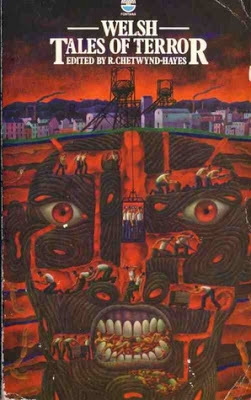 This is an idea I unashamedly pinched from R. Chetwynd-Hayes when he did the TALES OF TERROR books for Fontana way back in the 1970s. Take
Welsh Tales of Terror
, for example (first pub in 1973). You couldn’t read such classics of Gothic and macabre fiction as
Jordan
by Glyn Jones,
The Cry of Children
by John Christopher and
The Shining Pyramid
by Arthur Machen, without first encountering the factual chills of
Old Ben
and
The Cyoraeth
, which lay in between them.
This is an idea I unashamedly pinched from R. Chetwynd-Hayes when he did the TALES OF TERROR books for Fontana way back in the 1970s. Take
Welsh Tales of Terror
, for example (first pub in 1973). You couldn’t read such classics of Gothic and macabre fiction as
Jordan
by Glyn Jones,
The Cry of Children
by John Christopher and
The Shining Pyramid
by Arthur Machen, without first encountering the factual chills of
Old Ben
and
The Cyoraeth
, which lay in between them.My ambition has always been to create as full picture of each region as I can, incorporating as much of its mystery and folklore as possible. And the anecdotes, which I write and edit myself, are a particularly satisfying way to add this essential colour and atmosphere. And remember, as outlandish as it may seem, they DO purport to be true. We don’t make stuff up for this section of each book. That is left to the fiction writers. These many small interludes are, or at least one time were, believed to be the reports of real incidents.
And now, on the basis that you probably fancy sampling some proof of the pudding rather than listening to me droning endlessly on, I’ll quit while I’m on top.
Here, for your complete delectation, are some examples of the true-life (albeit very folkloric) horror that we have published to date in the TERROR TALES series.
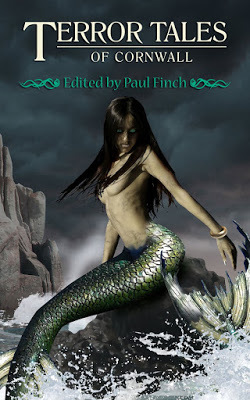 FROM THE LADY DOWNS
FROM THE LADY DOWNS
There is much to interest antiquarians in the far west of Cornwall. Archaeologists and prehistorians abound on the open moors above St Ives, Towednack and Penzance, in particular on the picturesque Lady Downs, where a range of Bronze Age artefacts have been uncovered over the years, and cairns, barrows and ancient stones, some arranged in enigmatic patterns, others standing cold and aloof, hint at the former existence of human settlements whose names and occupants have long passed from memory. If there is any place where the formidable power of the faeries could believably manifest it is here. And indeed, the Lady Downs provide the backdrop to one of the eeriest and yet more well attested tales of human/faerie interaction in modern times. The whole of southwest England was long known as ‘the Summer Land’, largely in reflection of its benign climate. Cornwall in particular, which sits at a southerly latitude in the heart of the Gulf Stream, is famous for its warm summers and amazingly mild winters; in some areas it even boasts evergreen oak trees. This creates a magical aura, which, in a less educated age, was easy to attribute to the presence of mysterious beings. The pixies (or piskies) are a famous Cornish variant on the more traditional faeries and sprites of homespun mythology, but Cornish legend mentions all kinds of little folk, mainly in those areas where there are barrows, ring-forts and dolmens – like the Lady Downs. In the late 18th century, a certain young woman, whose name is given variously as Cherry of Zennor or Jenny Permuen, and whose age was said to be 16, was found wandering on the Downs in a dazed state, with her left eye ‘curious’ – either changed in colour, unable to swivel, or simply and inexplicably blinded. She had apparently gone missing several weeks earlier, having left her home to go looking for work. After much coaxing, the girl, who remained in a confused state, told an astonishing story. She claimed that she was on the road from Zennor to Gulval, which took her across the Lady Downs. Halfway over, at a remote crossroads, she met a handsome gentleman dressed in the manner of a country squire. He appeared to know before she even spoke that she was seeking employment, as he promptly told her that he was a recently made widower who was in need of a housekeeper and nanny for his son. The payment he offered was good, so the girl agreed to accompany him. He led her along a series of moorland paths, ever downward, through a network of deep valleys and gullies, until they reached a place where no sunshine penetrated. Here, there was a beautiful house surrounded by handsome gardens, which bloomed magnificently despite the permanent shade. The boy she was introduced to was very quiet and polite, and once the girl had commenced her job, seemed happy to be left to his own devices. However, one very important duty of the new nanny’s was to anoint his eyes each morning with a mysterious salve, though his father asserted that on no account was she to use this substance on herself. For long periods each day, the widower and his son would disappear from the house. The girl subsequently found that she didn’t have much to do, and so she became bored and inquisitive. Nothing in the house was out of the ordinary, but she’d long noted that the ointment she used on the boy seemed to make his eyes shine. One particularly tedious afternoon, unable to resist temptation, she applied a dab of it to her own left eye. Immediately, the eye began to burn. In agony, she ran outside to a nearby pool, wherein she attempted to wash the ointment away, only to realise that she could now see bizarre things. Firstly, half men/half fish creatures swam below the surface. But then other beings appeared, dancing on all sides of her: men and women who seemed to have adopted hybrid forms, melding their own features into those of animals and insects. Among these terrifying creatures, she spotted her master and his son. The girl fled back to the house, before fainting onto her bed. In the morning, her master, now restored to his normal human shape, informed her that she was dismissed, and offering no explanation why or for what she thought she had seen the day before, he led her away from his home by various, complex paths, finally leaving her dazed and alone on the Lady Downs. The weird tale was taken seriously by the girl’s family, who demanded to be introduced to this strange widower. However, try though she may, the girl was unable to find any path leading down into a permanently sunless valley, on one occasion taking a track which she was sure she recognised, only for it to end at an overgrown tumulus. In due course, the story was written off as fantasy. It was proposed that the girl might have been injured in some other way, maybe even had poisoned herself eating berries or other ill-advised fruits of the moor and had dreamed the whole thing. But Cherry or Jenny, whatever her name actually was, maintained to the end of her days that these things had happened, and was often to be found wandering the Lady Downs on moonlit nights, calling for her former employer in a hopeless, despairing voice.
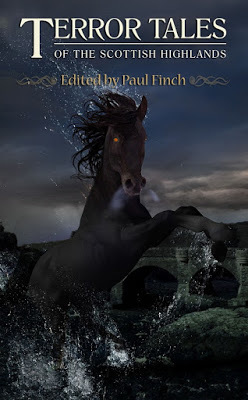 THE BIG GREY MAN
THE BIG GREY MAN
“I was returning to the cairn on the summit in the mist when I began to think I heard something else than merely the sound of my own footsteps. I heard a ‘crunch’, and then another ‘crunch’ as if someone was walking after me but taking steps three or four times the length of my own. I listened and heard it again but could see nothing in the mist. I was seized with terror and took to my heels.” So spoke Professor Norman Collie in 1925, describing an experience he had near the summit of Scotland’s second highest mountain, Ben Macdui, in 1891. It is an account many climbers today will be familiar with, because the unknown beast of Ben Macdui is still one of the most mysterious and terrifying beings in British mountaineering mythology. Ben Macdui itself contributes in no small way to the aura of very genuine fear this oft-told tale creates. Standing 4,295 feet above sea-level on the southern edge of the Cairngorms, it is a remote and lonely peak; it also suffers from extremely severe weather – heavy snow in winter and much mist and fog for the rest of the year. Stories that its high slopes and passes are home to an enormous, aggressive biped have been told for generations. The creature was certainly known about in ancient times, when its old Gaelic name was ‘Am Fear Liath Mor’ (literally ‘Big Grey Man’). In the late 18th century, the great Scottish author, James Hogg, described a blood-chilling encounter with what he estimated was a 30 foot-tall giant, whose close details were hidden in frozen vapour, though Hogg said it was dark of aspect, “like a blackamoor”. In 1903, renowned mountaineer Henry Kellas reported something very similar. In 1943, climber Alex Twenion claimed that he shot three times at a colossal shape in the fog as it lurched menacingly towards him. Shortly afterwards, in 1945, a former mountain rescuer, Peter Densham, a man very experienced in the high peaks of the Cairngorms, told friends how he’d fled the mountain in terror when a massive, two-legged form chased after him. There always seems to be an overwhelming sense of terror and panic in the presence of this unknown thing, though one or two witnesses have hung around just long enough to get a better look at it. They describe a burly, “crudely-made” humanoid form, somewhere between 12 and 20 feet tall, which is either grey in colour, or covered in short grey fur. Its face has variously been described as “malign”, “inhuman”, “apelike”, or weirder still, “non-existent”. Owing to the harshness of the terrain, no major searches have ever been launched on Ben Macdui, but the majority of the sightings centre around the Lairg Ghru Pass, and perhaps not surprisingly, more than a few climbers no longer use that route. Theories abound as to what the Big Grey Man could actually be. An optical illusion is one possibility: mountain mist, refracting sunlight, rapidly altering perspectives and so on, with the accompanying panic caused by exhaustion in the presence of this awesome landscape. However, other theorists dismiss this explanation as too pat, pointing to the very solid, very real nature of the phenomenon so many reliable witnesses claim to have experienced. One question raised is could the Big Grey Man be a relict woodwose – a mysterious hominid rumoured to have lived in the very wild parts of Britain during the Middle Ages, and supposedly glimpsed much more recently in the Highlands – in effect, a Scottish Bigfoot? The reasons why this must be nonsense are almost as many as those given for why the North American Bigfoot must be nonsense, and yet – as in North America – the reported sightings continue. As usual in these kinds of cases, no real answer will be possible until some carcass or other type of physical evidence is discovered. For as long as it isn’t, scary rumours will persist that an unknown something prowls the desolate slopes and icy ridges of Ben Macdui.
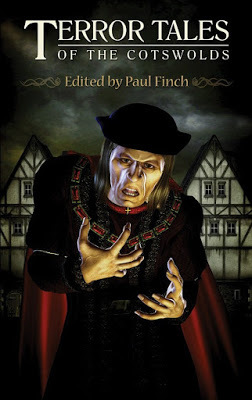 THE GRIMMEST CASTLE IN ALL ENGLAND
THE GRIMMEST CASTLE IN ALL ENGLAND
The murder of King Edward II in 1327 is one of the grisliest tales in English history. And in the shape of Berkeley Castle, in southern Gloucestershire, it boasts one of the most ominous backdrops imaginable: a lowering structure which so emanates menace that even today it is associated with monsters, witchcraft and evil spirits. Berkeley Castle was built in 1067 by a powerful Norman family, the FitzOsberns. Such strongholds had appeared all over England in the wake of the Norman Conquest, and were rightly viewed by the population as symbols of oppression, but Berkeley Castle was more feared than most as it was constructed on the site where an infamous Saxon witch had once made her home, and stories were soon circulating that the evil lurking within its mighty walls was more to do with the black arts than with the cruelty of foreign despots. The story of the Berkeley Witch was already a famous folktale when the Normans arrived in England. It concerned a wealthy Saxon matron who, after living for many years in a fine timbered hall, on the exact spot where the castle would later be built, confessed to her family that her good fortune was the result of a pact with the Devil. After her funeral, it was reported that the chapel where her coffin was kept was inundated with nightmarish demonic forms, one of which finally broke open the casket and bore the woman’s corpse away on a horse covered with spikes. The corpse was said to have been impaled on these spikes, and witnesses claimed that it screamed in agony. In an associated legend, a supposed monster, a gigantic toad that fed on human flesh – possibly the witch’s familiar – was also believed to inhabit the site and in later decades, after the castle was built, it would reputedly wander through secret passages and spring out on the unwary. And indeed, an immense, unnaturally bloated toad was recovered from a recess in the castle cellars and killed during the reign of Henry VII, (1485-1509). Of course, none of these stories are provable, but the one tale of Berkeley horror for which there is much documented evidence concerns the fate of Edward II. Son of the famous warrior king, Edward I, who conquered Wales and was also known as the ‘Hammer of the Scots’, Edward II made enemies on all sides simply because, by comparison, he was very weak. He was supposedly fonder of poetry and sailing than of fighting, which in the early 14th century were not kingly activities. And when he was defeated by Robert the Bruce at the battle of Bannockburn in 1314, few of his nobles were surprised, though many were furious as they’d lost friends, relatives and retainers en masse, and more importantly, they’d lost their holdings in Scotland. Edward also incurred hostility by showering favours on ambitious but unpopular young courtiers like Piers Gaveston and Hugh Despenser. There was no proof that Edward was homosexual. He had at least two female partners and fathered five children. But accusations of ‘sexual perversion’ were a useful scandal to spread when one was stirring discontent. His barons’ real gripe was that, despite his many failures, he refused to subject himself to the will of Parliament. When in 1326, Roger Mortimer, a powerful marcher-baron, with the full connivance of his lover, Queen Isabella, Edward’s aggressively opportunistic wife (so aggressive that she was known as the ‘She-Wolf of France’), rose in rebellion and deposed Edward, there was general satisfaction. But this was not to last. Edward’s eldest son, also called Edward, was a minor, and his mother, Isabella, and her lover, Mortimer, intended to rule England from behind his throne, which was not widely popular. This made it problematic for them that the older Edward was still alive, even though he had officially abdicated. As long as he lived, even in custody, the former king could be the rallying point for a counter-revolt. It was unthinkable that one of royal blood should be murdered, so Isabella and Mortimer opted to bring about Edward’s demise by ‘natural means’. He was imprisoned in Berkeley Castle, and put in the custody of two extremely brutal gaolers, Gurney and Maltravers, who were charged with literally mistreating him to death. Edward was enclosed in an odious cell, which only a metal grille separated from the castle’s main cesspit. The stench was said to be suffocating, but to make matters worse, Gurney and Maltravers also piled rotting animal carcasses in the pit. Edward lingered for months amid these foul humours, weeping and begging for release. In addition to this torture of the senses, he was given only decayed food to eat and stagnant ditchwater to drink. But somehow he survived. Mortimer, becoming increasingly uneasy as opposition to his haughty rule grew, finally ordered the two gaolers to do their worst. Edward had to die, by any means, so long as there were no telltale marks left on his body. The wicked duo thus stripped their captive naked, and one held him down on his bed while the other inserted a metal funnel into his anus. A red-hot poker was then thrust through the funnel, burning out his innards. The grotesque act was said to have lasted for minutes on end, and Edward’s shrieks could be heard in the countryside beyond the castle walls. Initially the plan was successful. Edward’s unblemished body received a royal burial at Gloucester Cathedral, but still there was resentment towards the new government. When in 1330, the young Edward turned eighteen and was crowned Edward III, he immediately had the conspirators arrested for the murder of his father. Roger Mortimer was hanged, drawn and quartered at Tyburn, a process which in the Middle Ages was no less gruesome than it sounds, while Isabella was imprisoned for life at Castle Rising in Suffolk, where she finally died shrieking with insane laughter. This laughter is still reportedly heard on dark winter nights at Rising, just as the unfortunate Edward II’s appalling screams can be heard ringing though the gloomy passages of Berkeley Castle.
THRILLERS, CHILLERS, SHOCKERS AND KILLERS …
An ongoing series of reviews of dark fiction (crime, thriller, horror and sci-fi) – both old and new – that I have recently read and enjoyed. I’ll endeavour to keep the SPOILERS to a minimum; there will certainly be no given-away denouements or exposed twists-in-the-tail, but by the definition of the word ‘review’, I’m going to be talking about these books in more than just thumbnail detail, extolling the aspects that I particularly enjoyed (I’ll outline the plot first, and follow it with my opinions) … so I guess if you’d rather not know anything at all about these pieces of work in advance of reading them yourself, then these particular posts will not be your thing.
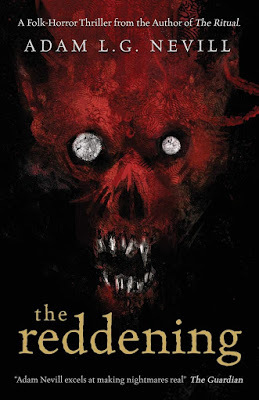 THE REDDENING
by Adam LG Nevill (2019)
THE REDDENING
by Adam LG Nevill (2019)
OutlineThe area around Divilmouth on the South Devon coast is one of exceptional beauty. But at the same time, it’s rugged and stormswept. Not only that, it’s hemmed to the sea’s edge by towering cliffs and wild, expansive moorland, all of which means that it’s more likely to attract extreme sportsmen than everyday tourists. One such is paraglider Matt Hull, a sturdy outdoorsman who comes to enjoy his five minutes of fame when he takes to the air off a high point near the fishing village of Brickburgh, only to witness a minor landslide and the subsequent exposure of a fissure in the rock face. When he investigates the fissure, it leads through to a previously unknown cave system, though almost immediately there is something not entirely wholesome about this find.
Perhaps it’s to do with the countless human bones that scatter the dank interior.
Not far away meanwhile, in one of the most terrifying early scenes in a novel that I can remember, coastal walkers and campers, Shelly and Greg, pitch their tent in a remote spot and are immediately assailed by a weird flock of horned black sheep, their fleeces ragged and matted with dung. If that isn’t bad enough, the shepherds then turn up. Quite a few of them. Naked, armed with brute weapons and painted bright red from head to foot.
We now move ahead two years to a time when Brickburgh has become famous. The local caves are still being excavated, but large sections have been opened to the public and a mini museum has sprung up. Quite simply, the site is deemed the most remarkable archaeological find of many decades, and the local tourist trade has received a massive and timely boost. But again, there is something vaguely unedifying about all this. The network of caverns that Matt Hull discovered once contained a fully functioning Stone Age community that was previously unknown in the fossil record, but which occupied the site for several centuries, maybe even millennia, and left behind uncountable trace evidence of their lifestyle and beliefs. But there are oddities too, along with quite a few nasties. Whoever this particular tribe were, not only did they indulge in ritual human sacrifice on a colossal scale, (the numbers of carved-up bones and skulls would have put the Aztecs to shame), they apparently practised cannibalism. There are even clues that they did diabolical things with the remains of their victims, turning them into jewellery, drinking vessels and the like, the kind of thing only normally associated with degenerate societies, and something never encountered previously in explorations of Britain’s prehistoric past.
One person who’s distinctly unimpressed is local lifestyle journalist, Katrine, or Kat, who, formerly a topnotch London reporter, has escaped a traumatic domestic past and sought refuge in this quieter corner of the country. Though the frivolous material she produces doesn’t satisfy her, the exciting if gruesome archaeological find is something she’s also struggling to consider a positive. Infinitely more intrigued, though, is her energetic and much younger boyfriend, Steve, a digital marketer by profession, though he contributes freelance articles to the press and dreams of making it as a big-name newshound.
Further north in Walsall, meanwhile, single mum, Helene, is trying to cope with the fallout of a family suicide. Her younger brother, Lincoln, a troubled kid and one-time addict, seemed to find a new lease of life when he got interested in the ‘Sounds of the Earth’, seeking and recording primitive natural music in deep caves and gorges, only to then, for no known reason, take his own life during a trip to the West Country (though his body was never found). Helene listens to his ‘SonicGeo’ tapes and is bewildered to hear bizarre chatterings, grunts, growls and even what sounds like guttural chanting, all supposedly recorded in caves down in Devon.
She follows his meandering route but gains no satisfaction, especially when it leads her to the ramshackle Redstone Cross Farm on the moors over Brickburgh, the weird occupants of which give her an ultra hostile reception and even threaten to set a pack of ridiculously savage guard dogs on her.
Kat, meanwhile, still seeking a new angle on the excavation, doesn’t think she believes in the so-called Brickburgh Curse, whereby those living close to the caves suffer nightmares and depression (even though she lives only seven miles away and has exactly these symptoms!), until she interviews Matt Hull again and finds him a shadow of his former robust self. Hull no longer paraglides but tells Kat that this is because he was threatened by the ‘red folk’, a group of unknown oddballs, painted red, whom he says he saw attacking and killing a couple of campers two years ago. Even though he tries to link this with other disappearances and so-called suicides in the area, Kat is unconvinced there is a story as Matt is rambling as if he’s had a severe breakdown.
Steve, on the other hand, wonders if it means there is something in the rumours that cannabis plantations are operating on the nearby hills and thinks he can sniff a scoop. When the twosome meet Helene at a village fair, and she tells them about her ugly encounter at Redstone Cross Farm, Kat connects this to the non-story that is Tony Willows, a 1970s folk-rocker who, after several well-publicised drugs-related incidents, and a brief jail term, adopted a reclusive lifestyle up there with his long-term partner, Jessica Usher. But Steve is certain that this is the location of one of the much-rurmoured cannabis factories, and as Kat won’t help him (because she sees him as all enthusiasm and little else), opts to break the case on his own.
Despite her stern advice, he journeys up there solo, and finds Redstone Cross Farm every bit the rundown rural dump that Helen described. He finds other things too, things he could never have conceived of in his maddest dreams. Crazy things, abominable things. And by his mere presence opens a Pandora’s Box that will go on to engulf the entire district in a wave of cult horror that becomes mind-boggling in its viciousness …
ReviewOne thing you can always be sure of with an Adam Nevill horror story is that it will be frightening. And this is guaranteed. Nevill does not do vanilla scarefare, and yet he doesn’t rely on gaudy displays of carnage to cow his readers either. I mean, there is carnage in The Reddening , and lots of it, but that’s not by any means the whole thing.
Nevill’s real skill is his ability to inject seemingly mundane situations with an otherwordly sense of abject dread. Without going over the top in terms of gore, but relying more on suggestion and off-kilter imagery – a vivid dream of jackal-headed figures in smoke, apelike mouths sucking on human bones, a lost hiker stumbling to an isolated farmhouse only to find its occupants painted red – he seems effortlessly able to make his audience, hardened to horror though it usually is, really, really glad that they aren’t in the same predicament as his protagonists.
He completely achieves this in The Reddening . But in several ways.
Firstly, in the gradually drip-fed idea (there are no intrusive dollops of expo here) that a barbaric cult could exist unseen just beneath the surface of modern Britain, even in so quaint a corner of the country as South Devon. That, despite genteel appearances, you can’t trust anyone. That your next door neighbour might mow his lawn and walk his dog, but that he might still kill and eat people come nightfall. This is nothing new in the paranoid horror/thriller fiction of our current age, but in The Reddening the author ramps it up dramatically, deepening the violence and derangement of these secret enemies of society, intensifying their beliefs, and in so doing creating a whole new universe of secret mysticism and pagan brutality, and tackling it from archaeological and scholarly angles as well as via myth and rumour, which lends it plausibility and an air of impending threat that is almost tangible.
Secondly, in his timely targetting of the folk-horror vibe. The revival of interest in that age-old subgenre shows no sign of slackening, and The Reddening rides that wave to its fullest extent. Even though the rituals and totems here are mostly invented and owe nothing to any known antiquity, Nevill delves back convincingly into forgotten ages when the gods and the land were one, when belief in and obedience to local lore was paramount, when life and society were controlled by the changing seasons and the many ceremonies enacted to keep things beneficial (no matter how costly they might be in terms of sacrifice). But don’t be thinking that The Reddening is just another story of village witchcraft. There is sorcery of a sort, but the latent powers here owe to forces older and more primal than Christianity or the Celts, and way, way more terrifying.
On top of all this, Nevill successfully depicts folklore as it is seen through the prism of the modern world. None of it is initially taken too seriously. It almost seems silly and even sad, with eccentric loners like Lincoln seeking meaning from those ‘sounds of the Earth’ that he’s recorded, while the presence of 1970s folk-rockers (now turned into scuzzy relics of another bygone era), harks back nicely to the first wave of interest in ancient rural beliefs, the presence behind their hippie façade of extensive drug use raising questions not just about how quickly and easily the idealism of those early counterculture movements was hijacked, but how easily it still is.
Thirdly, and perhaps more importantly than any of this, Nevill hits us where it hurts in terms of his monster terror, which, as always, is second to none. This author has long believed that showing less is more. In his 2011 novel, The Ritual , for example, the heroes of the tale were pursued through a deep and trackless forest by an appalling something that, though we barely glimpsed it, played on all our deepest imaginings and thus was so utterly nightmarish that by the end, if we’d seen it in full even on the final page, it would inevitably have disappointed, enabling him to maintain the knife-edge terror right to the last paragraph. Likewise, in his short story, Where Angels Come In , another of the most frightening things I’ve ever read, as the central character is again beset by ghastly hybrid things whose bizarre appearance the author only hints at rather than describes in detail, the result is nerve-shredding.
And it’s exactly the same in The Reddening , the main antagonists of which we hear and smell and cast fleeting glances at, or see in crude relief on ancient cave walls, but mainly which we run from with minds reeling, the horror and shrieks of their victims ringing in our ears. There is more to it even than this, though, because in The Reddening the monstrosities to which the red folk are enthralled are not even completely real; at least, they don’t belong in our plane of existence. These are true deities, utterly inhuman and unknowable progenitors (or maybe products!) of a complex, multi-generational belief system, and so irreversibly and violently hostile to all but their acolytes, (and even to their acolytes, if we’re truthful) that all notions of Satan, Cronos or Loki are rendered impotent by comparison.
So, Nevill hits us with a three-pronged attack, barely giving us a moment to reflect once we get into the action, and that isn’t even taking into account his several cleverly-constructed and again, intensely frightening set-pieces: a desperate battle with the open water, a dirty rundown farm in the middle of nowhere, so odious to look at and so full of squalid degenerates that the house in The Texas Chainsaw Massacre offers hearty welcome in comparison. And then, after all that, there is a whole series of abductions, murders and dismemberments, which pluck at the worst of our innate knowledge of cult fanatics, serial killers, rapists and cannibals. This is full-on horror, and all of it coming headlong at a bunch of heroes who are total everymen.
Or perhaps that should be everywomen.
In an age when female characters in thrillers and horror stories are gaining centre-stage more than ever before, often taking on the mantle of supercop or even superhero, it makes a refreshing change to see the two stars of this gruesome saga as ordinary women with common-garden problems. Both have love issues and personal hang-ups. Helen is juggling single parenthood with trying to look out for her errant, drug-addled brother, while Kat feels that she’s let herself go both physically and professionally, the ace reporter she once was still vaguely ambitious but now overly cynical, and confined to writing stuff that’s only of marginal interest. Neither of them has ever experienced anything that will prep them for the horrors to come, which is why they will suffer so harrowingly and believably.
In some ways it’s almost demoralising to find our fictional heroes as frightened of the unfolding terrors as we ourselves would be, to see them thinking only of running for their lives rather than fighting … until the fight becomes unavoidable, of course, and then, when it does occur – whoa! Nevill doesn’t hold back in his depiction of just how painful and debilitating one heavy punch can be, or in showing what it really means to hit someone in the head with a blunt instrument, or in his argument that even the most sophisticated persons have homicidal apes lurking just underneath. All of which adds subliminally to the devil’s brew that is The Reddening , because it makes it seem grittily real, and serves to remind us how swiftly an ordinary, civilised (and secular!) society might wilt in the face of a ferocious, committed (and ultra-zealous!) foe. You’d probably win in the end, but at what cost? And would you even recognise yourself afterwards?
Adam Nevill enjoys a long-standing reputation for purveying strangely disturbing horror. And The Reddening is another chapter in that story. It’s a tense and engrossing thrill-ride, at times so frightening that it’s genuinely disorienting. It draws deeply on a well of eldritch evil that most us civilised folk hope was never actually there, but which we still find fascinating and horrifying. Even if you skirt around the edges of this worrying horror novel, its dark magnetism will drag you in. The power of The Reddening goes deep.
This is one I would dearly love to see adapted for film or TV, though only an 18 certificate would work in this case if the full impact of the novel was to be replicated on screen. Given that The Ritual made it, that may not be so vain a hope, and thus I must get my own casting demands in quickly. Here we go …
Katrine – Vicky McClureHelene – Sophie CooksonMatt Hull – Paul AndersonTony Willows – Oliver TobiasJessica Usher – Rita TushinghamFinn Willows – Richard BrakeNana Willows – Lysette AnthonyDetective Lewis – Eddie Marsan
Published on May 05, 2020 02:25
April 15, 2020
No despair yet; top books coming your way
 Well, these are difficult times indeed, and even if it was appropriate to strike my usual cheery note, I think, being honest, that I’d struggle to do it convincingly. Like most of you, I imagine, I’m currently confined to my house. I mean, I’m a self-employed writer anyway, so working from home is hardly onerous, but having only limited access to the great outdoors, especially as the nice weather is now starting to show itself, is a new and bewildering experience.
Well, these are difficult times indeed, and even if it was appropriate to strike my usual cheery note, I think, being honest, that I’d struggle to do it convincingly. Like most of you, I imagine, I’m currently confined to my house. I mean, I’m a self-employed writer anyway, so working from home is hardly onerous, but having only limited access to the great outdoors, especially as the nice weather is now starting to show itself, is a new and bewildering experience.
Of course, things are much worse for some people in that they’re ill or bereaved (or both); this is certainly a crisis the like of which we haven’t faced in a hundred years. But I’m not going to dwell too much on that at present. The rest of us have a duty, I think, to try and keep things going if we can.
Hence today’s blog, in which, for reasons I’ll shortly be outlining, I’ll be discussing horror anthologies (two in particular: AFTER SUNDOWN, edited by Mark Morris, and more imminently, published tomorrow in fact, the ALCHEMY PRESS BOOK OF HORRORS 2, edited by Peter Coleborn and Jan Edwards. In that same vein, I’ll offering a detailed review of the original ALCHEMY PRESS BOOK OF HORRORS, again as edited by Coleborn and Edwards. You’ll find that review in the usual place at the lower end of today’s blogpost (with my normal bit of fantasy film-making tagged on at the end of it).
Before that though, here’s some relevant information …
Cancellations
For all that I’m trying to be positive, today’s blog, perhaps inevitably, is a kind of damage limitation exercise. Because as recently as early last January, I was boasting about the exciting programme of events that lay ahead in 2020 … and yet now, as you can probably guess, it’s been totally decimated.
Three major events that I was looking forward to – CRIMEFEST in Bristol, STOKERCON in Scarborough, and the THEAKSTON CRIME WRITING FESTIVAL in Harrogate – have all been either cancelled or postponed (more info about what will ultimately happen with these, if there is any, when I get it), and it’s difficult imagining that other events will not go the same way soon, certainly those scheduled to occur in the next two or three months.
CRIMEFEST and HARROGATE were primarily fun things from my perspective, opportunities to hook up with lots of friends and fellow thriller writers, air my views on a couple of panels and basically have a riotous time. But STOKERCON had more of the working day about it in that, as one of the guests, I was due to participate in the launches of two new horror anthologies that I am fortunate enough to have stories included in.
Of course, a whole array of wonderful new novels, anthologies and collections would have been published during that great event on the Yorkshire coast, each at their own special launch party, which would have been attended by hundreds of horror fans who now, sadly, are watching the year go by through their front windows. But on a more positive note, many if not most of those titles will still be launched, only now online.
New titles
Among them are the two books I’m so honoured to feature in – the ALCHEMY PRESS BOOK OF HORRORS 2 and AFTER SUNDOWN .
Today therefore, I’m pleased to present the artwork and back-cover blurb for the first of these two new anthologies, and the full (and very mouthwatering) tables of contents for both of them. Seriously guys, check out some of the authors who’ve here been recruited:
ALCHEMY PRESS BOOK OF HORRORS 2 ed. by Peter Coleborn and Jan Edwards
Published by Alchemy Press. Available from this Thursday (April 16).
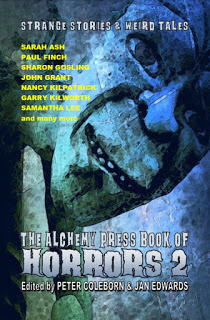 Strange stories and weird tales and all of the creeping horrors in between.
Strange stories and weird tales and all of the creeping horrors in between. Horrors 2 features seventeen fabulous writers, including Sarah Ash, Paul Finch, John Grant, Nancy Kilpatrick, Garry Kilworth, Samantha Lee … to lead you on a spine-tingling tour from seaside towns to grimy cities, to the lonely and secret places, from the fourteenth precinct to Namibia … and so many places in between.
Table of Contents
Henrietta Street – Gail-Nina AndersonI Left My Fair Homeland – Sarah AshI Remember Everything – Debbie BennettDigging in the Dirt – Mike ChinnWhat Did You See? – Paul FinchEvery Bad Thing – Sharon GoslingThe Loneliest Place – John GrantThe Primordial Light – John HowardBlack Nore – Tim JeffreysFootprints in the Snow – Eyglo KarlsdottirPromises – Nancy KilpatrickLirpaloof Island – Garry KilworthThe Secret Place – Samantha LeeBeneath Namibian Sands – Pauline MorganThe Hate Whisperer – Thana NiveauHydrophobia – John Llewellyn ProbertWe Do Like to Be Beside – Peter Sutton
AFTER SUNDOWN ed. by Mark Morris
Published by Flame Tree Press. Published in October but available for pre-order now

Table of Contents
Butterfly Island – CJ TudorResearch – Tim LebbonSwanskin – Alison LittlewoodThat’s the Spirit – Sarah LotzGave – Michael BaileyWherever You Look – Ramsey CampbellSame Time Next Year – Angela SlatterMine Seven – Elana GomelIt Doesn’t Feel Right – Michael Marshall SmithCreeping Ivy – Laura PurcellLast Rites for the Fourth World – Rick CrossWe All Come Home – Simon BestwickThe Importance of Oral Hygiene – Robert ShearmanBokeh – Thana NiveauMurder Board – Grady HendrixAlice’s Rebellion – John LanganThe Mirror House – Jonathan Robbins LeonThe Naughty Step – Stephen VolkA Hotel in Germany – Catriona WardBranch Line – Paul Finch
So, there you are, short story and horror buffs. There’s no reason to despair yet.
The year 2020 won’t exactly be business as usual, but a lot of industry people are still hard at it, despite being isolated at home, and doing their damnedest to keep bringing you the very best in dark and thrilling fiction.
So, keep reading. And if you’re a writer, keep writing. But more important than any of this, do all those sensible things and stay safe.
THRILLERS, CHILLERS, SHOCKERS AND KILLERS …
An ongoing series of reviews of dark fiction (crime, thriller, horror and sci-fi) – both old and new – that I have recently read and enjoyed. I’ll endeavour to keep the SPOILERS to a minimum; there will certainly be no given-away denouements or exposed twists-in-the-tail, but by the definition of the word ‘review’, I’m going to be talking about these books in more than just thumbnail detail, extolling the aspects that I particularly enjoyed … so I guess if you’d rather not know anything at all about these pieces of work in advance of reading them yourself, then these particular posts will not be your thing.
 ALCHEMY PRESS BOOK OF HORRORS
ed. by Peter Coleborn and Jan Edwards (2018)
ALCHEMY PRESS BOOK OF HORRORS
ed. by Peter Coleborn and Jan Edwards (2018)
A glowing example of the sort of horror anthology we can hopefully expect to see more of in the future. Alchemy are part of the independent press, but you wouldn’t know it from the quality of this latest eye-catching product.
With the major publishing houses seemingly completely uninterested now in putting out collections of short horror fiction, many names from the small press have stepped into the gap. But most of them, Alchemy evidently included, are now well aware that the old-fashioned method of producing ragmag lookalikes in blotchy ink, stapled together unevenly and filled with text that hasn’t even been checked for spelling or literals will simply not do anymore. Hence this very, very fine opening installment in what is intended to be a brand-new annual series.
But Alchemy haven’t stopped simply at creating a beautiful-looking book; they’ve also exercised intense quality control re. its contents because there are some expertly crafted stories in here, from voices both old and new, and each one of them original to this publication.
Rather than simply hit you with a succession of brief short story outlines, I’ll initially let the publishers give you their own official blurb, which drops strong hints about the shocks and shivers to come. And then we’ll discuss them in a little more depth.
Twenty-five tales of horror and the weird, stories that encapsulate the dark, the desolate and the downright creepy. Stories that will send that quiver of anticipation and dread down your spine and stay with you long after the lights have gone out.
Who is Len Binn, a comedian or something worse? What secrets are locked away in Le Trénébreuse? The deadline for what? Who are the little people, the garbage men, the peelers?
What lies behind the masks? And what horrors are found down along the backroads?
With stories by Ramsey Campbell, Storm Constantine, Stephen Laws, Samantha Lee, Stan Nicholls, Tony Richards and many, many others ...
The independent press, both in the UK and the US, has long been the secret hope of horror anthology fans, with fewer and fewer of these types of books coming from mainstream publishing houses. But whereas in the past, the small press was often a byword for low production standards, these days nothing could be further from the truth.
That said, Alchemy, a UK-based outfit run by the editors of this particular tome, Peter Coleborn and Jan Edwards, have been trading for some time on the understanding that they only ever bring books out with a high-spec finish. So, I’m absolutely delighted to see that their long-awaited horror anthology series is now at last rolling.
And on a first reading, the Alchemy Press Book of Horrors has been well worth the wait, both looking and feeling amazing. In appearance alone, with a stunning cover by Coleborn himself, it would grace any shelf of classic collections. The big question, though – the only question to many – is how does it read?
Well, like all bunches of stories, there will be some that appeal and some to pass over, and of course it’s all subjective, so for every reader it will be different. However, I personally was very enthused by this anthology as a whole.
My first impression was that it does what I expected in that it cleaves closely to the kitchen sink. I don’t mean that in any detrimental way; I mean that many of its tales concern ordinary people and occur in everyday situations common to working/middle class life. So, we’ve not got much here in the style of MR James’ Edwardian ghost epics or Pan Horror-type essays in extreme ghoulishness. All the contributions to the Alchemy Press Book of Horrors are a tad more surreal than that anyway (and by that I don’t mean experimental), but many also have a strong aura of work-a-day Britain, and could easily happen in your own town, maybe in the next street to yours.
For example, in Some Kind of a Laugh , the ever-reliable Ramsey Campbell introduces us to underpaid waiter, Bernard, who is permanently frustrated by the fact that people confuse him with Lancashire comic, Len Binn. Things get worse, though, when Binn literally dies on stage right in front of him, and Bernard now finds himself adopting more and more of the deceased comedian’s mannerisms.
Then we have Keris McDonald’s Remember , in which blue-collar tough guy, Mike, is furious when dogs start going missing from the kennels where he works. It’s November 5, so the poor animals are in a state of terror anyway. But Mike opts to keep watch all night, and hopefully catch the thief. He’s unaware that, even though this is a crumby corner of a typical industrial town, he’s about to encounter an ancient and chilling mystery.
The mundane also clashes with the bizarre in Stephen Laws’ superb Get Worse Soon , much of which is set in a thrift store (more about this one shortly), and especially so in Cate Gardner’s The Fullness of Her Belly , in which we meet Ella, a mental outpatient who can only satisfy her constant craving to be pregnant by making cushion babies and stuffing them up her dress. Fellow patients consider this a harmless eccentricity until she one day tells them that the ‘babies’ she’s discarded have now taken over her house and killed her friend.
Not that editors, Coleborn and Edwards, have gone looking solely for glum situations set in Broken Britain. It would be untrue to say that there isn’t also a touch of the exotic in the Alchemy Press Book of Horrors .
For instance, Mike Chinn’s Her Favourite Place has an undersea location (more about that one soon), while Too Late by the recently deceased and already much-missed John Grant is set in central Spain (more about this one soon, as well). Peter Sutton’s Masks , meanwhile, takes us to one of the most far-away places of all, a desert island, where castaways reduced to the level of beasts survive by occasionally donning animal masks and reluctantly hunting one of their own, only for a kind of salvation to arrive in the form of another ship, also wrecked, its unsuspecting survivors swimming desperately for shore.
If that latter story hints at savagery, I would say again that we’re not dealing with Pan Horror-type bloodletting in this book. There is little to no sadism here for its own sake. It happens, but it’s mostly off the page. But then these are horror stories, and there is no shortage of stuff in the Alchemy Book of Horrors to be disturbed about.
For instance, in Phil Sloman’s The Girl with Three Eyes , a disturbed college student is gradually drawn to violence by her obsession with a fellow student whom she is convinced is using a hidden third eye to manipulate all those around her. In Ray Cluley’s extraordinary Bluey , which is set in an urban comprehensive school, there is extreme and graphic brutality, though it’s all done very differently from the norm; despite that, it’s a dark story, this one (again, more about it later).
Many modern horror authors tend by nature to eschew extreme gruesomeness and instead are students of what might be called ‘the strange’. And there is much of that on show here too. I should point out that strange horror stories are not always my favourite, especially if the only thing about them is their strangeness, but combine that with mystery, suspense and the macabre, and you’ll often have a winner. And once again, we find that in the Alchemy Press Book of Horrors .
In this vein, Storm Constantine’s La Trénébreuse takes us deep into rural France, where a young couple attend the palatial home of an old pal. They find it a sprawling country estate, dreamy and mysterious, but who is the female entity said nightly to roam the grounds on the back of a lion?
If that doesn’t sound strange and spooky enough for you, try out James Brogden’s The Trade Up , wherein Charlie, a worn out suburbanite, is heading home late after a conference only to be menaced on the motorway by an apparent doppleganger driving exactly the same make and model of car as his own.
Or how about Stan Nicholls’ Deadline , in which a young woman, April, struggles to balance single motherhood with her writing career, at which point, completely inexplicably, familiar fixtures in her disorderly life start, one by one, to disappear?
Ultimately, of course, the test of any horror anthology is whether or not it scares you, and this is the point where so many of the ones I’ve read over the years have come unstuck. I’ll be honest and admit that it’s now been a long while since I read any antho containing more than one or two stories that really gave me the heebie jeebies, but I’m glad to report that the Alchemy Press Book of Horrors does not let us down in this regard.
Again, I wouldn’t say that we’re looking at extreme terror here – you are unlikely to lose sleep – but this book contains some excellent stories, the mere concepts behind which, let alone the skilled execution of them, will easily be enough to give you the shudders.
In Gary McMahon’s very traditional Guising , a respectable widow is increasingly frightened, not just because she lives alone on a suburban housing estate that is dark and quiet at night, but because as Halloween approaches, she repeatedly sees a strange figure draped in bubble-wrap standing at the end of her street. That one’s a bone-chiller, though it’s run close by Adrian Cole’s Broken Billy , in which we meet Bran, who, out on his remote farm, uses Wiccan magic to animate his collection of scarecrows with a weird kind of half-life. He originally gathered them from other farms to fix them, but now they’ve become his friends … he thought. Because when Tracey enters his life, everything changes, one scarecrow in particular, Broken Billy, taking a strong dislike to the new situation.
For all that – and scarecrows are perennial figures of evil to me – possibly the scariest tale in the book is Gail Nina-Anderson’s An Eye for a Plastic Eyeball , which sees oddment collector, Scott, persuaded by the mysterious Miss Stonecraft to visit the house of an old teacher, now dying in a hospice but with a lifetime of scientific curiosities to her name. He finds the eerie house a treasure trove of the arcane, but there is something about it he doesn’t quite like, and with very good reason.
All round, the Alchemy Press Book of Horrors is an admirable way for one of the busiest independent presses in the game to kickstart what hopefully will be a long-running series of horror anthologies. I found it a fast and suitably unnerving read. Here’s hoping there are many more to come.
And now …
ALCHEMY PRESS BOOK OF HORRORS – the movie.
Just a bit of fun, this part. No film maker has optioned this book yet (as far as I’m aware), but here are my thoughts on how they should proceed, if they do.
Note: these four stories are NOT the ones I necessarily consider to be the best in the book, but these are the four I perceive as most cinematic and most right for adaptation in a compendium horror. Of course, no such horror film can happen without a central thread, and this is where you guys, the audience, come in. Just accept that four strangers have been thrown together in unusual circumstances, which require them to relate spooky stories.
 It could be that they are trapped in a cellar by a broken lift and are awaiting rescue (a la Vault of Horror). Or maybe they first appear as comic-book characters, as read about by young Billy in an eerily quiet town (an English version of Creepshow, anyone?), but basically, it’s up to you.
It could be that they are trapped in a cellar by a broken lift and are awaiting rescue (a la Vault of Horror). Or maybe they first appear as comic-book characters, as read about by young Billy in an eerily quiet town (an English version of Creepshow, anyone?), but basically, it’s up to you.Without further messing about, here are the stories and the casts I would choose:
Bluey (by Ray Cluley): Struggling teacher, Shaun, attempts to teach his unruly class about inclusivity by cutting Bluey, the lifesize effigy of a human being, out of a piece of blue card and having them damage and insult it. Over the next few days, however, as Shaun progressively loses control, the tortured shape of Bluey becomes a haunting presence in his classroom …
Shaun – Russell Tovey
Her Favourite Place (by Mike Chinn): Married couple Clarrie and Lois have spent weeks on a deep-sea farm, monitoring a crop of genetically modified kelp. But all is not well. The women, whose relationship is abusive anyway, are slowly going stir-crazy. Outside the capsule meanwhile, an unusual swarm of white growths is starting to blight the crop …
Clarrie – Claire FoyLois – Samantha Bond
Get Worse Soon (by Stephen Laws): Misanthrope Colin buys everything from the local Quidstore, but when he one day acquires a set of ‘Get Worse Soon’ letters and jokingly sends them to people he dislikes, and those people die, the shop denies ever having stocked such an item. Colin is furious and opts to send a letter to the Quidstore manager to prove his point, but mix-ups happen …
Colin – Michael Sheen
Too Late (by John Grant): Griff and Heidi take a holiday in a villa in central Spain, hoping to repair their failing marriage. But it isn’t working. Lovely Heidi is cool and indifferent to Griff despite all his attempts at romance. Increasingly, however, Griff becomes fascinated by the villa across the valley and the woman who often sunbathes naked and who looks eerily like Heidi …
Griff – Richard ArmitageHeidi – Carice van Houten
Published on April 15, 2020 01:54
April 3, 2020
First glimpse of my latest: ONE EYE OPEN
 I’m very proud today to be able to unveil the cover to my next novel, ONE EYE OPEN, which will be out in August. I’ve been hammered with questions about this recently, and in today’s blog shall endeavour to answer the main ones.
I’m very proud today to be able to unveil the cover to my next novel, ONE EYE OPEN, which will be out in August. I’ve been hammered with questions about this recently, and in today’s blog shall endeavour to answer the main ones.
However, I will admit straight away that this book marks a bit of a departure for me, in that it’s a free-standing cop thriller rather than part of an ongoing series.
On the subject of departures, also in today’s blog, I’ll be reviewing and discussing Stuart MacBride’s breakneck actioner, HALFHEAD. Most of you will know Stuart as one of Scotland’s premier crime writers, but this one marked a big change for him in that, though it still involves cops and criminals, it is set in a Dystopian sci-fi future.
If you’re only here for the MacBride review, that’s perfectly fine. As always, just jump down to the bottom of the column, where you’ll find it in the Thrillers, Chillers section. However, if you’re interested in my books as well, stick around here for a while and check out …
One Eye Open
Hopefully, you won’t mind me talking about this today and for once completely ignoring the Coronavirus. I’m sure we’re all happy to take a break from the crisis now and then, even if it’s only to talk about my forthcoming new novel.
The first few questions about this one, which quite a few people have put to me, are as follows: ‘Is the new book a Heck or a Lucy Clayburn?’. ‘And if it’s neither of those, why not?’ ‘What’s going on?’
Well … no, it’s neither of those.
 ONE EYE OPEN
is a freestanding thriller written as my debut for Orion Books, who I joined last year (though already, I’m chuffed to bits to figure on the amazing writers’ wall in their central office’s downstairs lobby, as this image illustrates!).
ONE EYE OPEN
is a freestanding thriller written as my debut for Orion Books, who I joined last year (though already, I’m chuffed to bits to figure on the amazing writers’ wall in their central office’s downstairs lobby, as this image illustrates!).The new novel introduces a completely different character, Detective Sergeant Lynda Hagen of the Essex Police. Once a police career girl and former hotshot in the CID, these days Lynda is struggling to balance her job with married life. She has two children and an ex-cop husband who’s trying to make it as a writer, failing and thus sliding into depression.
She’s still a detective, but to make things more manageable, several years ago accepted a transfer into the Essex Roads Policing Division (i.e. Traffic), specifically the Serious Collision Investigation Unit, where she spends all day assessing nasty accidents and trying to work out who’s to blame.
It’s steady if unspectacular work, which keeps her occupied Monday-to-Friday, nine-till-five. Then, one cold January morning, the first day back after the Christmas holidays, in fact, she is assigned to investigate what seems like a routine accident in which a nondescript car is utterly smashed and its two occupants left unconscious and brain-damaged. Very quickly, though, anomalies emerge.
Firstly, there doesn’t appear to have been any other vehicle involved … so why did the car leave the empty road at what appears to have been extraordinary speed?
Secondly, the car shouldn’t actually exist. There is no record of it anywhere.
Thirdly, neither should the people who were inside it. Because they too are complete unknowns.
 Despite her busy and difficult domestic life, despite the fact that officially she’s only here to investigate RTAs, the seasoned criminal investigator inside Lynda Hagen now wakes up. She knows when she’s been confronted with a genuine and menacing mystery.
Despite her busy and difficult domestic life, despite the fact that officially she’s only here to investigate RTAs, the seasoned criminal investigator inside Lynda Hagen now wakes up. She knows when she’s been confronted with a genuine and menacing mystery.Naturally, they want to take it off her and give it to a higher power. But Lynda isn’t having that. This may be more than just a straightforward accident … they have two people on the point of death. But it is still her case, and she’s damned if she’s not going to investigate it until the cows come home, if that’s what it takes.
Of course, even Lynda Hagen might occasionally bite off more than she can chew. She certainly has no concept of the conspiracy she’s about to uncover, or the major underworld players who will soon be getting on her back.
The biggest problem Lynda faces here is not that she’s been out of her ‘serious crime’ groove for a while, but what she’s become since. A housewife. A mum. She’s still a cop, yes, but just being a cop won’t protect you on its own. And when you’ve got dependents who rely on you for care, who need you, who you love more deeply than you ever imagined possible, that might make you very vulnerable indeed.
 Background
BackgroundOkay, so there’s the blurb. I’ve also shown you the new cover. Hopefully, together they’ll whet a few appetites. But now I should address other questions put to me regarding this. Such as, for example, what about the Heck series? What about Lucy Clayburn? Does this mean there won’t be any more?
No, it emphatically does not.
It’s just that, from time to time, as a writer, you want to broaden your scope. Writing continually about characters like Heck and Lucy is very invigorating. They become second nature to you. You know by instinct how they’re going to respond to different situations and predicaments. But there are times when you need to take a break from that, to freshen your ideas.
Also, as an author you don’t want to become known only for two series. Versatility is a virtue in the fiction game, and I don’t think I’d be alone in proclaiming that. Other writers in the crime and thriller field do the same thing (Stuart MacBride for example, as I’m illustrating today). It doesn’t mean they stop writing about their favourite characters; it just means that they take a break now and then.
It’s probably also worth mentioning – and I don’t want to labour this point too much, but it’s relevant – that, just because fans of a series are deeply involved in it, that doesn’t mean the rest of the reading world automatically will be.
The problem with an ongoing series is that the more titles in it you produce, the harder it can often be for new readers to get into it. I’m exactly the same. If someone says to me ‘have you tried such-and-such an author’, and they give him/her a glowing recommendation, I’ll immediately look their stuff up. But if I then find that the latest one is volume 12 in a long-running saga, that can be off-putting. And just saying that you’ll go back and start at the beginning doesn’t always work either. You may go back to the first book in the series, and it might have been published over a decade ago, in which case the author’s style will have been very different, the subject-matter might seemed dated, and so on.
Again, you could be put off.
All that said, my existing fanbase matters to me a great deal.
First of all, I’m strongly hopeful they’ll enjoy ONE EYE OPEN . Even though this is a self-contained freestander, it still bears what I consider to be all the Finch hallmarks: suspense, action, gruesome crime and tough, antagonistic characters knocking sparks off each other as they battle their way through a complex mystery.
 But as I said before, the other two series have NOT ended.
But as I said before, the other two series have NOT ended.I appreciate that KISS OF DEATH , the seventh in the Mark Heckenburg books, brought us to a nightmarish cliff-hanger. It wasn’t my intention to keep people hanging from that hook for a very long time. But it’s the way the cards fell in terms of my career and the direction it needed to take.
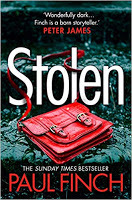 Be assured, Heck will be back in the not-too-distant future, as will Lucy Clayburn, who, if you read
STOLEN
, has also reached a critical turning-point in her story.
Be assured, Heck will be back in the not-too-distant future, as will Lucy Clayburn, who, if you read
STOLEN
, has also reached a critical turning-point in her story.So, I can only ask, if you’re absolute die-hard Heck and Lucy fans, to show a little more patience. Again, you have my guarantee that neither of those series has ended. I wouldn’t do that to you, nor to myself. It’s an author’s conceit, I suppose, but purely for creative purposes, we don’t like to leave stories half-told.
In the meantime, though, I hope you enjoy ONE EYE OPEN .
THRILLERS, CHILLERS, SHOCKERS AND KILLERS …
An ongoing series of reviews of dark fiction (crime, thriller, horror and sci-fi) – both old and new – that I have recently read and enjoyed. I’ll endeavour to keep the SPOILERS to a minimum; there will certainly be no given-away denouements or exposed twists-in-the-tail, but by the definition of the word ‘review’, I’m going to be talking about these books in more than just thumbnail detail, extolling the aspects that I particularly enjoyed (I’ll outline the plot first, and follow it with my opinions) … so I guess if you’d rather not know anything at all about these pieces of work in advance of reading them yourself, then these particular posts will not be your thing.
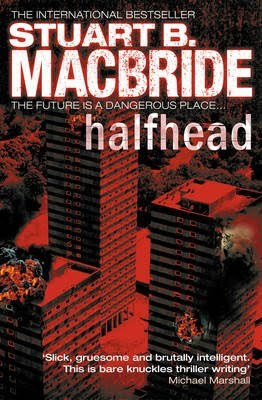 HALFHEAD
by Stuart MacBride (2010)
HALFHEAD
by Stuart MacBride (2010)
Outline The future. Scotland is now an independent country, a republic. But all is not well. The weather systems are awry, periods of scorching dry heat alternating with freezing cold monsoons, while Glasgow has become a vast megalopolis covering a huge stretch of the country. Inevitably, much of it is impoverished, the population crammed into immense high-rise slums called ‘connurbs’, where crime and drug abuse are rife, and only the constant use of virtual reality entertainment, VR, keeps the people distracted from the awfulness of their lives. Though even this can cause problems, VR Syndrome being a kind of contagious psychotic state that leads to wholesale violence and destruction.
Imposing the law on this concrete Hell falls to two agencies. First of all, the Bluecoats, who, providing both a uniformed service and a detective department, perform a fairly standard police function, but who are under-resourced, under-manned and under-trained, and in the eyes of many are little more than voluntary militia who do their best to keep the streets safe but often fail. Secondly, the Network, a paramilitary FBI-type operation with overarching powers and a remit to deal mainly with serious and organised crime. The two forces interact a lot, but don’t get on especially well, the Bluecoats seeing the Network as elitist, the Network seeing the Bluecoats as carrot-crunchers.
Both are armed with a fascinating array of futuristic weapons, from ‘zappers’, to ‘whompers’, to ‘thrummers’. As such, lethal shootings by police officers are a regular occurrence, but they are not controversial. This is a society constantly on the verge of criminal anarchy, and the law must regularly bare its teeth simply to stay in control. In the same authoritative spirit, condemned felons are ‘halfheaded’, which means they are lobotomised, bar-coded, have their bottom jaw surgically removed, along with any other bits and pieces that might make them human, and are then given orange jumpsuits and menial daily tasks to perform, such as mopping toilets and public concourses. They are, in effect, a brainless slave caste who serve as an everyday warning that crime will not be tolerated. Unfortunately, they are also such a common sight that no one really notices them anymore and so the lesson is often lost.
Halfhead opens with one of these anonymous drudges seemingly becoming aware of itself and discovering that it has just committed a brutal murder in a public toilet.
Technically, halfheads are asexual, but in this case it’s different. Oddly, this one finds itself recovering memories of a past in which she was Doctor Fiona Westfield, a beautiful but deranged medical practitioner who, as well as being a mass murderer in her own right, delighted in using her psychoanalytical skills to turn her patients into killers. Clearly, in this particular case, the halfheading process has failed, though at this stage of the narrative we don’t understand why.
Meanwhile, the hero of our story, Network Assistant Section Director Will Hunter, is adapting to life as a widower. At the same time, he’s struggling to get over a terrifying experience from 11 years earlier, when his team were annihilated during an operation in Sherman House, a towering connurb off Monstrosity Square, one of the most dangerous corners of Glasgow’s inner city. At the time, VR Syndrome rioters were going crazy in their thousands and Will only managed to get one man out, earning a lifelong pal in Agent Brian Alexander, but at the same time developing a very keen fear of Sherman House. Unfortunately, the next murder he’s assigned to investigate is in one of the toilets there (needless to say, it’s the one we opened the book with, though there are plenty of others to choose from). Again, there are violent incidents when the Network arrive, but Hunter sees enough to recognise the handiwork of someone he arrested many years ago … but surely that can’t be so, because Fiona Westfield (who murdered his wife among her many other victims!) was convicted and halfheaded. Not only that, he then learns that she was recently incinerated when a prisoner transport crashed off a city flyover.
So, she can’t possibly be involved. Can she?
At the same time, Hunter has other issues to deal with. Though he has feelings for hard-hitting Lieutenant Emily Brand, who commands one of the Network’s airborne SWAT teams, he develops stronger feelings for Detective Sergeant Jo Cameron, who comes over from the Bluecoats on secondment, and though brave and smart, is inexperienced at this level of law enforcement.
Hunter struggles to keep everything on track, especially as there are further weird and unexplainable crimes at Sherman House, which necessitates yet more police visits, stirring up the natives to homicidal hostility.
During one such incident, Hunter and Cameron are abducted by a group of urban guerrillas who turn out, thankfully, to be on the payroll of two mysterious government agents, Ken Petai and his supervisor, Tokumu Kikan, who claim to have a secret base underneath Sherman House, from where they are conducting experiments to try and create a vaccine with which to combat VR Syndrome.At least, this is the story they give out, and yet later on, when Hunter makes checks to try and verify it, he is unable to find any real evidence of this operation. Whoever Petai and Tokumu are, they are clearly off the charts when it comes to ‘classified intel’. Which Hunter doesn’t buy for one minute.
Meanwhile, Fiona Westfield is well on her way to recovery, using various ingenious and utterly ruthless methods to restore her physical appearance (killing and torturing repeatedly in the process), and drawing up an exhaustive list of all those people she intends to make suffer in a way they’ve never suffered before. And top of that list, inevitably, is the guy who put her here in the first place. Assistant Section Director Will Hunter …
ReviewI’ve seen a lot of debate online as to whether this amazing effort from Stuart MacBride should be classified as another slice of Tartan Noir, or as science fiction. I would add a further possibility: could it also be classified as a horror novel?, because believe me, Halfhead pulls no punches when it comes to ghoulish concepts and even more ghoulish detail. There is some genuinely nightmarish stuff to be found in here.
Of course, I understand the overall debate. MacBride is a poster child for Scottish crime writing, and rightly so. His books are never less than utterly gripping, and often so intensely dark and gritty that they stray into the realms of thriller/horror. Sci-fi, on the other hand, is something he isn’t known for – or at least he wasn’t until Halfhead came out (hence the B added to his name for this particular publication), and yet the lasting impression I had after finishing this book was that I’d just burned my way through something sitting midway between Blade Runner (the movie, not the novel) and Judge Dredd (the comic strip, not the movie). Though this, it has to be said, is mainly because of the dystopian aura it casts rather than because of advanced scientific concepts (though it does have some of the latter too).
In Halfhead , we are eyebrows-deep in a hellish urban future of soulless tower blocks, where the temperatures sear in summer and acid rain falls in autumn, where criminality of every type is rampant, in fact where zones of such lawlessness exist that even a paramilitary police equipped with heavily armed ‘firefly’ gunships only venture there at their peril, and where investigators like the Bluecoat detectives and Network agents move wearily from murder to massacre, because there is no time even to consider lesser crimes.
Ultimately, though, this is still a cop story. And how.
Because, again typically of Stuart MacBride, it’s the ‘human suffering’ factor that he’s most interested in. And that doesn’t just apply to the depressed, bone-weary law enforcers, but even to the halfheads, that voiceless criminal underclass whom it would have been more humane to electrocute or gas. The former, for the most part divorced or bereaved, socialise only with each other, drink too much, argue, fight, despise their bosses and go home each night to drab, empty apartments with mind-numbing views of the urban sprawl. The latter, though they’ve all committed despicable crimes, are grotesque and yet pitiful zombie-like figures, lepers of the future, dragging themselves mindlessly through every day, completely below the notice of ordinary citizens.
This is one of the things that hit me hardest about Halfhead . Though spirited characters like Jo Cameron, Emily Brand and Brian Alexander liven the gloom with their wisecracking (which is always dark because these are coppers), you know that much of it is bravado. This is an existence rather than a life, and the terrain of our future Glasgow only adds to it. It’s a steel and concrete Pandemonium, the cops chasing suspects or themselves being pursued by mobs along endless brick tunnels, rubbish-strewn underpasses and desolate rooftops. There is no hint of the natural world. Even the air itself needs to be scrubbed clean by great hovering machines, which are invariably rusty and broken. It’s as though everything here is purpose-designed to break the spirit.
This again is vintage Stuart MacBride, whose world-famous Logan McRae series takes place on the concrete meanstreets of Aberdeen. As are the crime scenes, which again are goriness personified, and the investigations themselves, which see brave, isolated cops pitted not just against every kind of verminous criminal, but against hostile and monolithic power structures within the police itself.
It all makes for a dark but compelling narrative, and this is helped by some characteristically blistering action sequences. In Halfhead , the cops expect serious trouble on a daily basis, and not only do they get it, they respond in kind. Violence is its own currency here. We’ve already listed the range of extraordinary weapons the law can call upon, and the villains are just as bad. Inevitably, the body count soars on both sides of the criminal divide (we visit at least two police funerals). And yet an intriguing mystery and potential complex conspiracy still lies at the centre of this story, especially when Hunter and co finally make contact with the secretive cell operating from the bowels of Sherman House, which I obviously can’t say too much more about except to comment that, though it won’t be an unfamiliar one to modern day thriller fans, it’s a very grown-up idea, which is only leaked to us bit by bit, so it keeps us guessing almost to the end (it’s also done as gruesomely as possible, so you’ll need a strong stomach as it all unfolds).
Despite these multiple hardships, MacBride gives us a great set of characters, all of whose attitudes under pressure – to crack bad jokes, to drink hard, to slag off the brass etc – are very reminiscent of the real thing, which makes you enjoy the company of everyone involved.
Will Hunter is the calm heart of the investigation team that gradually coalesces around him. He’s an intuitive and authorative officer, but an all-round good egg rather than a bad ass. Jo Cameron is an excellent foil: beautiful, tough, witty, but a little (and fetchingly) naive, and with an amusingly appalling dress sense. Brian Alexander and Emily Brand are back-up good guys to an extent, but again superbly realised, the latter a spit-and-polish trooper of the old school, who is unfailingly loyal to her crew and can always be relied on to maintain discipline when the lead is flying, the former an unruly roughneck of the type you find in every police station, an arch micky-taker whose approach to life is perhaps not serious enough for the gaffers but who can cheer a room up and is good to have in a corner.
The villains of the piece are equally well-drawn.
You know from the outset that Ken Peitai and Tokumu Kikan are up to no good, but they are purposely kept out of the limelight for much of the narrative, for which reason I won’t discuss them now. Much more central to the villainy in Halfhead is Fiona Westfield. This one’s a real psychopaths’ psychopath, a female Hannibal Lecter, so clever and organised that she is not only able to start reversing the halfheading process, but she actually commences tracking down her old acquaintances, friends, foes and proteges alike, works out the best and quickest way of getting her old programme of maniac-making back on the road, and still takes time out to claim more and more victims for no other reason than the sheer pleasure it gives her to bathe in their blood (you perhaps now understand what I meant when I said that this is a horror story as well as a crime thriller).
Is it possible that Westfield is a bit OTT? Well, yes … but remember this is a Mega-City One scenario. Everything here is over the top: the architecture, the weather, the callousness of the conspirators, the firepower of the police. So, to be the queen of crime in Halfhead , she was always going to need to be something really special. In any case, how does any ordinary person recover from a lobotomy, restore her own severed jaw, transform herself back from the status of lumbering mute into deadly, beautiful predator? Nothing less than a true mistress of evil would suffice.
Not everyone who’s read Halfhead likes it, some crime fans writing that they prefer the dourer, more grounded-in-reality Logan McRae mysteries, some sci-fan readers complaining that it’s just a cop story with a bit of tech added for dramatic effect. Personally, I took it for what I think it was intended to be: an intense, brooding thriller, played at lightning pace, the author throwing blood and grime at you with every turn, and employing constant seat-edge tension. I enjoyed every grisly, hardboiled page of it.
And now, as often, I’m going to try to cast this beast should film or TV ever come to call. Only a bit of fun, of course. I have no real pull in the wider world of moviedom (you’ll be surprised to learn):
Assistant Section Director Will Hunter – Sam HeughanDetective Sergeant Jo Cameron – Katie LeungSpecial Agent Brian Alexander – John HannahLieutenant Emily Brand – Isla FisherDr Fiona Westfield – Erin RichardsKen Peitai – Claes BangTokumu Kikan – James Cosmo
Published on April 03, 2020 10:47
March 3, 2020
Book to film, or not ... as the case may be
 I’ve got a few interesting bits and bobs to chat about this week, including the title of my next novel, ONE EYE OPEN (out in August, with a cover reveal soon, I promise). But given that this publication is a few months off yet, I thought that today, which seems to be a bit of a lull in events, might be a suitable opportunity for me to talk a little about my film career to date (such as it is!), to add some meat to the bones of those occasional comments I make at conventions about movie projects of mine that never took off (some of which still may, of course).
I’ve got a few interesting bits and bobs to chat about this week, including the title of my next novel, ONE EYE OPEN (out in August, with a cover reveal soon, I promise). But given that this publication is a few months off yet, I thought that today, which seems to be a bit of a lull in events, might be a suitable opportunity for me to talk a little about my film career to date (such as it is!), to add some meat to the bones of those occasional comments I make at conventions about movie projects of mine that never took off (some of which still may, of course).On a not dissimilar subject, books-to-films, I also offer a belated review of James Ellroy’s astonishing and groundbreaking 1990 cop novel, LA CONFIDENTIAL, which of course became a massive hit movie seven years later. You may wonder why I’m reviewing that at this late stage. Well, I’ll answer all such questions down below … as usual, you’ll find the review at the lower end of today’s blog.
In the meantime, before we get to that, here’s an image to feast your eyes upon.
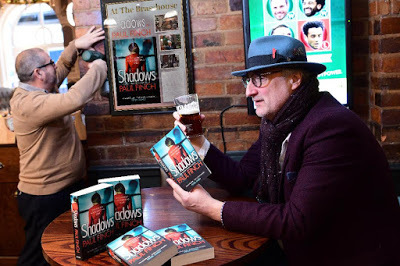
It seems I now have my own dedicated corner in The Brasshouse, that legendary pub in the very heart of Birmingham, bang next door to the Black Sabbath bridge. The two gentlemen pictured doing me this honour are Paulo Jacinto, the landlord, (on the left), and events organiser down in Brum, Mike Olley.
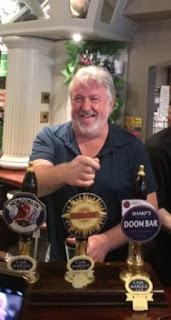 The background to his is that back in 2017, when
SHADOWS
, my second Lucy Clayburn novel, was published, I opened the action in The Brasshouse – yep, the very same place – and the owners were so happy when they read about this that they didn’t just invite me down to sample some ale and have a chat as a guest at one of their music festivals (not to mention pull a pint or two, as you can see here), but they have also now memorialised the book on the wall of the main bar.
The background to his is that back in 2017, when
SHADOWS
, my second Lucy Clayburn novel, was published, I opened the action in The Brasshouse – yep, the very same place – and the owners were so happy when they read about this that they didn’t just invite me down to sample some ale and have a chat as a guest at one of their music festivals (not to mention pull a pint or two, as you can see here), but they have also now memorialised the book on the wall of the main bar.I can’t thank the folk down at The Brasshouse enough for this great honour. It’s not something we authors tend to see a lot of, and so massive gratitude goes to Mike, Paulo and all the others.
And now (if you can forgive a really self-indulgent strap-header) …
Paul Finch – the movies
I’m aware that makes me sound as if I’ve got a track-record in film to equal John Milius’s. Well, not quite. Let me elaborate …
In my humble opinion, one of the most dispiriting things about writing – not just writing for a living, but any kind of writing – is the number of projects that never hit paydirt.
Now, what that does NOT mean is that I expect everything I write to rip across the sky like a meteor. Firstly, because not all of it is good enough for that. But also because – and this is a fact of life in the industry – even if our latest piece of work is the best thing we’ve ever done, there’ll still be an element of luck involved if it really ends up flying. On occasion, the most talented wordsmiths on the planet need to be in the right place at the right time. Of course, of all the writers I know, I bet there isn’t a single one who, even though they are fully aware of this, don’t occasionally bemoan those great ideas they’ve submitted as premises or treatments, or even as finished works, and yet which somehow or other, for reasons that should mystify the universe, have never caught the imagination of a single publisher or producer.
In my own personal experience, this has primarily been with movie projects. Not that I’m alone in that.
No author I know, even full-time novelists who have never attempted to write a screenplay, wouldn’t be excited to see their work adapted for the silver screen. And yet, despite the significant numbers of movies produced annually, so many of us can still tell stories about projects of ours that we privately thought would be sure-fire cinema hits and yet which, in the end, never even reached pre-production let alone principle photography.
I’ve now seen 12 of my novels published, alongside several collections of short stories. In addition, in my early days, I wrote TV scripts for The Bill and innumerable episodes of various children’s animation shows. And yet the world of film has proved dishearteningly elusive.
Now, I should add straight away that this hasn’t been the whole story. Two of my movie scripts HAVE been produced and DID hit the cinema. So, it’s not all abject misery. In which case you may wonder why I’m complaining.
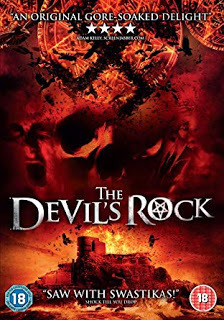 Well … I’m not really. I just thought it might be instructive, now that I’m on the runway to publication of my 13th novel, to point out that it’s not all been cakes and ale.
Well … I’m not really. I just thought it might be instructive, now that I’m on the runway to publication of my 13th novel, to point out that it’s not all been cakes and ale.For those interested, the two success stories were SPIRIT TRAP (2005) and THE DEVIL’S ROCK (2011).
The former starred Billie Piper and Sam Troughton, and tells the tale of a bunch of students who take over a dilapidated London mansion where an old Russian spirit clock, long since defunct, is set in motion again, a whole series of supernatural events then following.
My role was primarily that of script-doctor (in other words I had to rewrite a pre-existing script). The film wasn’t hugely successful, but it’s gathered something of a cult following in the years since its release, and it’s a regular on the Horror Channel, so I suppose it was a result of sorts.
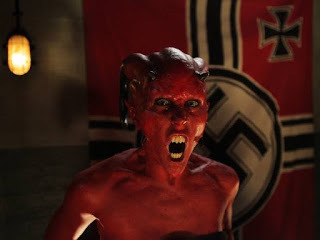 The second of the two,
THE DEVIL’S ROCK
, is set on the Eve of D-Day and concerns two New Zealand commandos, whose mission to destroy a German gun emplacement on an outpost of the Channel Islands uncovers a plot to unleash a demonic force against the Allies.
The second of the two,
THE DEVIL’S ROCK
, is set on the Eve of D-Day and concerns two New Zealand commandos, whose mission to destroy a German gun emplacement on an outpost of the Channel Islands uncovers a plot to unleash a demonic force against the Allies.This was a great experience, all-round. The script was mostly my own work, though I developed the story with director (and good friend of mine), PAUL CAMPION , who went on to do a sterling job behind the camera. On completion, it received a very positive response from critics and fans alike – the night of the premiere in Soho was one of my proudest moments – and if it hadn’t been for the constant pirating of the finished product, it would have gone on to make quite a bit of money and would have secured a sequel at the very least.
But that is where the good news ends. Because, as I say, none of my other film projects, thus far at least, have risen to those heady heights.
The first of these that’s worth talking about came way back at the end of the last century (crikey, that makes it sound longer ago than it actually was, though it still seems like a lifetime to me), and was a retelling of THE GOLEM.
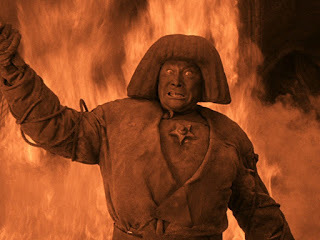 At the time, Talisman Films, flush with confidence after the success of their Liam Neeson vehicle,
Rob Roy
, were really up for this one. You may recall that the Golem was a monstrous clay man, who, in the legend, was animated by rabbinical magic and put in defence of a Jewish community facing the terror of a pogrom. (The image here comes from the 1915 German horror film of the same name).
At the time, Talisman Films, flush with confidence after the success of their Liam Neeson vehicle,
Rob Roy
, were really up for this one. You may recall that the Golem was a monstrous clay man, who, in the legend, was animated by rabbinical magic and put in defence of a Jewish community facing the terror of a pogrom. (The image here comes from the 1915 German horror film of the same name).The initial plan had been to re-set the story during World War II, but after several development meetings, we decided this would be prohibitively expensive and perhaps not quite current enough given that the Balkan War was currently raging. So, we updated it and tweaked it, putting the Golem, the invincible guardian of the Jews (but a willing protector of ALL innocents), in defence of a Muslim town being terrorised by Serb guerrillas. We also threw some British and American spec-ops guys in to ensure we got the funding.
I only wrote two or three script versions of this before the producer and I settled on one that we really liked. And then, for reasons that completely elude me, but were probably financial, the project was shelved. Indefinitely. That was the first serious film script I’d ever written, and briefly it looked as if it was going well and that we were all headed for a stonking big success. But alas, it’s all long over. THE GOLEM – my version of it, at least – is not even in Development Hell anymore.
 Following this, I wrote a speculative script, THE BELFRIES, (or BELFRY MEADOWS depending on which draft you saw) adapted from a short story of mine that was published in the 2004 horror anthology,
Acquainted with the Night
. No one had asked for it at that stage, but I wrote the script anyway, thinking that it would make a very cinematic ghost story.
Following this, I wrote a speculative script, THE BELFRIES, (or BELFRY MEADOWS depending on which draft you saw) adapted from a short story of mine that was published in the 2004 horror anthology,
Acquainted with the Night
. No one had asked for it at that stage, but I wrote the script anyway, thinking that it would make a very cinematic ghost story. It concerns Stella, a young Manchester woman, newly married to the man of her dreams, Mike, who moves into a brand-new housing estate in the English West Country, where, because Mike is a director for the building firm, they get their pick of the posh new houses. The problem is that they are still the only residents on site and will remain so for several months. With Mike working away a lot of the time, what this actually means is that Stella will be the one alone, surrounded by rows of silent, empty new-builds. Inevitably, a haunting commences, which grows progressively more terrifying. Her investigation initially focusses on the legends and folklore of the West Country, but in actual fact the real evil is much closer to home.
I couldn’t get anyone to bite with this one, and yet I mention it here because only a year later, the story made such an impact on an Oscar-winning writer/director with Creative Artists in Hollywood that he optioned it on the condition he could adapt it himself. This would have involved him re-setting the story in California, but I had no issue with that (I’m nothing if not infinitely flexible if you want to make movies out of my books and stories!), but alas, though the option was renewed twice over several years, the film still wasn’t made.
 While all this was going on, there was
CAPE WRATH
. This was originally my novella of 2001, which really started attracting attention when it was short-listed for the Bram Stoker Award in 2002. It follows a mission to a mist-begirt island in the Outer Hebrides, where a small group of archaeologists believe they have found the burial mound of infamous Viking, Ivar the Boneless. Needless to say, once they open the tomb, all manner of Norse-flavoured horror explodes out at them.
While all this was going on, there was
CAPE WRATH
. This was originally my novella of 2001, which really started attracting attention when it was short-listed for the Bram Stoker Award in 2002. It follows a mission to a mist-begirt island in the Outer Hebrides, where a small group of archaeologists believe they have found the burial mound of infamous Viking, Ivar the Boneless. Needless to say, once they open the tomb, all manner of Norse-flavoured horror explodes out at them. This project was initially optioned by a young producer who I got on with like a house on fire, and who continued to renew it for – wait for this – the next seven years! I must have written 15 versions of the script in that time, before it gradually dawned on me that, no matter how often I ‘polished’ it, it simply wasn’t going to get made. At one point we were apparently a month from pre-production. But the month passed and, guess what … nothing happened. Sometimes the word ‘dispiriting’ doesn’t even come close to covering it.
However, this one may yet have a happy ending, because CAPE WRATH has recently been optioned again by a very workmanlike outfit headed up by a successful London-based writer/producer, so this one could still happen.
Another that has been ongoing for quite a few years now but is not yet dead is THE FREEZE.
This was an idea I initially sketched out as a possible novella, but in the end wrote as an on-spec screenplay. This would have been around 2010, I think, as it was likely inspired by the succession of extra-cold winters that we had in the UK around then (I remember -17 being recorded one Christmas Day lunchtime, which is pretty unusual even in Lancashire).
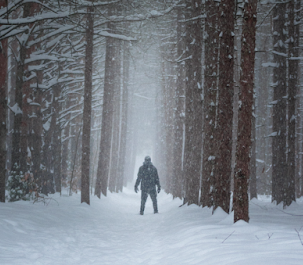 Anyway, the story concerns a bunch of delinquent girls on an outward-bound course of self discovery up in the Lake District, who find themselves marooned in their hostel by a terrible blizzard. At the same time, a prison transport carrying a group of Britain’s deadliest killers is en route to a new offshore supermax prison. Inevitably, the prison transport crashes, the murderers escape and in order to avoid freezing to death, they must try to force entry to the isolated hostel. The girls, meanwhile, if they want to survive, must somehow keep them out.
Anyway, the story concerns a bunch of delinquent girls on an outward-bound course of self discovery up in the Lake District, who find themselves marooned in their hostel by a terrible blizzard. At the same time, a prison transport carrying a group of Britain’s deadliest killers is en route to a new offshore supermax prison. Inevitably, the prison transport crashes, the murderers escape and in order to avoid freezing to death, they must try to force entry to the isolated hostel. The girls, meanwhile, if they want to survive, must somehow keep them out.Now, this is another project, which though it’s been through umpteen changes and rewrites, and though all kinds of alternate storylines have been suggested, I still have high hopes for, mainly because the indefatigable Paul Campion is the film-maker currently most interested and he’s presently hawking it around production offices all over the Southern Hemisphere. Yet again, I don’t care if it’s set in the snowy wilds of New Zealand’s South Island if that means it gets made.
On the subject of the energetic Mr Campion, it’s also worth mentioning VOODOO DAWN.
This was another of those film projects that I derived from a short story of mine, though this one, it must be said, goes way back. Lore of the Jungle was written in 1993 and narrated by Dennis Waterman on a Telstar Audible horror anthology called Creatures of the Night .
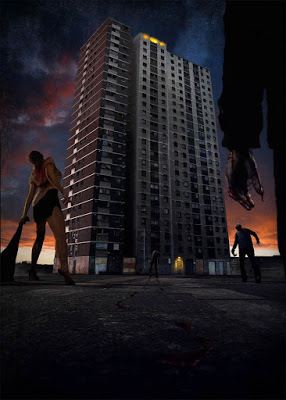 It follows the misfortunes of a London gang, whose latest escapade leaves several people dead and arouses the ire of a bokor, or voodoo priest. The next thing the gang know, their hideout is under siege by the zombified remains of their victims.
It follows the misfortunes of a London gang, whose latest escapade leaves several people dead and arouses the ire of a bokor, or voodoo priest. The next thing the gang know, their hideout is under siege by the zombified remains of their victims.In the script version, which I first wrote in the early 2000s, I set the gang’s hideout at the top of a derelict tower block in South London. The mind boggled at the potential this gave us for blood-drenched zombie action in the graffiti covered stairwells and lift shafts of a decayed urban high-rise, opening the door for all kinds of Reanimator -type gore effects. Paul Campion, being a special effects man to his bones, was hugely involved in this project’s development (check out his amazing concept art above), but yet again, though we rewrote it until we were absolutely delighted with it, and then touted it to a number of producers, and though several were very positive, none were able to raise the required money. And then, in the end, other circumstances kicked in. Attack the Block was made, along with the French zombie/gangster movie, The Horde . And then, as the slaughter-the-undead craze became overwhelming, we even had Cockneys vs Zombies . Personally, I consider VOODOO DAWN to be better than any of those, or even all of them rolled into one, but then I would say that, wouldn’t I!
THE DEAD ROOM – or DARK GROUND as it was later retitled – was another interesting project. This was already written in first draft form when it was brought to me by a well-regarded company who wanted to make a haunted house movie set in the UK, specifically on the Pembroke Coast. The draft I saw was very accomplished, but the producers wanted it updated along the lines specified by the director they’d hired. I went down to the director’s house in Cardiff for a couple of days and we worked through the script in various harbour-side bars, but again, in due course, the project fell by the wayside. I can’t quite remember why, but I know that this one was very disappointing as it had all seemed to be going so well and I’d made the critical mistake of actually expecting it to happen.
VODYANOI (or, for a brief time, DEEP BLACK) was the result of several meetings with a relatively new team who were keen to make a horror movie set in Russia but which didn’t denigrate the Russian people or their culture. I understood this concern. At the time, we had lots of movies like The Green Elephant , Mute Witness and Hostel , which implied that the social chaos in what had once been the Eastern Bloc had enabled the rise of Snuf film makers, torture-for-pleasure companies and, basically, insane levels of sadistic and deranged criminality. They didn’t want anything like that, so when I suggested we look at Slavonic mythology, they were very enthusiastic.
 The story I came up with concerned an Anglo/Russian research team who travel to a remote lake in the Ural Mountains, where it has been discovered that natural pollution caused by metallic run-off from the encircling hills is creating monstrosities in the unexplored depths.
The story I came up with concerned an Anglo/Russian research team who travel to a remote lake in the Ural Mountains, where it has been discovered that natural pollution caused by metallic run-off from the encircling hills is creating monstrosities in the unexplored depths.I was delighted with both the idea and my finished script, and felt that it came straight out of the Dr Who / Quatermass stable in that it combined sci-fi, folklore and eco-horror (plus it had finally given me a chance to indulge in one of my favourite things, which is underwater action) … but somehow, once again, it just didn’t happen.
This was an especially disenchanting episode for me, as it involved several hellish drives down from my home in Wigan to Pinewood Studios in Buckinghamshire, at least twice during furious blizzards, for development meetings that went on for hours and seemed to lead nowhere. Of all those I’ve been involved with, I think this project was the worst experience in that I entertained such high hopes for it and put in an awful lot of effort – for absolutely zero gain. HUNTING GROUND was another idea of mine that originated as a film premise rather than a book or story. In this one, a special forces unit sent to destroy a chemical weapons store in the Afghan mountains are immersed in an unknown agent but return home seemingly unharmed. Later however, while showing a bunch of journalists around their secret training base on a remote island, they begin manifesting homicidal tendencies. The base is shortly due to be decommissioned so there is no one else there to help the civies. I suppose you could have called this one a survival action/horror/thriller. Everyone who saw it seemed to really like it, but it took a bunch of young movie-makers, fresh out of film school, to actually option it. They wanted me to change the main protagonists from adult journalists to army cadets on a training course of their own, therefore aiming the film at a younger audience. I wasn’t initially keen but eventually saw how it could work. Alas, despite rewriting it to that effect, nothing came of it in the long-term.
We now come to what’s probably the last of the early projects of mine that almost got there. I’ve been working on HEART AND MIND for so long that I genuinely cannot remember when I first hatched the idea, though I suspect it was right back at the beginning of my freelance career, around 1998 or 1999. This was long before my Heck or Lucy Clayburn novels, but at the time I was writing scripts for The Bill , so I had my police/crime thriller head screwed on.
 This one was originally set not long after the battle of Tora Bora (right), and sees an SAS soldier return home, traumatised, only to find that his mother has been shot dead during a botched robbery, for which the chief suspect is the nephew of a Manchester crime lord. When he hears from his ex-girlfriend, who’s now the DI investigating the case, that the nephew, though reviled by many in the underworld, will likely get away with it because they will always protect their own, he takes the law into his own hands, enacting a vengeance on the mob that literally rocks them where they stand.
This one was originally set not long after the battle of Tora Bora (right), and sees an SAS soldier return home, traumatised, only to find that his mother has been shot dead during a botched robbery, for which the chief suspect is the nephew of a Manchester crime lord. When he hears from his ex-girlfriend, who’s now the DI investigating the case, that the nephew, though reviled by many in the underworld, will likely get away with it because they will always protect their own, he takes the law into his own hands, enacting a vengeance on the mob that literally rocks them where they stand.I particularly liked this one as it turned the normal crime thriller situation on its head, seeing gangland itself horribly victimised, and the chief villain, Frank Kelman, an elderly Kray-like character, who was looking to get out of the crime game once and for all, now forcibly dragged back into it.
Once again, more producers than I can remember had solid sniffs around this one, but as before, the project – though it seemed to find favour wherever I took it – remains unclaimed at this stage, and all options have again expired. However, I still have hopes for it. The script has been written, rewritten, polished etc, and is now just waiting for someone with some development money to take a punt on it.
This brings us to the most recent film project of all, and one that is still doing the rounds.
WAR WOLF got achingly close to pre-production. It was an idea of mine loosely based on one of my fantasy novels, STRONGHOLD , though the average man in the street probably wouldn’t see much similarity between them now.
To give you a thumb-nail, the film script is set in central France during the Hundred Years War and pits a company of English knights, who have recently been the victors in some very bloody battles, against an army of vengeful werewolves. This one was optioned by a very serious London and LA-based outfit, the announcement of which even made the pages of Variety, and again, in the early stages, Paul Campion was attached to direct (here’s yet more of his amazing concept art).
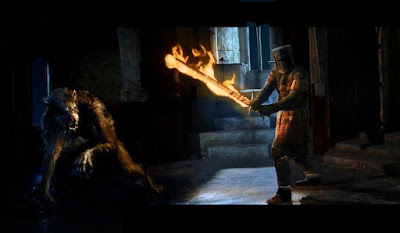
Despite having all that quality on board, there’ve been lots of ups and downs in the development of this project and endless drafts have been written (not just by me, but also by my co-writer and good buddy, Andy Briggs), but the good news in this case is that it is still being talked about and considered, and could easily happen. Fingers crossed for this one.
THRILLERS, CHILLERS, SHOCKERS AND KILLERS …
An ongoing series of reviews of dark fiction (crime, thriller, horror and sci-fi) – both old and new – that I have recently read and enjoyed. I’ll endeavour to keep the SPOILERS to a minimum; there will certainly be no given-away denouements or exposed twists-in-the-tail, but by the definition of the word ‘review’, I’m going to be talking about these books in more than just thumbnail detail, extolling the aspects that I particularly enjoyed … so I guess if you’d rather not know anything at all about these pieces of work in advance of reading them yourself, then these particular posts will not be your thing.
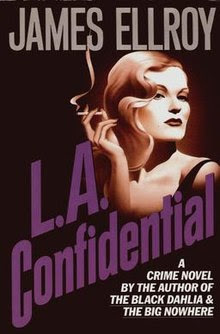 LA CONFIDENTIAL
LA CONFIDENTIAL by James Ellroy (1990)
Los Angeles in the early 1950s, where three cops are following very different routes in their efforts to rise through the ranks.
First off, Ed Exley, son of legendary ace-detective now turned top businessman and successful civic engineer, Preston Exley, is a one-time college boy and supposed war hero (though in truth, his wartime heroics are a fake, which only he knows about), who is determined to go far in this toughest of professions, primarily because he yearns to emulate if not improve upon his father’s achievements. Secondly, there is Wendel ‘Bud’ White, a pitiless hardcase who, thanks to a nightmarish childhood during which he was chained up by his psychotic father and made to watch his mother suffer a fatal beating with a tyre iron, has a particular bone to pick with every domestic bully he meets. Lastly, there is ‘Trashcan’ Jack ‘the Big V’ Vincennes, a superficially ultra-cool character, who works the narco desk, earns big bucks advising for the hit TV show, Badge of Honour, and busts celebrity drug-users after first setting up photo ops for scandal mag, Hush-Hush, with its scoop-hound in chief, Sid Hudgens, for which he is also very well-paid.
Clearly, none of this unethical threesome are shining examples of LA’s finest, and from the start they seem unlikely ever to be bedfellows when it comes to investigating crime. In fact, early on in the book there is active loathing between them.
Exley, who’s duty-officer at the division’s headquarters one booze-soaked Christmas Eve, when dozens of officers participate in the brutal and continuous beating of several Hispanic youths being held for assaulting a couple of patrolmen (a reflection of the real life ‘Bloody Christmas’ event in LA in 1951), regards it as his duty to report the incident. The chain-reaction this ignites sees Vincennes, who was only peripherally involved, transferred to Vice, and White, also an unwilling participant, severely censured, but more importantly, White’s partner, Dick Stensland, who was the main instigator, dismissed from the force and sent into a downward spiral of drunkenness and crime, which finally sees him executed in the gas chamber.
The three men duly settle into new routines, hating each other from a distance, and time moves on, a sense of which we readers mainly glean from a torrent of official police reports and newspaper articles, including plenty from the ever irreverent Hush-Hush.
Vincennes and White wallow along at reduced pace, the former, now a drug-user himself, disgusted to be investigating such uninteresting villains as pimps and pornographers, the latter making a bit on the side by strong-arming gangsters under the affable but manipulative control of Captain Dudley Smith, whose secretive unit enjoys almost free license in its use of violence, blackmail and bribery. Exley, meanwhile, the only one whose chances of promotion have improved since the Bloody Christmas outrage, is still looking for the big case that will make his career.
Ed’s father, Preston Exley, though he made his real wealth building freeways and the gigantic amusement park, Dream-a-Dreamland (a thinly veiled Disneyland), became an overnight sensation as a cop when he captured a serial killer who didn’t just abduct and butcher children, including a popular child star of the 1930s, but who then stitched their severed parts together to create his very own Frankenstein monster. Ed, now a detective in his own right, has never had a case that even approaches this one, until the ‘Nite Owl Massacre’ occurs; what looks like an armed robbery at an overnight diner, which spins out of control and sees three members of staff and three customers shot dead.
Dubbed the ‘Southland’s Crime of the Century’, Exley is determined that this will be the enquiry that defines his career, but as the demand for results from Chief William Parker grow louder and louder, he closes in too speedily on three black hoodlums who actually have a solid alibi: at the same time as the Nite Owl murders were happening, this sordid trio had abducted a young Latino woman, raped and beaten her and were then in the process of pimping her out to various of their lowlife friends. Despite increasing evidence to the contrary, Exley persuades himself that the threesome are guilty of the Nite Owl attack too and winds up gunning them down when they attempt to go on the run, even though he is armed at the time and they aren’t.
What follows from this shocking miscarriage of ‘absolute justice’ is a bewildering explosion of plot and counter-plot, each more complex and brutal than the last, all cross-cutting each other and played out at breakneck pace, involving yet more serial murders (recent ones as well as the older ones), gangland hit after gangland hit, mutilation of prostitutes, the distribution of progressively weirder and more gruesome pornography, heroin trafficking (in rivers), racketeering and conspiracy among public officials, senior cops behaving like mob bosses, junior cops acting like crazy gunmen (even our three police antiheroes, who repeatedly fail to step up and do the right thing), the whole narrative finally descending into a maelstrom of violence and corruption in the perfectly inappropriately named City of the Angels, which in this book is more like Pandemonium itself.
Somehow or other, Exley, White and Vincennes are going to get to the incredible truth behind the Nite Owl slaughter, and sundry other horrific crimes, but they’ll literally play Hell getting it done, and will then find themselves confronting a cadre of deadly villains who are surely among the most evil ever committed to paper. Well before the end, the chances that all three of them will make it through seem remarkably slim …
What can you say about a novel like LA Confidential , which is so well-known already and so widely revered that it makes any kind of review in 2020 incidental?
I hesitated to put pen to paper regarding this because all I could think was that no one would care about my view. The book has already sold millions of copies, it was made into a massively successful Hollywood movie some 22 years ago, it is volume three in the hugely influential LA Quartet series, which, again, the vast majority of the reading public already knows about. There’s no obvious reason why I should have my say so late in the day, but you know, when you finally get around to reading a book like this, you just have to comment.
And after that intro, I imagine you’ll expect me to be controversial. Well … not as controversial as the novel itself, put it that way.
First, I suppose I should discuss the aspects of LA Confidential that are likely to cause ‘issues’ for people. To start with, it’s not woke. And that’s a serious understatement.
The book was written in 1990, which though that is relatively recent in terms of Noir, was still long before authors were expected to show any real degree of racial or gender sensitivity. On top of that, it’s set in the 1950s, when machismo was the order of things in male society, women were viewed either as ornaments or homemakers (or both), and ethnic minorities were openly considered to be second-class citizens.
And then there is the author factor.
James Ellroy is famous for his cynical and subversive public persona, and while there is doubt as to how much of that is genuine, it’s certain that he could not have set out to write a book like LA Confidential without willfully seeking to stun his audience, without purposely reinventing Los Angeles as a vile underbelly peopled by deviants of every sort – pimps, hookers, hopheads, high-level criminals, bent officials and cops themselves who are little more than drunken, corrupt brutes – without consciously seeking to offend almost every corner of society.
There is almost no one in this book – white, black, Hispanic, straight, gay etc – that you can actually sympathise with, no one who doesn’t deserve the many slurs and insults that would cause uproar in any novel published today but which are thrown about like confetti in this one. And quite often, this decidedly tough language doesn’t just occur in the dialogue. The author himself is equally guilty, frequently dropping the N and Q words, and yet somehow, in mysterious Tarantino fashion, getting a free pass from the critics. Is LA Confidential such unimpeachable art that this can be tolerated? Well, no I wouldn’t say so. But then I wouldn’t say that about Tarantino’s movies either. But things are as they are. No one seems to mind.
On top of the juicy language here, there is a whole ream of social and criminal horror for the average reader to digest. As I say, almost no one is redeemable in LA Confidential . From arch real-life gangsters and former Bugsy Siegel sidekicks, Mickey Cohen and Johnny Stompanato, right down to verminous tabloid scumbag, Sid Hudgens, everyone in this book is ruthless, deceitful and treacherous. They’ve all got an angle, they’ve all got their own interests at heart, they all do each other down with a narcissistic glee that owes nothing to necessity. And in many cases, they all have hideous secrets. For example, musician Burt ‘Deuce’ Perkins did time on a chain gang for ‘unnatural acts against dogs’! Ray Dieterling, cartoon animator turned movie millionaire (Walt Disney, anyone?), had his own son murdered!
Even our three heroes – Exley, White and Vincennes – are so deeply flawed that in normal circumstances you’d expect to view them as villains. Exley is the best of the bunch, except that he lives a lie where his war record is concerned, and is obsessively, ruthlessly ambitious, a personal weakness that actually starts to make a physical impression on him. The fact that he killed the wrong people after the Nite Owl Massacre bothers him a little, but it doesn’t on its own ruin his life.
Jack Vincennes also regrets shooting innocent people, but his response is to keep self-medicating with ever heavier narcotics, even though he’ll still happily bust pushers and users, all the time fantasising about his beautiful girlfriend, Karen, getting down and dirty in full-on porn movie orgies.
Bud White also has a girlfriend that he doesn’t really deserve, in Lyn Bracken, a former prostitute from a high-class stable, where all the girls were surgically modified to look like film stars, in her case Veronica Lake. She sees something in the apelike White, though Heaven knows what, especially as his innate loathing of wife-batterers doesn’t prevent him beating her when he learns that she’s been unfaithful.
Then we have the actual horror with which this book is deeply layered.
As I’ve already intimated, James Ellroy’s LA is a nightmarish netherworld, liberally strewn with horrific murders, gang rapes and ghastly dismemberments. Most of the victims, male or female, adult or child, are killed in the most barbarous ways imaginable. Sid Hudgens for example is hacked apart while he is still alive, while others are tortured to death with caustic chemicals, including acid. In a way, of course, this emboldens the reader to keep going, because it makes him/her realise that as bad as Exley, White and Vincennes are, there are always worst beasts lurking just beyond the next page, and that maybe only a bunch of human wolves like these will be able to take them down.
But seriously, be prepared for the gruesomeness of this book. The scene of the Nite Owl Massacre is described as though it’s an abattoir, the condition of the Frankenstein killer’s prepubescent victims, when finally discovered by Preston Exley, has to be read to be believed. In another staggeringly violent moment, Bud White shoves a suspect’s hand down a garbage disposal, churning it to mush … and remember, White is supposed to be one of the good guys.
The final brickbat, if it is such a thing (and this is entirely subjective), is the manner in which the novel is written.
According to the stories, when James Ellroy delivered the first draft of LA Confidential to his publishers, it clocked in at 900,000 words. Even in the States, they balked at publishing something so enormous. The author was ordered to cut it back significantly, which he didn’t consider possible unless he literally stripped out half of almost every sentence he’d written, glueing many of the remnants back together in what almost looks like haphazard fashion. The result is a literary style that at first read is so startling you really don’t think you’re going to get used to it. This chunk of text, for example, comes from the very first page of Chapter One:
Bud White in an unmarked, watching the ‘1951’ on the City Hall Christmas tree blink. The back seat was packed with liquor for the station party; he’d scrounged merchants all day, avoiding Parker’s dictate: married men had the 24th and Christmas off, all duty rosters were bachelors only; the Central detective squad was despatched to round up vagrants: the chief wanted local stumblebums chilled so they wouldn’t crash Mayor Bowron’s lawn party for underprivileged kids and scarf all the cookies …
It’s a similar story all the way through. It’s almost as though you’re reading a genuine cop’s abbreviated notes. It’s more like a stream of consciousness than actual literature.
Bud packed up, got out, brainstormed some more – pimp war clicks, clickouts – Duke Cathcart had two skags in his stable, no stomach for pushing a 14-year-old nymphet – he was a pimp disaster area. He tried to click Duke’s pad tossed to the Nite Owl – no gears meshed, odds on the (blacks) remained high. If the tossing played, tie it to Cathcart’s ‘new’ gig – Feather Royko talked it up – she came off clean as Sinful Cindy came off hinky . . .
However, I urge you all to stick with it. My initial reaction was negative, but within a page I’d adjusted. Not only that, it had taken nothing away from the epic sweep of the story, or any of the author’s multiple overlaying subplots.
And yes, as you’ve probably guessed, we’re now onto the positives about LA Confidential , which are frankly overwhelming.
If you can make the mental leap into the world of exaggerated darkness that this novel occupies, few of the negatives I’ve already mentioned will bother you. Because, taken as a whole, this really is one of the greatest Noir novels ever written. Yes, it’s appallingly brutal and rude and crass, but it works so damn well. It’s trio of antiheroes appeal for the simple reason that, though a disgrace to their profession, they are much the lesser of various competing evils. Certainly, their many opponents, both criminals and cops, are among the most dangerous I’ve encountered on the written page. The pace and jeopardy never relent, even though the narrative straddles the best part of a decade. And for all the punchiness of the prose, it is full of the most remarkable and yet disturbing imagery: two buddies getting uproariously drunk together in the death cell on the night before one of them is executed; a stable of high-class call girls, already beautiful but expensively re-cut into movie goddess lookalikes; a serial killer so deranged that he turns his child victims into mismatched puppets.
Of course, it’s not just a horror story or a fast-moving crime caper. James Ellroy is nothing if not a serious writer. On one hand he might like to shock, but on the other he likes to inform, and his main interest in LA Confidential , it rapidly becomes clear, is his detailed examination of three damaged souls who eventually manage to rise above the rampant lawlessness of their lives even though it ultimately demands astonishing sacrifices of them.
Not that this is a tale of redemption or salvation. No one gets forgiven here, or excused – but they may, possibly, escape. Which is surely the most that any of them can expect. But however unlikely that may seem, it’s all carried through at speed and with panache by the author, and it’s completely believably done. This book is a multifaceted deluge of ideas, a perplexing number of threads dangling as we reach the final quarter, but Ellroy ties them all up smoothly and neatly in the closing pages, leaving no questions unanswered.
You may have realised it by now, but you can’t just watch the 1997 movie version of LA Confidential and claim that you’re au fait with this most fulsome chapter in Ellroy’s LA story. However you regard the movie, it condenses only a handful of threads from the novel, and not even, in my view, the most important ones. It roughly tells the same tale but in a very quick, accessible and clean-cut way, which doesn’t even share the same atmosphere. I like the movie, incidentally, but will state for the record that, even though I saw it first, it did not spoil my reading of the novel, and nor will it for you. So, even if you’ve only seen the film, I urge you to read the book as well; it’s easily one of the most challenging and yet exhilarating police thrillers on the market. It’s a true epic and a cop classic.
You will NOT be disappointed.
Everything I’ve just said about the movie version notwithstanding, it’s a fine viewing experience in its own right, and it’s probably close enough to the original in terms of its main characters to render one of my customary casting sessions pointless. I could certainly never improve on the actors they signed up back in 1997. So, on this occasion, I won’t bother trying.
(The images of the clapperboard, the scary lake, the eerie figure in the snowy wood and the battle of Tora Bora were freely lifted from the internet, where I found them floating around with no author names attached. As always I'll be delighted to attach credits, or even remove these images if the originators would like to make themselves known).
Published on March 03, 2020 13:25
February 4, 2020
What do we authors do in our downtime?

Okay, so here’s today’s big question, as supplied to me by a friend the other night. What do we writers do between books? I shall endeavour to answer that one today, though I can only do it from a personal perspective of course.
In addition, I’ll be reviewing an excellent crime novel set in New York’s Irish gangland, DEAD I WELL MAY BE by Adrian McKinty.
Some of you may only have come to know McKinty through last year’s extraordinarily successful novel, THE CHAIN. However, he had a career before that, and if you want to find out just how good it was, you’re in the right place today.
If you’re only here to check out the McKinty review, that’s fine. As usual, you’ll find it at the lower end of today’s column. Just zip on down there. On the other hand, if you’ve got a bit more time, I will first attempt, as promised, to explain …
What happens in our downtime?
Now, first of all I would probably argue that, as a working writer, I don’t consider that I have very much of what you might call downtime. But there’s no need for sympathy. There is one big difference between this job and others I’ve done, and that’s that I absolutely adore it.
 Don’t get me wrong, I enjoyed being both a copper and a journalist, but writing fiction as a profession has become my life. It’s one of the few things I live for. So, I rarely take a break from it. By that, I don’t mean to imply that I’m sitting at my computer seven days a week, 24 hours a day, but even when I’m not bashing my keyboard, I’m thinking about it. The seedlings of ideas are planted every hour, new stories are forever in ferment at the back of my head. There’s nothing I can do about that, and nothing I’d want to.
Don’t get me wrong, I enjoyed being both a copper and a journalist, but writing fiction as a profession has become my life. It’s one of the few things I live for. So, I rarely take a break from it. By that, I don’t mean to imply that I’m sitting at my computer seven days a week, 24 hours a day, but even when I’m not bashing my keyboard, I’m thinking about it. The seedlings of ideas are planted every hour, new stories are forever in ferment at the back of my head. There’s nothing I can do about that, and nothing I’d want to.But yes, there are times when the workload is much heavier, and equally there are times when it’s much lighter. So, again, as that friend asked, what do we do in those times when it’s lighter?
Well, I can’t speak for everyone of course. But personally, I try to put any break I get to as much writerly use as possible. I suppose what we’re talking about here is when you’ve delivered the latest draft of your novel and there are perhaps two or three weeks before you can expect to either get it back with notes requesting further work or to receive a letter of congratulation for making the cut.
It’s very difficult to accurately anticipate how many of these intermissions you’re going to get during the working year. It could be one or two, or it could be a lot more. Either way, it should be fairly clear that you can’t just afford to put your feet up. For that reason, I always try to have several other projects on the go at the same time. Some of these may be speculative, some of them contracted, though I think you’d risk losing an employer’s favour if you’d been paid to do a job and only got round to it whenever you could take a break from another. One thing I believe very firmly, though, is that everything you do as a writer during your official work-time, even if it isn’t leading to direct payment, should be geared in some way or other towards advancing your career.
And that even applies to your interactions on …
Social media
I know this may sound a bit mercenary, but social media is an incredible promotional tool, something that even the generation of authors immediately prior to ours couldn’t even conceive of. And it would be a ludicrous waste of an opportunity to ignore it. That said, I’m quite convinced that taking every five minutes you have spare to post online about who you are and your latest book (in the most glowing terms, of course) will only rub people up the wrong way.
I’m not even suggesting that you try to do it surreptitiously. Internet surfers are not a dim crowd; they know when they’re being advertised to and are unlikely to be fooled by missives like:
“Terrible weather we’re having at the moment, isnt’ it? What a coincidence by the way. It pours with rain all the way through my latest novel …”
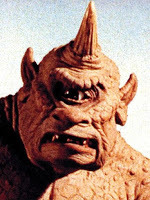 Or:
Or:“I absolutely agree that that Sinbad film where the cyclops comes out of the cave is one of Harryhausen’s best. Which reminds me, the main villain in my new short story has only got one eye …”
I’m not saying that there can’t be a bit of that online. Especially, for example, if it’s your own blog. I mean there surely isn’t much that anyone can complain about there (is there? … please say ‘no’). But repeated and painfully obvious self-promotion is going to make you a person of much less interest than someone who talks entertainingly about things other than him or herself: other books you’ve read, for example, other movies you’ve seen, places you’ve visited that have nothing whatsoever to do with whatever you’re currently working on, etc.
Okay, maybe a bit of authorial analysis is permissible now and then. That’s only natural. But the trick, I genuinely believe, is to make yourself a pleasing personality who says so many thought-provoking things that those who don’t already know you will be encouraged to come back for more, eventually finding their way to your books under their own steam.
It still sounds mercenary. But publicisation of self is a big thing online. Many of us seek to expand the world’s awareness of our existence. So, it isn’t purely a thing that writers get involved with.
Okay, that’s one way we can usefully fill our so-called downtime. But what about these other projects I mentioned? What about stuff that might actually earn us a crust or two? Well, as I said, I always try to have a few of these on the go in some shape or other.
Short stories
I was once reasonably well known for my short stories, most of them horror, but that was when I had a day-job and wasn’t so eager to make a living from writing. I hate saying this, really, because it almost sounds demeaning of short-form fiction, which I would never do willingly, but unfortunately there have been very few of us, certainly in modern times, who’ve been able to live purely off the proceeds of short stories, or even novellas.
The short story market, particularly when it comes to genre writing, is dominated at present by the independent press, who while they tend to pay well these days and bring out great-looking products, only publish anthologies now and then. Alas, the major publishing houses, at least in the UK, don’t seem to want to know about the short form in a way that would make it viable for us to churn submissions out nine till five. There are genre magazines and websites who will also buy short stories, but you’ll still struggle to make a living from this alone.
However, that doesn’t mean I don’t write them. I don’t write as many as I used to, but I’m penning many more now than I was a couple of years ago, first of all because I love doing it so much that, when purely concentrating on novels, I’d begun to feel that I was neglecting a certain type of artistic output that had always satisfied me emotionally. In addition, I was worried that my name was being forgotten in those other corners of the writing world where once I was so active.
There are other reasons too why short stories are a good option. I personally consider short-form fiction an essential training ground. It teaches us to produce crisp, succinct text, and to say much more in much less. We’re none of us the finished article. Continuing to write when you’re between books should be the natural way of things, in my view, if you want to keep refining your craft. It’s also nice to pepper those barren stretches between novels with further publication credits.
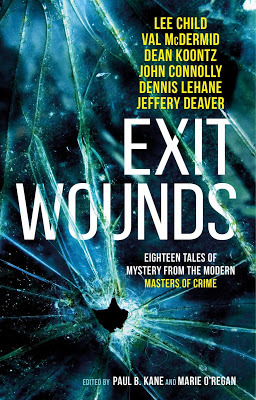 My recent personal experience of this is fairly illustrative, I think. My last book, STOLEN, was out in May 2019. My next one, the title of which I still can’t give you, is due in August this year. That’s a 13-month hiatus, which is a long time to be off the bookshelves. However, by making use of editing breaks, my stories The New Lad and Mr Kipper have appeared in
EXIT WOUNDS
and
TROUBLE AND STRIFE
respectively during that time, while between now and August I’ll also be appearing as follows: What Did You See? in
THE ALCHEMY PRESS BOOK OF HORRORS 2
, and Branch Line in AFTER SUNDOWN.
My recent personal experience of this is fairly illustrative, I think. My last book, STOLEN, was out in May 2019. My next one, the title of which I still can’t give you, is due in August this year. That’s a 13-month hiatus, which is a long time to be off the bookshelves. However, by making use of editing breaks, my stories The New Lad and Mr Kipper have appeared in
EXIT WOUNDS
and
TROUBLE AND STRIFE
respectively during that time, while between now and August I’ll also be appearing as follows: What Did You See? in
THE ALCHEMY PRESS BOOK OF HORRORS 2
, and Branch Line in AFTER SUNDOWN.And yes, these extra credits, small though they are, pay you in real cash-money. So in all kinds of ways it makes sense to go out and chase them.
 Other novels
Other novelsOkay, everyone … go on, admit it. You’ve all got a novel or two in the cupboard that you’ve never felt was ready to send out. You’ve all got something half-written that you never seem to find the time to get around to finishing. You’ve all got a thick file of ideas for novels of a type that none of the major houses currently seem to be buying and yet which you feel in your bones would rock the literary world if you could only get around to writing them.
Well, for me, breaks between contracted novels are the perfect time to resurrect these speculative projects and throw yourself into them with gusto. I know that it never feels the same when you’re writing something on spec, when you come wearily to the end of the working day and instead of feeling that you’ve done a real job for which you’ll rightly be rewarded, it simply bugs you that you’ve spent tiresome hours hammering something out that no one ever asked for and no editor may ever see, let alone a reader.
But if you have a professional attitude when it comes to writing, you’ll recognise it as a gamble that is probably worth taking. It’s an obvious comment to make, but a piece of written work is so much more saleable when it’s actually been written and isn’t just an idea.
 So, my opinion is get the damn thing finished. Even if you only do it in fits and starts, even if it’s currently ages off completion, why not use these breaks to advance the project to a point where you can start showing it around? It’d be a nice thought, wouldn’t it, that while you’re doing everything your contract requires, writing and editing a series of crime novels for example, at the same time you have written something completely different (romance, horror, historical, who knows?), thereby adding a completely new string to your bow, which could go on to attract a whole new audience to your work?
So, my opinion is get the damn thing finished. Even if you only do it in fits and starts, even if it’s currently ages off completion, why not use these breaks to advance the project to a point where you can start showing it around? It’d be a nice thought, wouldn’t it, that while you’re doing everything your contract requires, writing and editing a series of crime novels for example, at the same time you have written something completely different (romance, horror, historical, who knows?), thereby adding a completely new string to your bow, which could go on to attract a whole new audience to your work? Another alternative, of course, if you’re already contracted to write further books after the one you’re currently waiting a response on, is that now might be a good time to start drawing them up. This is a potentially more problematic use of your downtime, because your publishers may want you to discuss these future books in detail with your editor first, and it’s highly probable that for the time being, he/she would rather focus on the one at hand. In that case, I wouldn’t recommend that you get cracking, because whatever you’ve got in mind may from the very word ‘go’ be the opposite of what they’ll be looking for. That said, you may have an arrangement wherein you have a much freer hand, in which case go for it. Again, wouldn’t it be nice if the first book in the contract is done and dusted and your editor greenlights you to start on the next one, and that is already close to completion?
Me? I’m half and half on this. There’s a book I really want to write, which may or may not become part of my current contract. I’ve not even got around to having that discussion yet. But hell, I’ve still started writing it. Somewhere down the line, I feel I’ll be able to make use of it. Maybe sooner rather than later, but if it’s later, it won’t be the end of the world.
Back catalogue
So many of the authors I know have been ploughing this furrow for at least the last two decades or more. It can be a thankless career at times, because so much of the material you’ve slaved over never hits paydirt, in fact is never even read by anyone. But you know what? It’s all still there and we should never regard it as a wasted effort. On top of all that, there is the material you wrote that did find a publishing home first time around, but which is now out of print and has slipped from memory.
To my mind there is absolutely no reason why you shouldn’t, first of all, retrieve all your work from that second category, dust it off and select those items that may still have legs (and which you still own, of course). And when you do, why not put it out again, yourself if necessary? It’s not expensive to produce an ebook. It’s not even that expensive to produce a paperback. I should say at this point that I’m not advocating self-publishing. If you want to go that way from the start, that’s fine; it’s up to you. My view is that it will prove a tricky road.
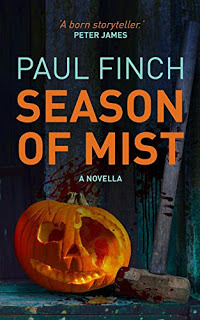 But if the work you’re proposing to republish has already been through the hands of an editor once, and therefore has been thoroughly policed, then I can’t see an ethical issue. You may well have a new readership who didn’t know anything about your earlier works, who will now be delighted to gobble them up.
But if the work you’re proposing to republish has already been through the hands of an editor once, and therefore has been thoroughly policed, then I can’t see an ethical issue. You may well have a new readership who didn’t know anything about your earlier works, who will now be delighted to gobble them up.I have no shame about this, myself. Last year I put out a novella, SEASON OF MIST, in time for Halloween. It had previously been published as part of my third AshTree Press collection, WALKERS IN THE DARK , in 2010. I’ve also got hundreds of short stories that were published in previous decades, which I’m now going through with a fine-tooth comb, looking to pull out those gems that I can reissue in brand new collections.
All that said, I’d be in less of a hurry to self-publish stuff that was rejected back in the past. Only do this, I think, if you’re willing to give it a good going over and are prepared to work out what went wrong the first time. I suspect that any author, even a real high-flier, would leave a bitter taste in his/her readership’s mouth if they dredged up their earlier failed efforts and just put them out there again without having done anything to fix them.
Movies, TV, stage-plays etc
The other good thing about having an extensive back-catalogue is that you can raid it for ideas as well, and when it comes to this, nothing should be off-limits, even the stuff that didn’t sell, because there’s nothing to say that those ideas weren’t great in themselves and that the problem lay with the execution.
So, what exactly do I mean by ‘raiding for ideas’?
Well, every movie that gets made is based on an idea that someone pitched, an original and thrilling concept that was usually extrapolated in a few concise sentences.
 Now, bear in mind that there’s no copyright on ideas. So, you have to be careful just chucking things out there. But again, if you’re prepared to take the time to work your way through your mountain of good stuff, selecting those bits and bobs that you feel can fly in a different medium, why not use your breaks between novels to do some development work on them, to create professional standard treatments that you can send out as potential film or TV (or even stage) projects?
Now, bear in mind that there’s no copyright on ideas. So, you have to be careful just chucking things out there. But again, if you’re prepared to take the time to work your way through your mountain of good stuff, selecting those bits and bobs that you feel can fly in a different medium, why not use your breaks between novels to do some development work on them, to create professional standard treatments that you can send out as potential film or TV (or even stage) projects?In case you’re wondering, I’ve not got the time and/or space here to lay out the ‘cannot fail’ treatment. First of all, there’s no such thing. But secondly, there are lots of resources online where you can look up the necessary advice. It wouldn’t do any harm, though, if you’ve got quite a lot of spare time between books to not just knock out a treatment, but maybe to write a first draft script as well. Again, it’s the law of having something real to sell rather than something as yet imaginary.
I’ll now be honest. The chances of this bearing fruit are slim. There are independent production companies everywhere (especially online) and though we now have more entertainment platforms than ever before, seemingly producing a floodtide of high-quality drama, the competition has never been fiercer. You won’t just need to do an incredible job pulling this thing together, you’ll then need to be lucky enough to hit someone who has the time and inclination to read it, the interest and nouse to take it further than that, and the money to make it happen. And that’s a rare combination.
But then again, as I’ve said repeatedly, if you don’t try you’ll never know. You’ve got to be in it to win it. And the alternative may be putting your feet up between paying projects and watching daytime TV for several weeks. Surely, when I put it in those terms it’s a no-brainer?
So, there we go. Some quickfire thoughts on what we writers do or could (and maybe should) do between publications. I guess, in simple terms, it’s just about expanding your repertoire, attacking on multiple fronts, throwing as much mud at the wall as you can. Any of these metaphors will do, and most of them probably get closer to the point more quickly than I have in this column.
Even then, they’re only thoughts. Feel free to take note, to ignore, or to spew out your scorn and indignation, though hopefully, if you’ve read down to this point, you won’t be feeling the latter.More thoughts on this in further blogs, as (or if) they occur to me. Speak soon.
THRILLERS, CHILLERS, SHOCKERS AND KILLERS …
An ongoing series of reviews of dark fiction (crime, thriller, horror and sci-fi) – both old and new – that I have recently read and enjoyed. I’ll endeavour to keep the SPOILERS to a minimum; there will certainly be no given-away denouements or exposed twists-in-the-tail, but by the definition of the word ‘review’, I’m going to be talking about these books in more than just thumbnail detail, extolling the aspects that I particularly enjoyed … so I guess if you’d rather not know anything at all about these pieces of work in advance of reading them yourself, then these particular posts will not be your thing.
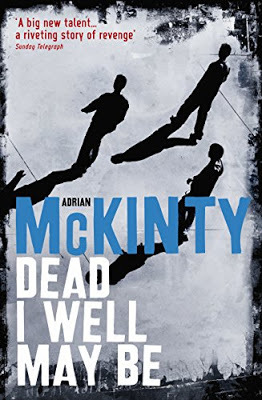 DEAD I WELL MAY BE
by Adrian McKinty (2003)
DEAD I WELL MAY BE
by Adrian McKinty (2003)
It’s the early 1990s and the Good Friday Agreement has not yet been signed, so Northern Ireland is beset by the Troubles. When ex-soldier and low-level Belfast hoodlum, Michael Forsythe, is caught working at the same time as claiming Unemployment Benefit, he faces prosecution or a lifetime without Government assistance. Neither option looks promising, so instead, he accepts an offer to enter the US as an illegal immigrant and work in New York City for Darkey White, a gangster of Irish lineage, who is looking to recruit new men with which he can fill in the gaps left after the collapse of the New York Mafia.
At first glance, Forsythe’s experience of life isn’t greatly improved. He seems to have exchanged one tough neighbourhood for another, lives in a shabby, roach-infested apartment, and is one of the few white faces on his block, which means that he is regarded with suspicion and hostility by all those around him. Meanwhile, Darkey’s gang is relatively small, and their turf located in Harlem and the Bronx, where there are rival crews of many ethnicities who are constantly trying to wrest power from them – so the Irish boys need to be ever-vigilant.
For all that, Forsythe doesn’t have much love for his new accomplices. Darkey, himself a lieutenant for overarching Irish kingpin, ‘Mr Duffy’, and Sunshine, his number two, are old-stagers, traditional dockland bruisers, proud of their Celtic heritage though neither of them has ever visited the Old Country and both are now getting old. Immediately above Forsythe is Scotchy, a ‘fellow Mick’ and a guy full of tall tales and foul-mouthed tantrums, while the others, though more than willing to use violence, are slow, dull-witted and mostly boring. When not on duty, they spend their time hanging out and drinking, though there are limits to how much fun they can glean even from this, as all consider that they are very underpaid and yet are so grateful just to have a job that they do nothing about it.
In the midst of this uninspiring crew, Forsythe is emerging as an unofficial leader. But perhaps his natural boldness is going to be his undoing. He’s only twenty years old, and though he served in the British Army, it was for a short time, most of which he spent locked up for striking an officer. So, despite his intellect and his ruthless streak, both of which serve him well, maybe a more experienced and prudent guy would not opt to start filling his long, depressing days by courting the beautiful redhead, Bridget, who also happens to be Darkey’s girlfriend. In due course, Bridget succumbs to Forsythe’s charms – he’s a handsome lad with a cheeky sense of humour, as well as being a psychopath – and they commence a clandestine affair. This is dangerous territory for both of them, but on the surface all goes well, especially when Forsythe avenges the severe beating of one of his crew by punishing the suspect with a ‘Belfast Sixpack’, a bullet in each ankle, each knee and each elbow. Darkey is so impressed by this that he talks airily of promoting young Mike, which earns the new lad the admiration and envy of his fellow gangsters, including Sunshine and Scotchy.
However, Forsythe is increasingly suspicious that Bridget is being followed by someone and that at some point their covert relationship will be discovered. He’s therefore relieved when another job comes along that will take him out of NYC altogether. It’s down in Mexico, where the boys are advised they can have a holiday once they’ve picked up some contraband for Darkey.
Assuming the cargo will be drugs, but not anticipating trouble as everything seems to have been well planned, Forsythe, Scotchy and a couple of other lags travel south. But once they’re in possession of the goods, they are ambushed in a Mexican police sting, which has clearly been in the offing for quite some time. Denied legal representation, denied even a trial, they are transported to a hellish, swamp-begirt prison on the Yucatán Peninsula, where they are shackled together, starved, beaten by both guards and fellow prisoners alike, and where it gradually comes to dawn on them that they have been condemned to a living death.
The weeks pass, their suffering only worsening, and Forsythe realises they are going to have to escape soon otherwise they won’t have the strength even to look through the window. A plan is thus put in motion, and an indescribably torturous ordeal follows, filled with pain, anguish and death. Only one thing keeps Forsythe going: the knowledge that someone back in New York decided to sacrifice the entire crew for who knows what reason, and that this someone is now going to face payback on an epic scale …
The first thing that struck me on reading Dead I Well May Be was how poetic it is. Adrian McKinty is a naturally talented author, and constructs singsong prose in his efforts to convey time and place. We get the most vivid portrayal of Belfast during the Troubles, followed in short order by the most vivid portrayal of uptown New York. We also get intricate depictions of day-to-day mob life, so much so that we readers feel sated with whiskey and cigarette smoke just flipping the pages.
The same applies to the main character here, Michael Forsythe, who as the narrative progresses is laid out for us in the most complex, multi-layered fashion.
Bit by bit, we assess this young man from almost every angle, soon understanding that though he’s intelligent and wide-read, he’s cynical and hardbitten beyond his tender years. He grew up in war-torn Ulster, after all, and has learned through his own experience that the gun is mightier than the pen, and that if the gun isn’t available, a club or fist will do just as well. When he first arrives in the Big Apple, he fully and willingly participates in the underworld conflicts of Darkey White, because while in an ideal world he might seek another way, he knows that it isn’t available here and that, at the end of the day, he has to get paid.
Forsythe is numb in various ways too; he is affable, reasonable and, when it suits him, pleasant. But he’s also cold. He lacks both charity and pity, and rarely empathises with anyone at more than a superficial level. You might argue that this is another natural trait of someone who’s never known peace, but it still makes him a mechanism rather than an actual person. Oh yes, the title of this novel, Dead I Well May Be , is just as applicable to its central character as it’s a reference to any of the events that may occur in this first installment of the Michael Forsythe trilogy (for the record, the two follow-ups are The Dead Yard and The Bloomsday Dead ).
The next thing that struck me about this novel was that it’s very much like two books banged into one. We have the slap-in-the-face portrait of day-to-day living in the grimy backstreets off the Shankhill Road, followed by the equally powerful picture of life on the fringes of society in the upper New York badlands, which then feeds into a warts-and-all analysis of life as an operational criminal in the heart of a teeming city. All of this is compelling enough in itself and is certainly the product of either real-life experience or some very intensive close-quarter research, or both. Then we have the ‘other book’ so to speak – the suspense aspect, because Dead I Well May Be is also a hard-as-nails revenge thriller.
I don’t want to say a lot about this part of it because I don’t want to give anything away about the second half of the novel, except to say that the full fury of a man betrayed is unleashed, though coldly, carefully, and not without shocking consequence. But at no stage in this latter period of the novel does McKinty’s renege on his style, hitting us with graceful, dreamy prose, scenic descriptive work and constant but never boring dollops of street-philosophy courtesy of the thinking man’s rogue that is Michael Forsythe. But the pace and tension are definitely upped, and suddenly we’re in much more familiar crime novel territory.
If I had any problem it was perhaps with a couple of the lesser characterisations. I never quite ‘got’ Bridget, who seems to be all things to all men for much of the novel, speaking with different voices depending on what scene she is in. That perhaps would be acceptable, but she then undergoes a bewildering metamorphosis near the end, which jars quite badly for me – though it’s a small complaint and it may well be resolved in the later sequels.
Aside from that, Dead I Well May Be works perfectly, the overall ‘compound’ of the novel making for an exhilarating if at times horrific read, which genre addicts as well as students of the literary school should lap up delightedly.
And now, as always, I’m going to try and cast Dead I Well May Be in anticipation of the inevitable film or TV series (especially as it sounds as if McKinty’s latest hit, The Chain , has already been optioned). Just a bit of fun, of course. Who’d listen to me anyway? But here we go:
Michael Forsythe – Jack ReynorBridget – Katie McGrath (doesn’t have a lot to do, but should add weight of character)Darkey White – Colin FarrellSunshine – Eoin MackenScotchy – Emmett J Scanlan
(The picture used at the top is lifted freely from The Independent. The photo of the unpublished novels was taken by Simon Petrol on Unsplash. The pic of the happy writer comes from Katherine Bolger Hyde’s blog and the lady buried in her slush pile from Claire King’s page. Any or all of these images will of course be taken down immediately if the original creators object to their use).
Published on February 04, 2020 02:58
January 2, 2020
Early yet but the schedule is already rolling
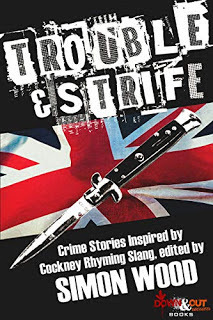 So, what am I going to be doing this year?
So, what am I going to be doing this year?
I suppose that’s something we’re all asking ourselves now that Christmas has passed and it’s suddenly January again. But in my case it mainly applies to the writing game. In other words, what am I going to be writing this year? What are my plans? What is due for publication, etc?
Well, in today’s blog, the first of 2020 – so Happy New Year, by the way! – I’ll endeavour to answer that question, though I’m sure you’ll understand if at this stage I can only give a thumbnail sketch of my schedule, which even then is likely to be full of holes because all kinds of opportunities may arise between now and next December; there are several irons in the fire that could flare to life at any moment – as soon as next week, even! – but let’s not get too excited about things that may also never happen.
In addition today, in keeping with the time of year – brrr! – I’ll be offering another of my detailed book reviews and discussions, focussing this week on Georges Simenon’s strange, bleak wartime crime novel, THE SNOW WAS DIRTY . This is not Maigret in case you were wondering, but a stand-alone and something of a classic, though it was very controversial at the time.
If you’re only here for the Simenon review, then by all means pop straight down to the Thrillers, Chillers section, which, as always, you’ll find at the lower end of today’s blogpost, and get stuck into it straight away. If, on the other hand, you’re interested in my writing exploits too, then stick around at this end for a bit.
2020 schedule
First off – in fact, very first off because, in truth, this one should have gone in at the end of last year rather than the start of this one – I’m making a short story appearance in the Michael Wood-edited, US-published crime anthology, TROUBLE AND STRIFE (see the image at the top).
This is a slightly unusual project considering that it has come from an American stable in that it focusses on Cockney rhyming slang. Every contributing author took a piece of that unique lingo and had to work a chilling story out of it. Mine was ‘Mr Kipper’, which of course is Cockney slang for ‘Jack the Ripper’. Needless to say, the whole thing completely caught my imagination, mainly because I saw in it an opportunity to write something that wasn’t just crime, but was also horror-ish, if such a word exists.
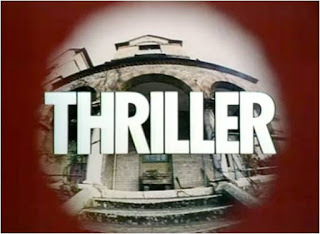 I always like to push my stories to the darkest edge permissible, and the idea I had for this one gave me a chance to try and evoke the unique atmosphere of
Thriller
. You may recall that wonderful British TV series of the early 1970s. It was helmed by television legend, the late, great Brian Clemens, and adopted an anthology format, each week presenting a different terrifying tale, and yet, as its title indicated, it didn’t go straight for the horror jugular – most of its episodes were concerned crime, though crime of the most murderous and chilling variety.
I always like to push my stories to the darkest edge permissible, and the idea I had for this one gave me a chance to try and evoke the unique atmosphere of
Thriller
. You may recall that wonderful British TV series of the early 1970s. It was helmed by television legend, the late, great Brian Clemens, and adopted an anthology format, each week presenting a different terrifying tale, and yet, as its title indicated, it didn’t go straight for the horror jugular – most of its episodes were concerned crime, though crime of the most murderous and chilling variety.But I won’t say anymore on this front at present. As usual, if you want know about TROUBLE AND STRIFE in detail, there’s only one thing to do ...
With that publication done and dusted, the rest of January is mercifully free of major events – thank Heaven. It’s always nice to have a fallow period now and then.
February and March are also unassigned, though already we’re far enough into the future for me to put question-marks against that assertion, because, as I’ve already mentioned, you never know what unforeseen opportunities may arise.
This brings us to April, at which point everything starts kicking off big time.
To start with, I’ll be at STOKERCON in Scarborough, April 16-19. For the uninitiated, this is a huge international horror convention, which usually is located in the States, though it’s over here this year, and as it hosts the annual Bram Stoker Awards, is the main social event of the year for the Horror Writers Association. Anyone attending – and you don’t have to be a practitioner, you can also be a fan – can look forward to a packed weekend of panel discussions, interviews, workshops, book launches, readings, and of course the colossal horror bazaar that is the dealers’ room.
 Hopefully, I won’t just be there as a punter. I may find my way onto a panel or two, plus a new short story of mine,
What Did You See?
, is included in the
ALCHEMY PRESS BOOK OF HORRORS #2
, which will be one of many new titles launched at the grand event. Occasions like this only visit British shores rarely, so no one who’s into the horror genre can afford to pass this one up.
Hopefully, I won’t just be there as a punter. I may find my way onto a panel or two, plus a new short story of mine,
What Did You See?
, is included in the
ALCHEMY PRESS BOOK OF HORRORS #2
, which will be one of many new titles launched at the grand event. Occasions like this only visit British shores rarely, so no one who’s into the horror genre can afford to pass this one up.May is a free month thus far, but the same warning applies as before. Who knows what may crop up before then? (May is invariably a busy time in the industry, so it’s impossible to imagine that something won’t come along to fill this gap).
Things then get going again in June, for what’s looking like it will be a frenetic summer.
 June 4-7, I’ll be at the international crime fiction convention,
CRIMEFEST
, in Bristol, ‘where the pen is bloodier than the sword’, where I’m on a panel and will be rubbing shoulders with a host of crime and thriller writers both great and small (over 100 guarantee to attend so far!). There will be at least 40 panels, the usual wide range of workshops, and the ever-popular ‘pitch an agent’ session, plus a welter of bar-side activity. This is one of the key events in the crime-writing game, and another opportunity that all hopefuls should grasp with both hands.
June 4-7, I’ll be at the international crime fiction convention,
CRIMEFEST
, in Bristol, ‘where the pen is bloodier than the sword’, where I’m on a panel and will be rubbing shoulders with a host of crime and thriller writers both great and small (over 100 guarantee to attend so far!). There will be at least 40 panels, the usual wide range of workshops, and the ever-popular ‘pitch an agent’ session, plus a welter of bar-side activity. This is one of the key events in the crime-writing game, and another opportunity that all hopefuls should grasp with both hands.Come July, we’re still on the crime-writing front, and this is a truly massive one.
The THEAKSTON OLD PECULIER CRIME WRITING FESTIVAL , now in its 17th year, again returns to the Old Swan Hotel, Harrogate, July 23-26. I’ll be there, as always, enjoying and hopefully participating usefully in what is now a regular event in the literary calendar, and a convention that celebrates the very best in crime fiction.
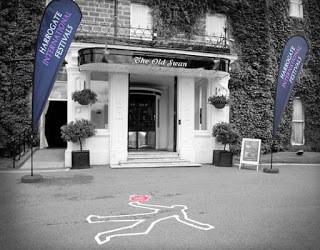 As always, it will boast an incredible array of special guests (though near enough all those writers who regularly attend have impressive back-catalogues and big sales, so it’s a must-visit for readers who simply want their books signed) and a line-up of panels that should wow any crime fan. Seriously, this one is worth going to just for the action in the beer tent (which, for anyone in doubt, is where I’ll be found most of the time).
As always, it will boast an incredible array of special guests (though near enough all those writers who regularly attend have impressive back-catalogues and big sales, so it’s a must-visit for readers who simply want their books signed) and a line-up of panels that should wow any crime fan. Seriously, this one is worth going to just for the action in the beer tent (which, for anyone in doubt, is where I’ll be found most of the time).This brings us to August, which will be by far the biggest month of 2020 for me personally.
It will see the publication of my first novel from Orion. I’m still not in a position where I can talk much about it. For example, I can’t tell you the title yet, or the actual date when it hits the shelves, though I can let it out that it’s a freestanding hardboiled cop thriller set in the south of England, in a deceptively leafy corner of the country where what initially looks like a simple road-crash leads to a explosion of underworld violence and retribution and the unearthing of a conspiracy that has the potential to rock the Metropolitan Police, and maybe the entire country, to its foundations.
But more about that soon, when the publicity embargo is lifted. On top of all that, any plans we devise to have a launch party will be posted on here at the first opportunity.
This brings us onto September, and next autumn, so now we’re seriously getting ahead of ourselves in terms of certainties.
There are two more major literary events that month. BLOODY SCOTLAND , which is Scotland’s International Crime Writing Festival, held annually in the grand old city of Stirling, is likely the first. I have no actual dates for this one yet, though doubtless they’ll be announced imminently. Additionally, there is FANTASYCON , the annual convention of the British Fantasy Society, which this year is in Holloway, North London, from September 25-27. Sadly, I can’t guarantee that I’ll be at either of these exciting events just yet. I mean, there are lots and lots of reasons for crime, thriller, horror and fantasy readers to attend both of them whether I’m there or not (and I am hoping to be!), but both are a little far into the future for me to give any guarantees at this point.
The same applies in October to CAPITAL CRIME , which is held at the Grand Connaught Rooms, London, from Oct 1-3. This is a relatively new event – 2020 will be only its third year – but it has already proved a big draw for some of the world’s leading crime and thriller authors and filmmakers. Make no mistake, this is already an impressive and large-scale event, and it’s getting bigger each year. I am strongly hopeful that I’ll be attending this one.
After all this, I’d like to say that November and December will be quiet, but even this early in the year, I have big plans for the last two months of 2020. Basically – and this is an ambition rather than a promise, though I think it’s a realistic one – I intend to bring out three Christmas books in time for the festive season. Partly, this is due to the remarkable response to my short story THE MERRY MAKERS , which I posted on this blog on December 17, and which was read an incredible 800+ times in the first few days (so, thanks to everyone for that).
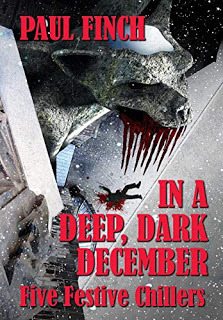 It’s certainly made me realise that there’s an appetite for Christmas spookiness in the weeks leading up to the big day.
It’s certainly made me realise that there’s an appetite for Christmas spookiness in the weeks leading up to the big day.Clearly, I need to get as many of my Christmas ghost and horror stories out there as I can. I’ll thus be publishing re-releases of IN A DEEP, DARK DECEMBER , my e-collection of festive chillers, and SPARROWHAWK , my Victorian era Christmas e-novella, but this time in paperback and (hopefully) Audible format as well. In addition to that, I intend to bring out a band-new festive ghost story collection, THE CHRISTMAS YOU DESERVE, with any luck both electronically and in paperback.
As I say, these November/December plans are aspirations at this point rather than absolute certainties, but with a bit of luck, I see no reason why we can’t make them real.
Not that I expect anyone to be awaiting next Christmas with bated breath just yet – not in January. We’ve all got lots of other stuff to get through first. Just remember that as soon as I have updates about any of these plans, or any others I may hatch in the days and weeks ahead, you’ll find them on here first.
THRILLERS, CHILLERS, SHOCKERS AND KILLERS …
An ongoing series of reviews of dark fiction (crime, thriller, horror and sci-fi) – both old and new – that I have recently read and enjoyed. I’ll endeavour to keep the SPOILERS to a minimum; there will certainly be no given-away denouements or exposed twists-in-the-tail, but by the definition of the word ‘review’, I’m going to be talking about these books in more than just thumbnail detail, extolling the aspects that I particularly enjoyed … so I guess if you’d rather not know anything at all about these pieces of work in advance of reading them yourself, then these particular posts will not be your thing.
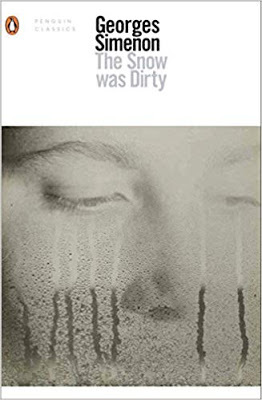 THE SNOW WAS DIRTY by Georges Simenon (1948)
THE SNOW WAS DIRTY by Georges Simenon (1948)Occupied Europe in the 1940s during a bitter winter.
Well … I say occupied Europe, but in truth none of that is actually specified. All we know – all we ever know – is that we are in a Northern European city somewhere, living under the heel of a brutal military power. We could be somewhere in France or Belgium under the Nazi yoke, or perhaps the author is pre-empting the events shortly due in East Germany, where the Soviet Bloc would establish the German Democratic Republic (Frank Friedmaier is certainly a German-sounding name, as are several others in here, while the Gestapo-like methods employed by the occupiers would be just as believable in the hands of the Soviets and their lackeys).
Either way, the central character in this tale is Frank. A sociopathic teenager, aimless, immoral and utterly without conscience. He’s a petty criminal, we see that from the outset, but he’s more an opportunist than an out-and-out predator, and his motivations are often difficult to fathom.
He lives in a brothel, which is run by his mother, Lotte, who, along with the girls who work for her, pampers him ridiculously. Because this house of ill repute specifically services officers from the occupying force, fuel and food rationing don’t exist for the Freidmaiers – Frank even secures an ‘access all areas’ green card for himself – which is one extra reason for everyone in the outside world, particularly in the soulless apartment block where it is located, to despise them even more. But Frank and his mother don’t care.
Frank particularly doesn’t, at least on the surface. Only two things in life interest him: Sissy, the attractive but innocent daughter of a hardworking, upstanding neighbour, Gerhardt Holst, and his mission to impress a local small-time gangster and murderer called Kromer.
When Kromer, who views Frank as a promising up-and-comer, and someone whose connections through the brothel might be useful, lends the youngster a knife, Frank, almost on a whim, lies in wait for a member of the occupying force, and for no real reason – other than that he wants to know what it is like (and to see if he can live with himself afterwards) – stabs him to death. It turns out to be easy and straightforward, and even though the fatal act is witnessed by Holst, Frank is not worried. Such is his steely arrogance (and the immense privilege he has always enjoyed, which he has never earned) that he feels bulletproof in this wintry, downtrodden city, where the controlling authority seems distant and omnipotent, where the ordinary folk are tired, hungry and dispirited, and where the black-marketeers wield godlike powers. His response to those who don’t like his mother – those like Holst, he imagines, though Holst never speaks to him or to Lotte – is to challenge them with this brazenly lawless and unconcerned attitude.
Once again, Holst neither says nor does anything, and Frank continues on his reckless way, committing one criminal act after another, murdering for a second time during a robbery, and regularly handling stolen goods. Meanwhile, his fascination with Holst grows. Why did the guy not snitch on him? Why does Holst never even register Frank’s existence in the building where they live together?
It’s not just the case that Frank feels slighted by this … he is unconsciously cowed by it. Maybe there is something in Holst – his conscientious, industrious nature, his law-abiding attitude, his stolid response to the occupation of his homeland – that Frank secretly admires. Is Holst the father figure Frank has always needed? Is he the positive male role-model that Frank never had? Either way, Frank resents this, but because he can’t bring himself to actually confront Holst, he switches his attention to Holst’s daughter, Sissy.
A sweet child, she has long had a crush on Frank, and when he shows interest in her, she is amazed and flattered. They go on a couple of dates, during which, though they become amorous – Frank is very aroused and Sissy very compliant – they never actually consummate things, and the girl remains a virgin.
This, Frank realises, is something he can use to get back at Holst. To get back at the whole world, which, though he constantly flashes his money and his green card to it, seems hellbent on either treating him like a rodent, or worst still, ignoring him.
So, Frank makes a plan for Sissy.
A very nasty plan indeed. And though he is certain that he will get away with it, even though he’ll make no attempt in the process to cover up his own involvement, he has no clue that it will be the catalyst to a series of events that will bring down his odious little world in the most dreadful and complete way imaginable …
Even by the standards of Georges Simenon’s other romans durs, or ‘tough novels’, The Snow Was Dirty is something of a curiosity. You may recall that Belgian author, Simenon, was most famous for his series of Maigret stories, which were very much police procedurals set in post-war Paris. In short, these were intelligent, excellently (and sparsely) written, tightly-plotted good v evil capers of the old school, which were so satisfying to crime buffs that they are still widely read today and regularly adapted for television. In contrast, the romans durs were significantly darker forays into European Noir, in which much more ambiguous protagonists wend their way through grimy, crime-infested cities where justice does not always prevail.
But as I say, even in this company, The Snow Was Dirty is a notably disconcerting tale.
I’ve read it twice now, and though I’m still not certain it merits its ‘absolute classic’ status, I still find it disturbing and thought-provoking.
Everything about this new version, which has been very ably translated into English by Howard Curtis, initially appears to be straightforward. We’re immediately among people who are up to no good – the criminal classes of a city under occupation. We meet one criminal antihero in particular, Frank, who’s main aspiration – seemingly – is to win over the local gang-bosses with his daredevil approach to villainy.
So far so good. Looks like we’re in for a traditional urban thriller, perhaps with a wartime background to add flavour. But that doesn’t last for long.
Meanwhile, other things are going on just below the surface. To start with, Simenon’s succinct style is deceptively simple.
The authentic squalor of the post-war city is all there, even if the author doesn’t spend a great deal of time describing it, while the weary, hungry and impoverished wreckage of the town’s populace are completely visible to us, and feel very real indeed, even though we don’t meet many of them. There is huge skill in that alone.
Likewise, we don’t see much in the way of violence. Simenon purposely keeps it off the page, even though it happens all the time: early on, when local hoodlums (like Frank) commit atrocities seemingly at a whim, and particularly near the end, when one firing squad after another dispatches suspects of every hue. And yet, even though we rarely witness it, we completely buy into the conceit that, since the occupying force took over, the criminals are not only seedier now, but deadlier than they ever were before; it really doesn’t pay to get caught in the act or snitched on in this world, and so killing anyone who looks at you the wrong way is usually the preferred action. At the same time, of course, the victorious enemy (who remain unnamed right to the end of the book) are the ultimate bad guys, so completely in charge that they can mete out the most brutal punishments merely on suspicion and won’t bat an eyelid in the process.
In truth, this is hardly the environment in which you’d expect to find an angry young man. In the late 1950s, the likes of Jimmy Porter and Arthur Seaton were much safer thumbing their noses at the conventions of western capitalism than Frank Friedmaier is at the iron fist of a military dictatorship. Nevertheless, that is the vibe we get here, our central character a sulky, egocentric loner whose spirit refuses to be broken as he throws out one rash challenge after another, and yet who is surely smart enough to know that at some point this recklessness will result in his destruction.
You’re some distance into the book before you realise that it’s this weird psychology that Georges Simenon is actually examining rather than the crime story, which in itself is rather banal and low-key. But even then, his conclusions, such as they are, are the opposite of uplifting.
Frank is an amoral killer, but at the heart of it, he’s also a silly child. The naughty boy at the back of the class who’d rather do bad things and get in trouble than be ignored. He hates the fact that people are unimpressed by his green card. He hates the fact that his ‘daring’ criminality has flown under the radar for so long. He hates the fact that Holst responds to the abuse of his daughter by pointedly ignoring him, the perpetrator. And his loyalties and soaring self-confidence are absurdly illogical, to the point of being dangerous – even Timo, the fence, recognises this and eventually takes against Frank. Later on, when faced with the ‘Old Man’ – a prototype Gestapo interrogator, who clearly has all the time in the world – the cocky youngster treats it as a bizarre kind of game, certain that at some point he’ll have proved so problematic that he’ll be taken to the very top floor (or is he certain of this?; is it yet more bravado? … and there’s another question: where does arrogance end and self-loathing begin?).
But I won’t say too much more about this compelling and consciously disheartening subtext for fear of spoiling the book, which as it only runs to a lean 290 pages is a trip that all literary types should take at some point (you’ll not find it a happy read, but you’ll still be engrossed).
Suffice to say that Georges Simenon wrote The Snow Was Dirty not as a form of entertainment but as an observation. It’s been called ‘a study of the human condition’. I would argue that it’s actually a study of a certain kind of human condition, one which the rest of us, if we value a functioning society, should discourage at every opportunity.
I can’t work out whether or not The Snow Was Dirty has ever been adapted on film. It’s certainly never been adapted in English, and so, as usual at the end of one of my reviews, I’m now going to seek to put that right. Here are the cast I would choose should it ever get the celluloid treatment. Just a bit of fun this, of course, though casting directors should ignore my advice at their peril:
Frank Friedmaier – Alex PettyferHolst – Timothy WestSissy – Georgie HenleyLotte – Michelle FairleyKromer – Alfred MolinaThe Old Man – Timothy Dalton
Published on January 02, 2020 07:00



